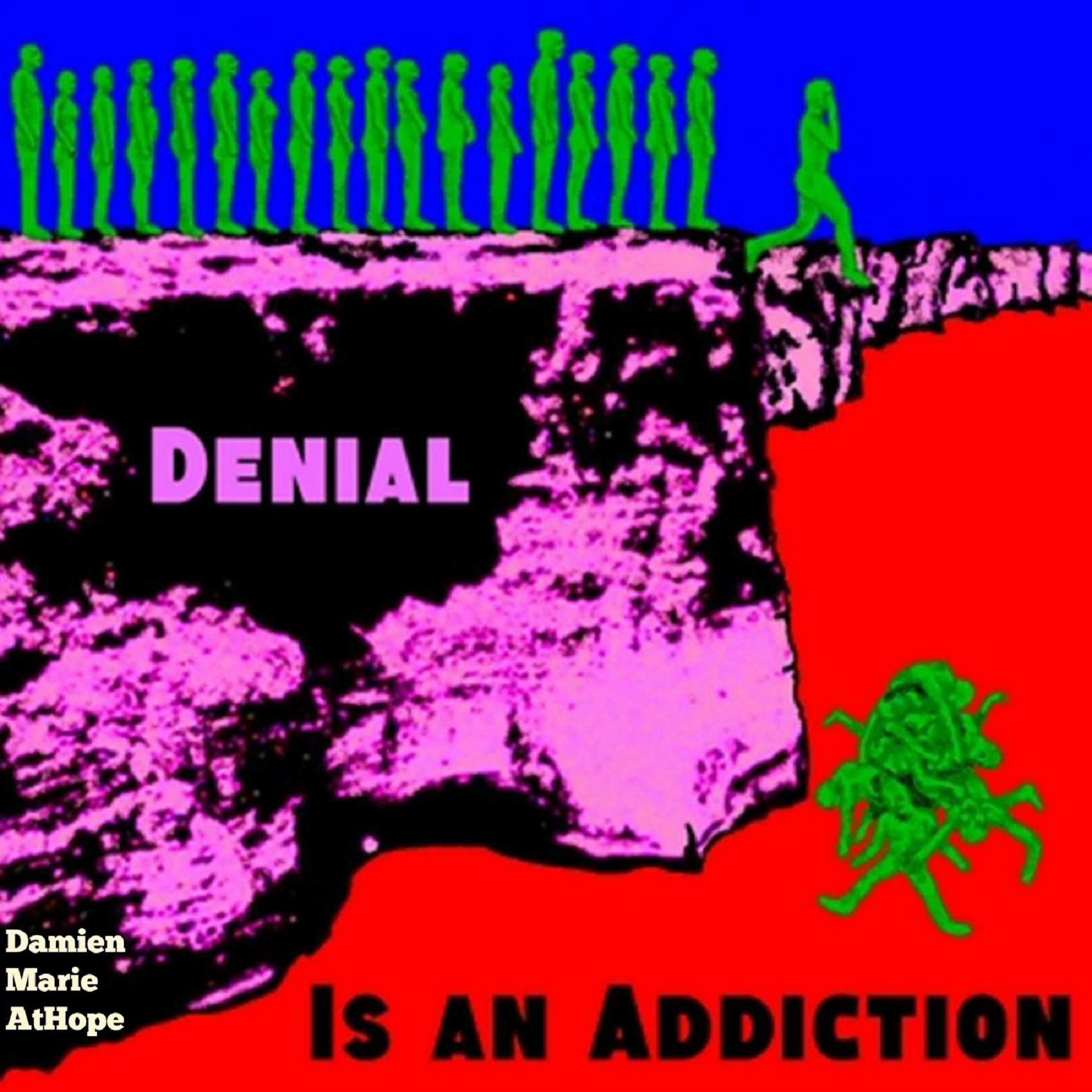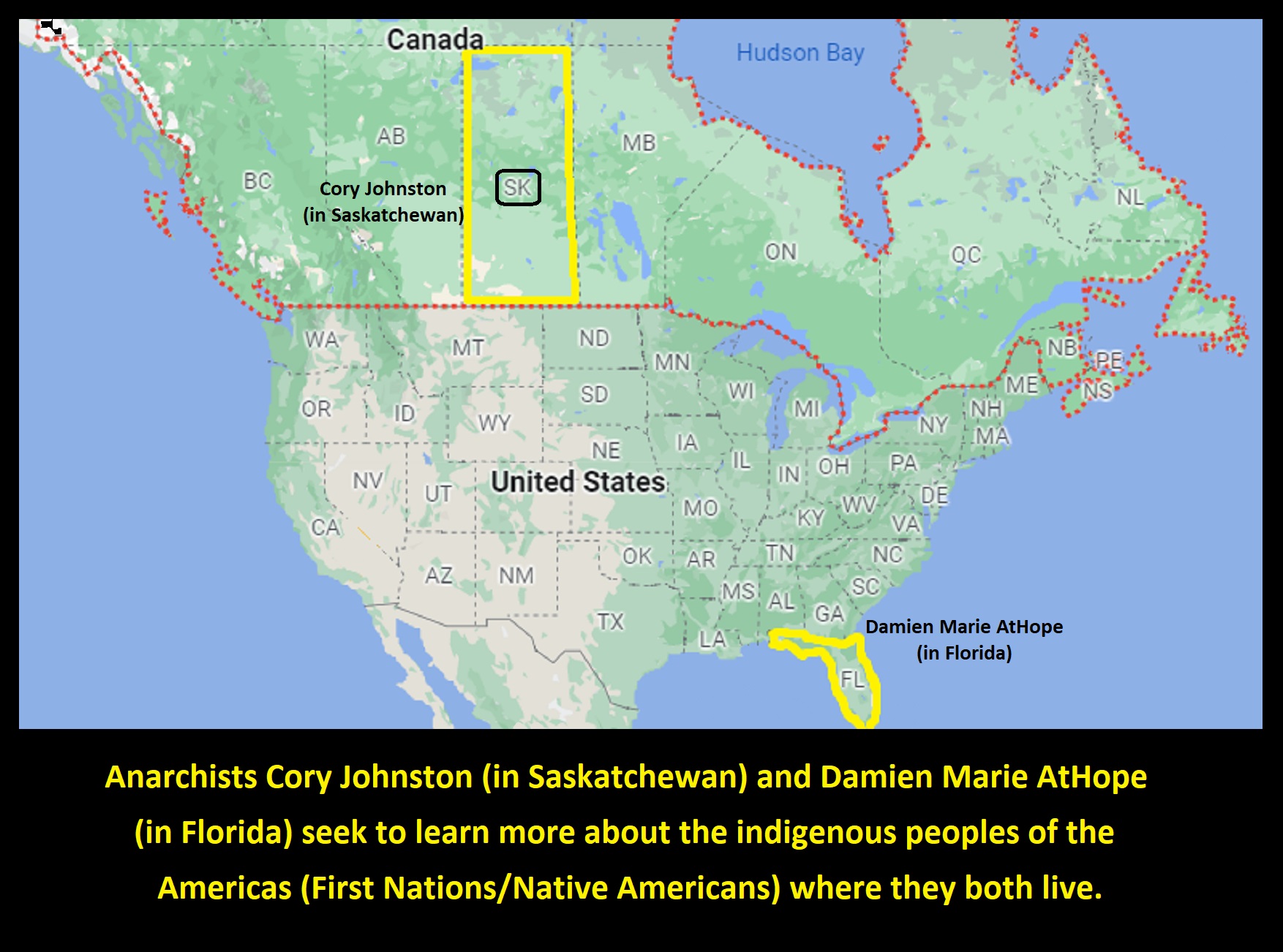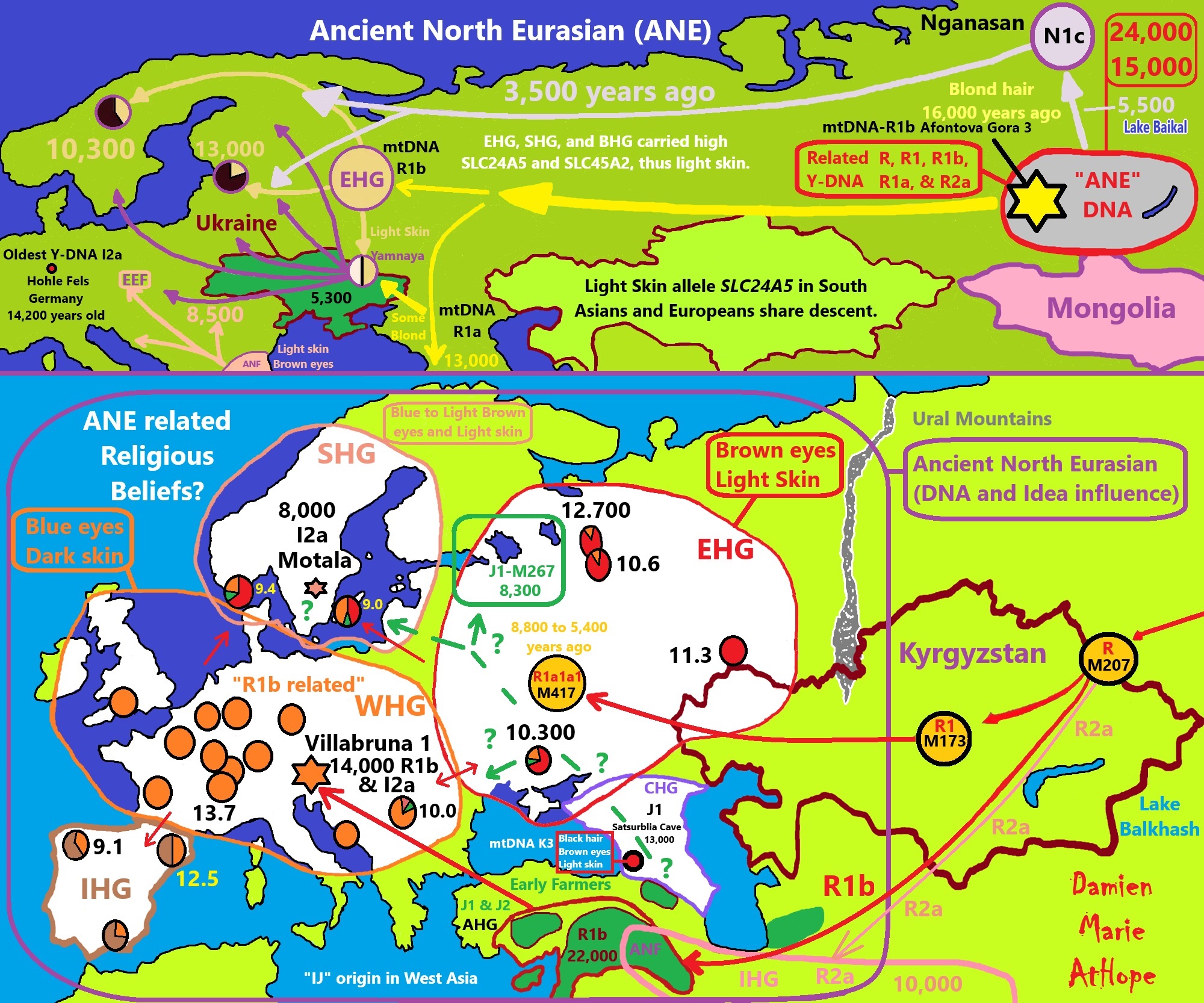
ref, ref, ref, ref, ref, ref, ref, ref, ref, ref, ref, ref, ref, ref, ref, ref, ref, ref, ref, ref, ref, ref, ref, ref, ref, ref, ref, ref, ref
Genetic Relations to Ancient North Eurasians (ANE):
Eastern hunter-gatherer (EHG)
Caucasus hunter-gatherer (CHG)
Zagros/Iranian Hunter-Gatherer (IHG)
Iranian Neolithic Farmers (INF)
Anatolian hunter-gatherer (AHG)
Anatolian Neolithic Farmers (ANF)
Early European Farmers (EEF)
Yamnaya/Steppe Herders (WSH)
Villabruna 1 (burial)/Ripari Villabruna rock shelter in northern Italy (14,000 years old)
Satsurblia Cave (burial) in the Country of Georgia (13,000 years old)
Motala (burial) (8,000 years old)
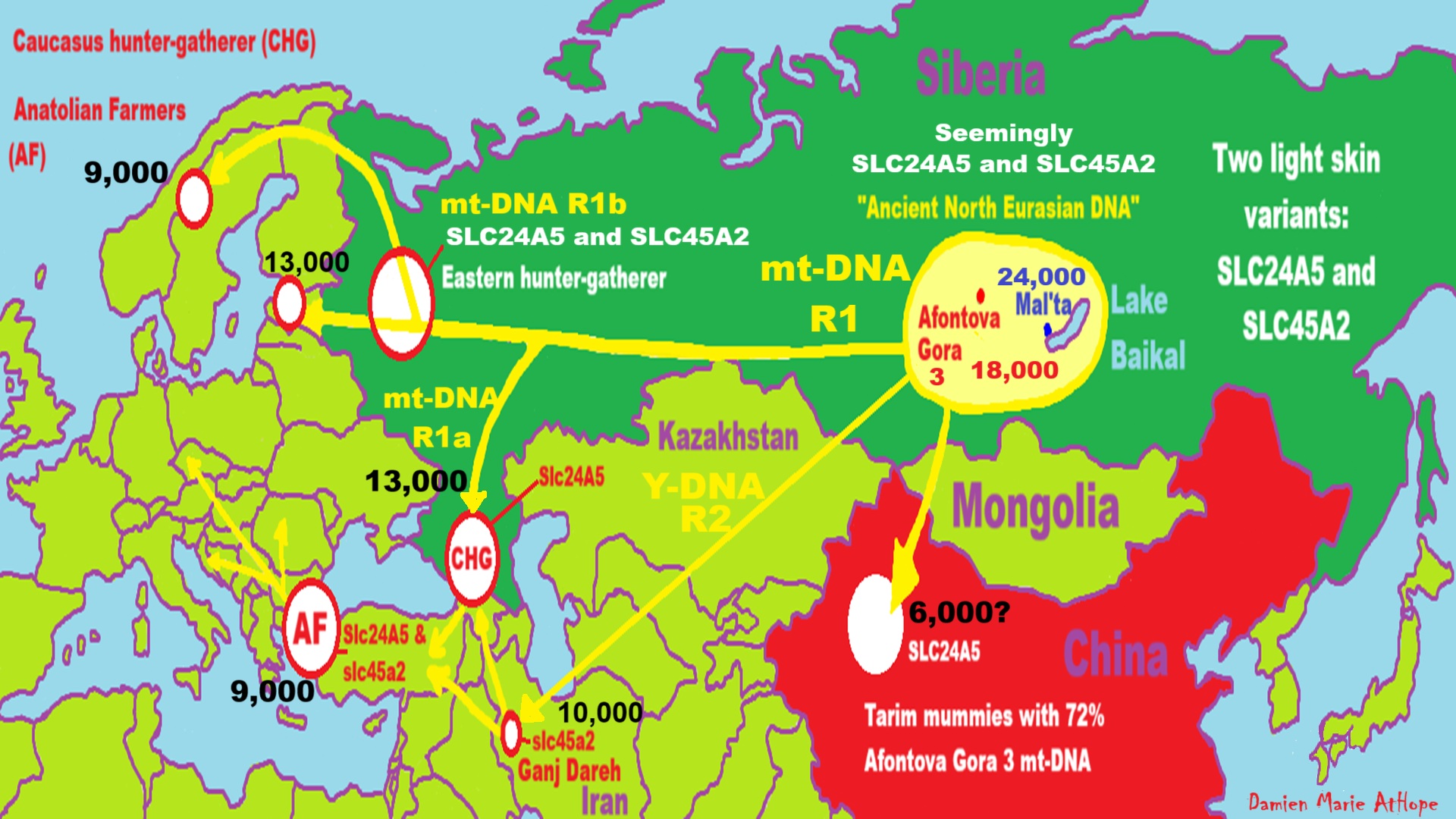
Two genes, SLC24A5 and SLC45A2, are most associated with lighter skin colour in modern Europeans.
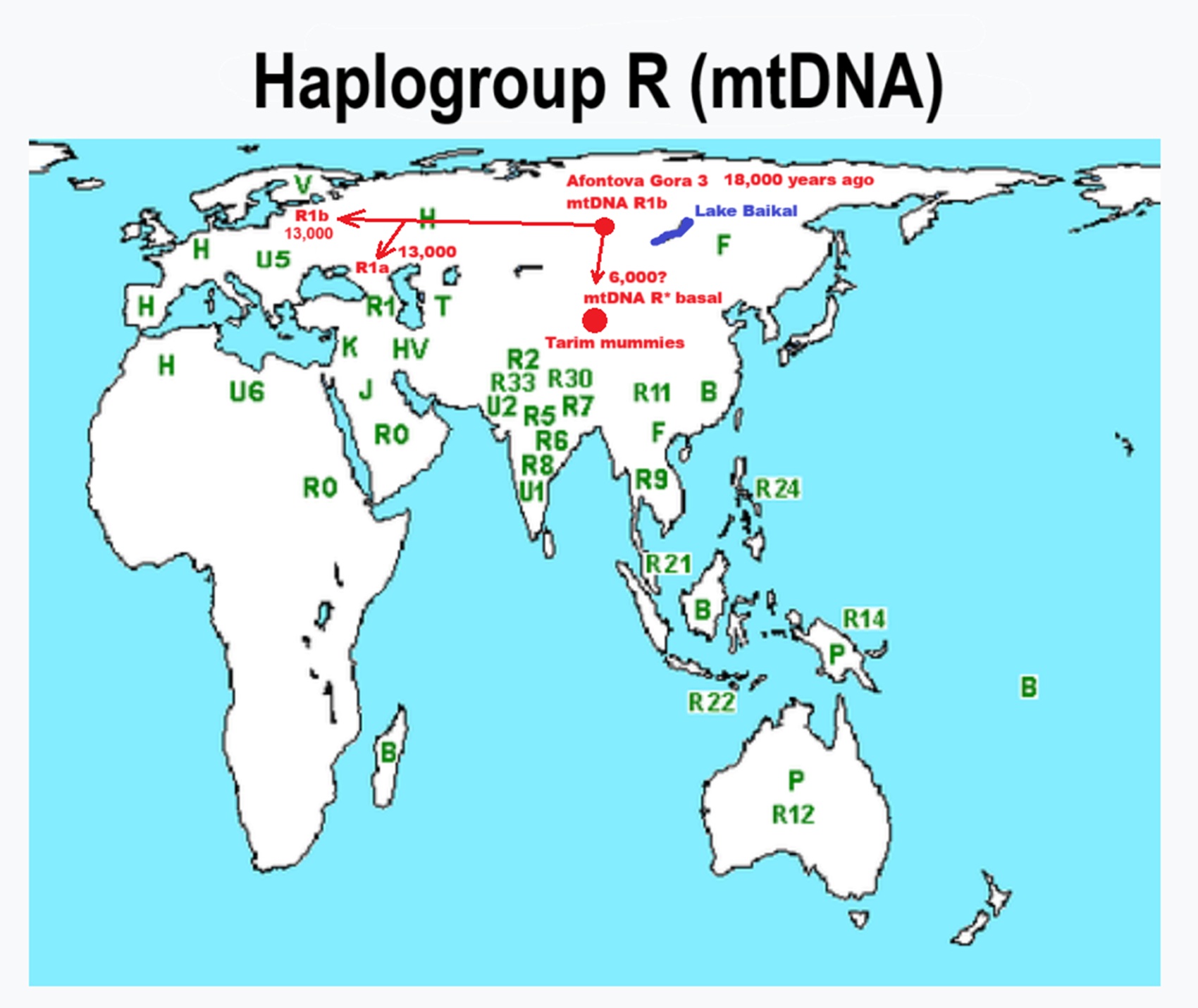
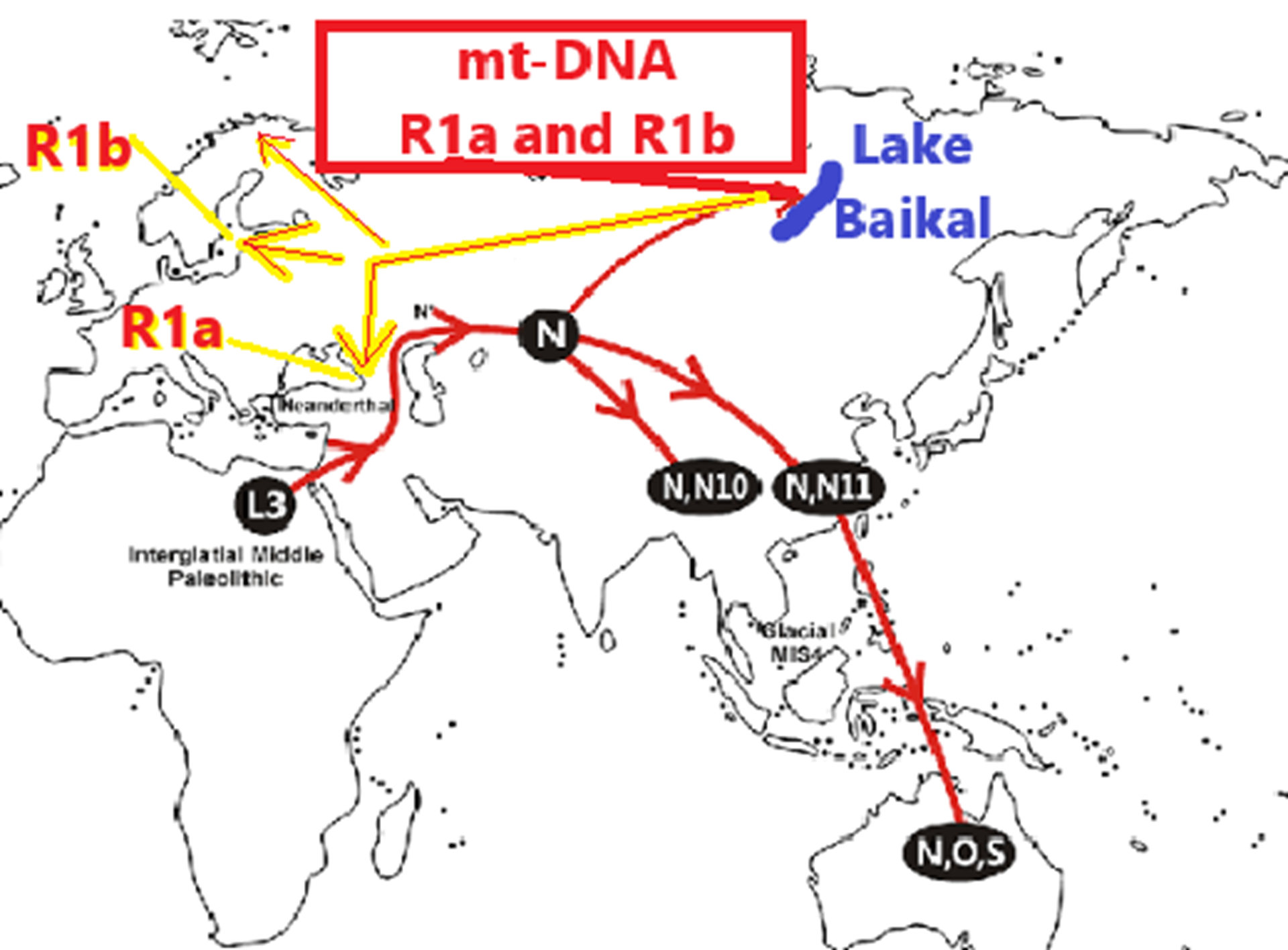
“Afontova Gora 3 (in Siberia, not far from Lake Baikal) 18,090 years ago, with mitochondrial Haplogroup R1b, who had the oldest blond hair color and light skin.” ref
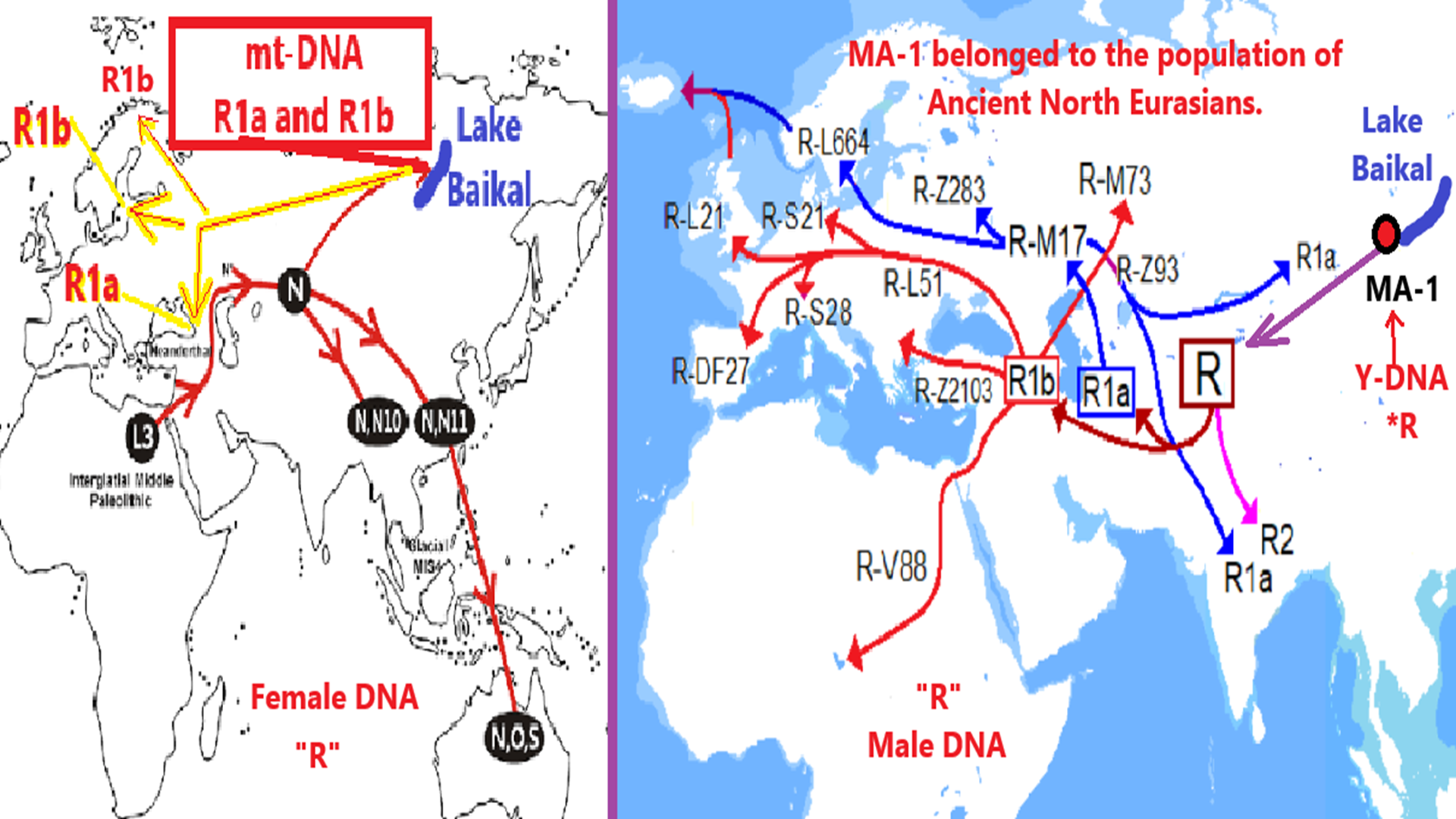
ref, ref, ref, ref, ref, ref, ref
“The Ancient North Eurasian (ANE) lineage, also known as Paleolithic Siberians, is defined by association with the “Mal’ta boy” (MA-1) haplogroup R*, the remains of an individual who lived during the Last Glacial Maximum, 24,000 years ago in near Lake Baikal central Siberia. Ancient North Eurasian associated Y-chromosome haplogroups are P-M45, and its subclades R and Q.” ref
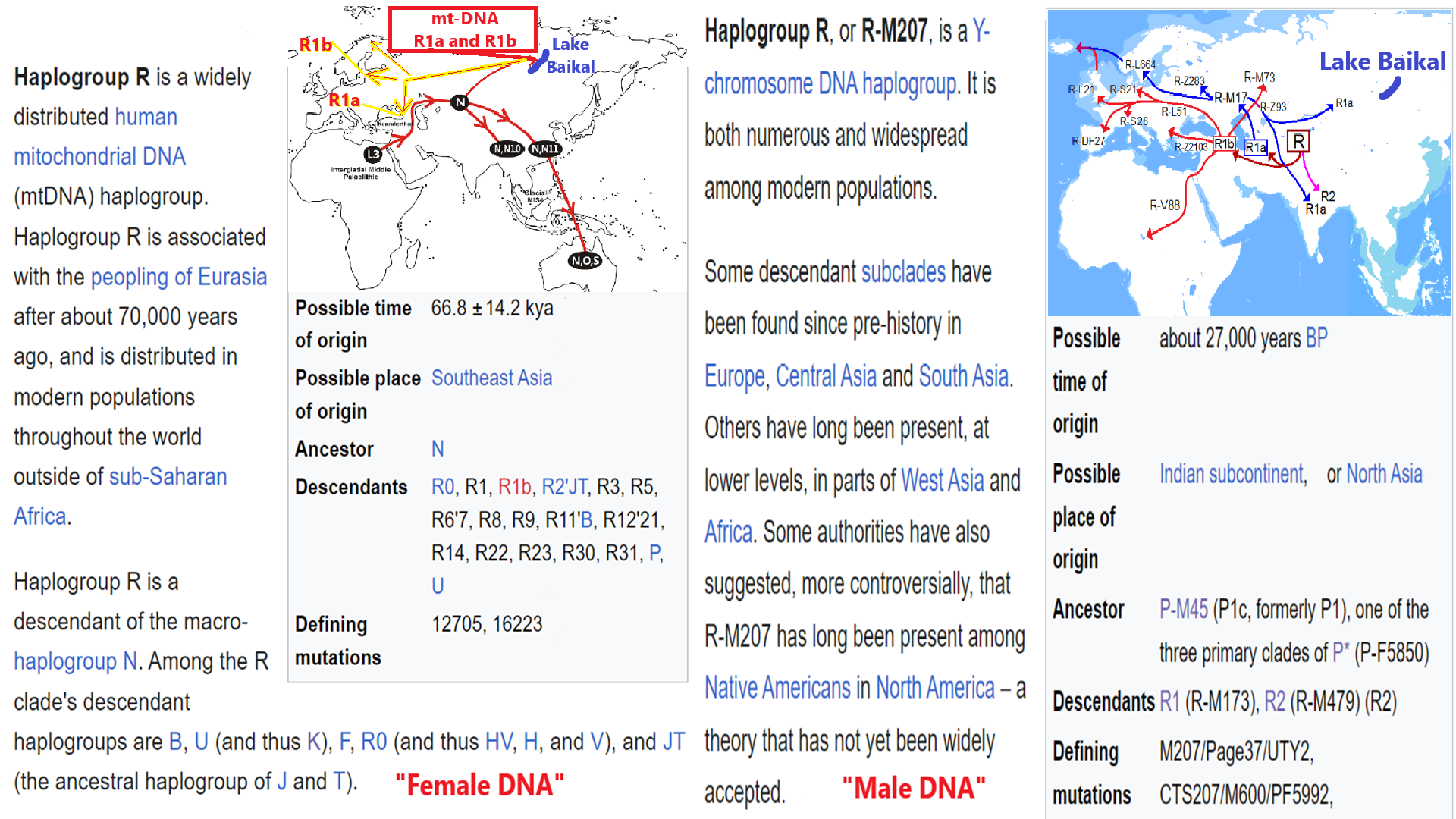
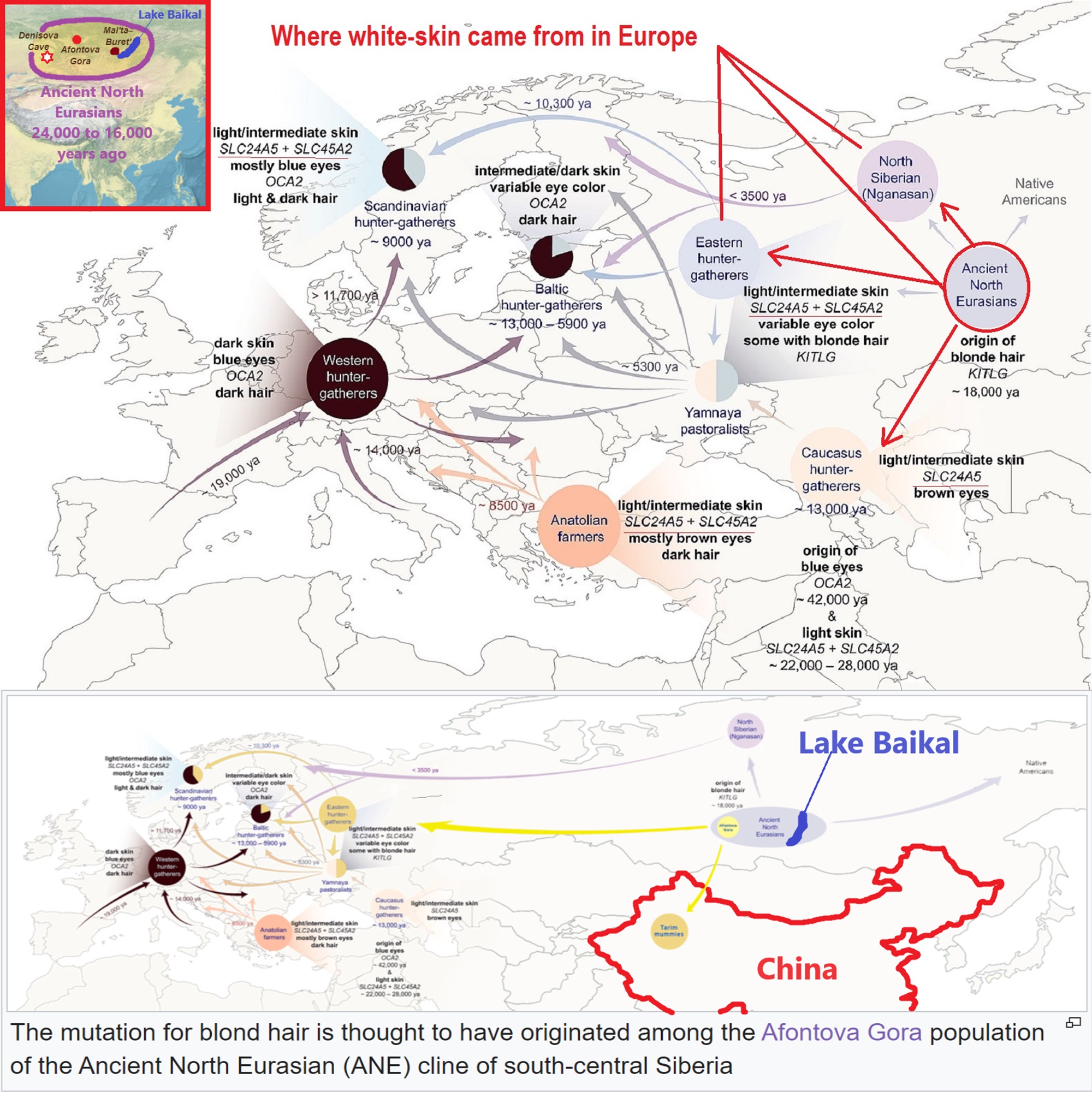
“Lighter skin and blond hair evolved in the Ancient North Eurasian (ANE) population. The SLC24A5 gene’s derived threonine or Ala111Thr allele (rs1426654) has been shown to be a major factor in the light skin tone of Europeans. Possibly originating as long as 19,000 years ago, it has been the subject of selection in the ancestors of Europeans as recently as within the last 5,000 years, and is fixed in modern European populations.” ref, ref
DNA-researcher: It’s not ‘woke’ to portray prehistoric Europeans with dark skin.
“It’s evolution. Ancient DNA analyses suggest that prehistoric Europeans looked different from modern Europeans today, but some people find that hard to accept. There was an artistic picture of an almost 6,000-year-old, girl who was walking along Lolland’s south coast and spits a piece of birch tar into the reeds. It didn’t taste great, but it helped to soothe her toothache. Fast forward 6,000 years, Danish archaeologists working on the Fehmarnbelt project stumble across the piece and recognize it for what it is: an almost 6,000-year-old piece of chewing gum. This ancient piece of gum is now on display at the Museum Lolland-Falster in southern Denmark among an amazing collection of Stone Age artifacts uncovered during the excavations. If you have not been, it is well worth a visit. In 2019, my research team at the University of Copenhagen managed something quite remarkable: We succeeded in extracting DNA from the gum and used it to reconstruct the girl’s entire genome — the first time anyone had sequenced an ancient human genome from anything other than skeletal remains. As the gum had been found on Lolland, we affectionately nicknamed her ‘Lola’.” ref
Stone-age girl in social media ‘shitstorm’
“The story of Lola and her chewing gum made headlines around the world when we published the genome in 2019 and then, suddenly, in the summer of 2023, Lola was back in the news, caught up in a media ‘shitstorm’. The ‘shitstorm’ first gathered pace on X, the platform formerly known as Twitter, and escalated to the point where the museum had to defend itself on national TV. Even the Danish newspaper ‘Ekstrabladet’ felt they had to comment and gave their opinion in a passionate editorial. So, what happened? These things are difficult to reconstruct, but evidently some people who had seen the image of Lola thought that she looked “way too dark” and accused us—and the museum—of ‘blackwashing’ the past. I suppose this episode says more about our own biases than anything else, and I would like to take this opportunity to explain why we portrayed Lola the way we did and what this tells us about the evolution of skin color in this part of the world.” ref
What we know about Lola
“First a disclaimer, we do not know exactly how old Lola was when she spat that chewing gum into the water. But based on her genome and other DNA trapped in the gum, we learned a lot of other things about her and her world. For example, we learned that she was a hunter-gatherer who lived off wild resources like fish, nuts, and wild game. At the time, small farming communities started to appear in other parts of Europe, but from what we can tell Lola and her kin still lived — as her ancestors had done for thousands of years before her — as hunter-gatherers. We also learned that she likely had dark skin, dark hair, and blue eyes. But how do we know that?” ref
The genetics of human skin pigmentation
“Skin color is a highly heritable and polygenic trait, meaning that it is influenced by multiple genes and their interactions with one another. One of the most well-known genes associated with skin pigmentation is the melanocortin 1 receptor gene (MC1R), but there are dozens more that have been reported to be involved in the pigmentation process. Most of these genes influence skin color by regulating the production of melanin, a dark pigment that protects from the deleterious effects of UV radiation. Basically, the more melanin you have in your skin, the darker it will be, and the more sun your skin can tolerate before you get sunburn. Eye and hair color are determined in a similar way, but the mechanisms that control the production of melanin in the eyes and hair are quite complex and independent processes. That is why it is possible to end up with different combinations of traits, such as the dark hair and blue eyes that are often seen in Europeans today, or the light hair and brown eyes that are common for Solomon Islanders, for example.” ref
How do we know what Lola looked like?
“Because the genes involved in pigmentation have been well studied, it is possible to predict the skin, eye, and hair color of an individual based on their genotype with a certain probability, something that is routinely done in forensic investigations. In practice, this works by checking which variants of a gene are present and what phenotype they are associated with. The more genes we can include in this analysis, the more confident we can be that our prediction is correct. In Lola’s case, we studied 41 gene variants across her genome that have been associated with skin, hair, and eye color in humans, and concluded that she likely had this unusual (at least for today) combination of dark skin, dark hair, and blue eyes.” ref
A common look in prehistoric Europe
“It is difficult to know exactly what people looked like 10,000 years ago. But based on ancient DNA studies, it appears that Lola’s ‘look’ was much more common in prehistoric Europe than it is today. Thanks to advances in ancient DNA sequencing, we now have the genomes of dozens of Upper Palaeolithic and Mesolithic (i.e. the period between around 50,000 and 5,000 years before present in Europe) individuals from Western Europe. And interestingly they all seem to lack the skin-lightening variants that are so common in Europeans today, indicating that they had dark skin. This is true for ‘Cheddar Man’ who lived around 10,000 years ago in southern England, as well as dozens of other Upper Palaeolithic and Mesolithic hunter-gatherer individuals from France, northern Italy, Spain, the Baltic, and other parts of Europe. Like skin color, eye color is also a fairly complex trait, involving the interaction of many different genes. Therefore, eye color is fairly difficult to predict, but it looks like Upper Palaeolithic and Mesolithic hunter-gatherers from Western Europe often had blue eyes, just like Lola. Overall, it looks like Lola’s phenotype—the combination of dark skin, dark hair, and blue eyes—was much more common in prehistoric Europe than it is today.” ref
How Europeans got their lighter skin
“So, why did people in prehistoric Europe look so different from northern Europeans today? The answer to this question lies in a complex interplay between our genes, our changing diets, population movements, and the environment. It has been theorized for some time that lighter skin emerged as an adaptive trait to light poor environments as it allows you to absorb sunlight more effectively, which is essential for the production of vitamin D. However, it was unclear when this happened. Early studies suggested that we first may have evolved lighter skin as our ancestors moved out of Africa and into Europe c. 50,000 years ago, but we now believe that this happened much later in European prehistory. In fact, there is evidence that lighter skin only evolved within the last 5,000 years or so, as a result of genetic admixture from Neolithic farming populations (who carried the skin-lightening variant) and strong selection favoring lighter skin.” ref
Our changing diet also played a part
“In addition, it looks like our changing diets also played a part. During most of European prehistory people relied on wild resources like nuts, game, and fish that are all rich in vitamin D, which is essential to our health. That changed dramatically during the Neolithic when people started to rely on a farmer’s diet that was rich in carbohydrates, but poor in vitamin D. Interestingly, this is exactly the period when we see lighter skin tones evolve in Western Europe and we think that the lack of vitamin D in the diet may have increased the selection pressures favouring lighter skin. All in all, there is solid evidence to suggest that lighter skin tones only evolved in Europe within the last 5,000 years or so, and that people who lived in Europe before then typically had darker skin. It is not that surprising, then, that Lola had darker skin. It simply reflects the fact that she lived at a time when Europeans had not yet evolved their lighter skin.” ref
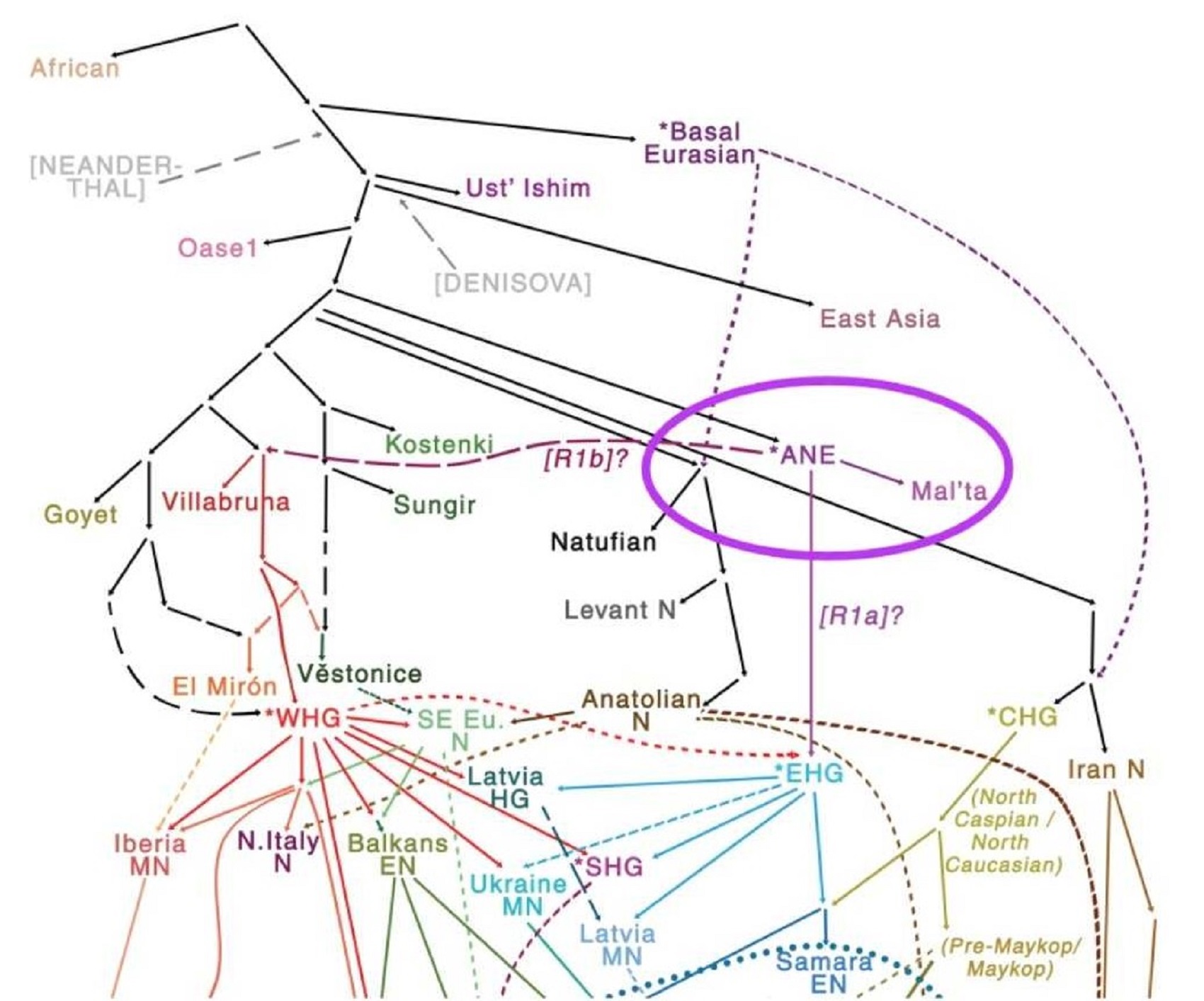

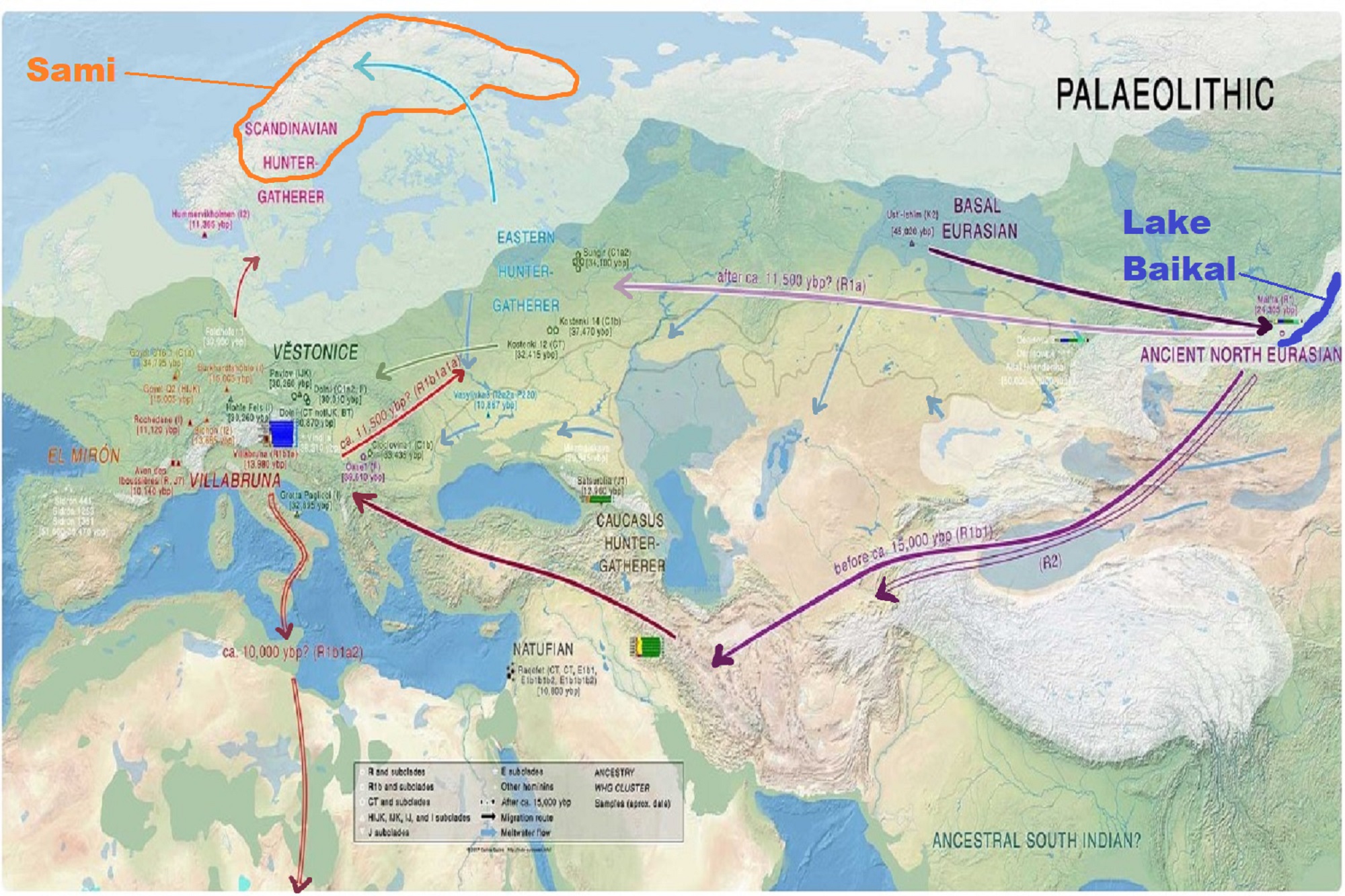
“Scandinavia’s First Farmers – who arrived some 5,900 years ago and wiped out the hunter-gatherer population within a few generations. Then, some 4,850 years ago, from southern Russia, the Yamnaya culture’s ancestors entered Scandinavia replacing those early farmers.” ref
“According to a statement released by Lund University, DNA analysis of bone and teeth samples from prehistoric human remains unearthed in Denmark suggests that the first farmers to arrive in Scandinavia some 5,900 years ago wiped out the hunter-gatherer population within a few generations. “This transition has previously been presented as peaceful,” said Anne Birgitte Nielsen of Lund University. “However, our study indicates the opposite. In addition to violent death, it is likely that new pathogens from livestock finished off many gatherers,” she added. Then, some 4,850 years ago, seminomadic domestic cattle herders from southern Russia with Yamnaya ancestors entered Scandinavia and replaced those early farmers. This may have also occurred through violence and disease, Nielsen explained. Today’s Scandinavian population in Denmark can be traced to a mix of the Yamnaya and Eastern Europe’s Neolithic people. “We don’t have as much [ancient] DNA material from Sweden, but what there is, points to a similar course of events,” Nielsen said. Read the original scholarly article about this research in Nature. For more, go to “Europe’s First Farmers.” ref
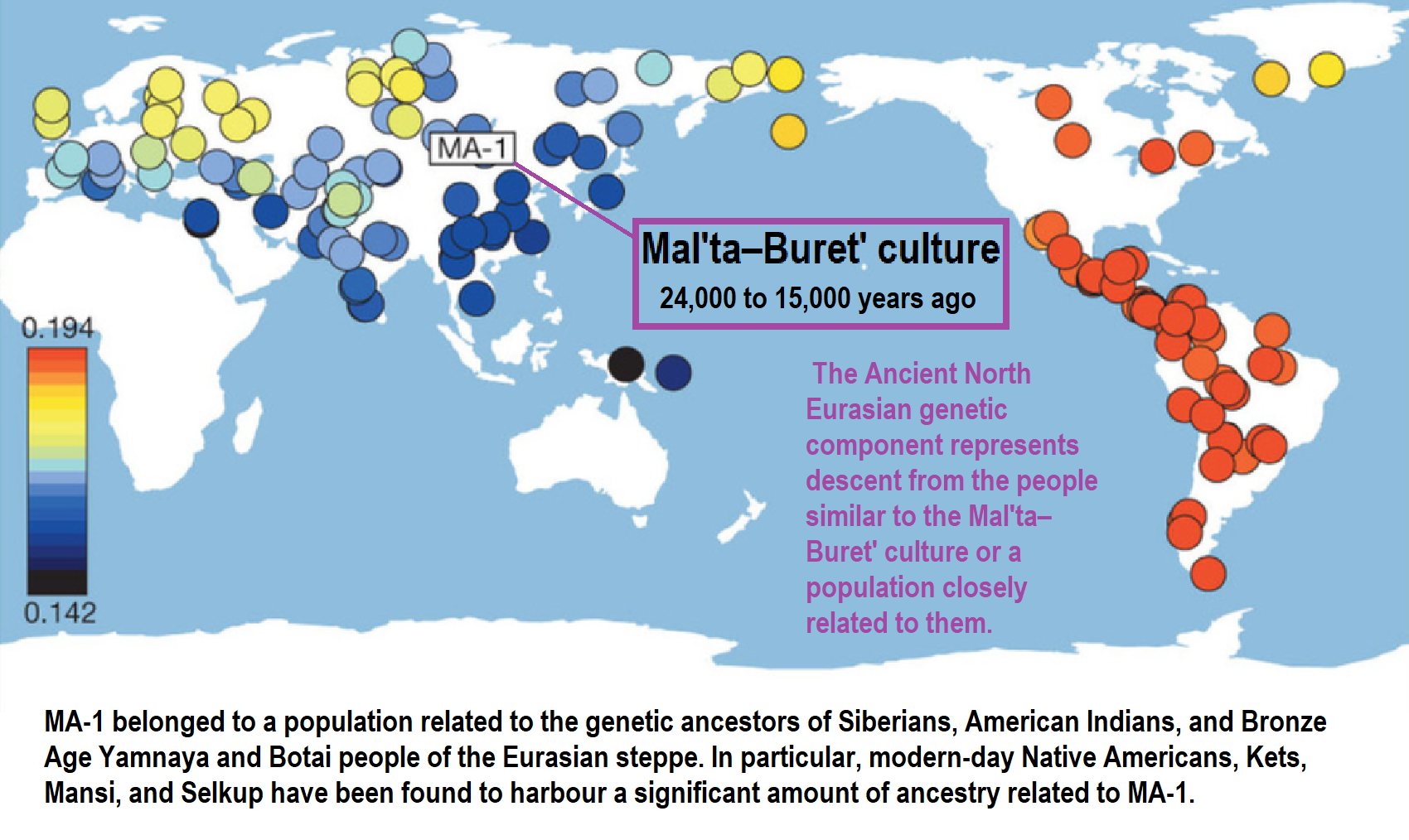

Ancient North Eurasian (ANE)
Ancient Beringian/Ancestral Native American (AB/ANA)
Eastern Hunter-Gatherer (EHG)
Western Hunter-Gatherers (WHG)
Western Steppe Herders (WSH)
Scandinavian Hunter-Gatherer (SHG)
Early European Farmers (EEF)
Jōmon people (Ainu people OF Hokkaido Island)
Neolithic Iranian farmers (Iran_N) (Iran Neolithic)
Haplogroup R possible time of origin about 27,000 years in Central Asia, South Asia, or Siberia:
- Mal’ta–Buret’ culture (24,000-15,000 years ago)
- Afontova Gora culture (21,000-12,000 years ago)
- Trialetian culture (16,000–8000 years ago)
- Samara culture (7,000-6,500 years ago)
- Khvalynsk culture (7,000-6,500 years ago)
- Afanasievo culture (5,300-4,500 years ago)
- Yamna/Yamnaya Culture (5,300-4,500 years ago)
- Andronovo culture (4,000–2,900 years ago) ref
Groups partially derived from the Ancient North Eurasians
“The ANE lineage is defined by association with the MA-1, or “Mal’ta boy”, remains of 24,000 years ago in central Siberia Mal’ta-Buret’ culture 24,000-15,000 years ago. The Ancient North Eurasians (ANE) samples (Afontova Gora 3, Mal’ta 1, and Yana-RHS) show evidence for minor gene flow from an East Asian-related group (simplified by the Amis, Han, or Tianyuan) but no evidence for ANE-related geneflow into East Asians (Amis, Han, Tianyuan), except the Ainu, of North Japan.” ref
“The ANE lineage is defined by association with the MA-1, or “Mal’ta boy”, remains of 24,000 years ago in central Siberia Mal’ta-Buret’ culture 24,000-15,000 years ago “basal to modern-day Europeans”. Some Ancient North Eurasians also carried East Asian populations, such as Tianyuan Man.” ref
“Bronze-age-steppe Yamnaya and Afanasevo cultures were ANE at around 50% and Eastern Hunter-Gatherer (EHG) at around 75% ANE. Karelia culture: Y-DNA R1a-M417 8,400 years ago, Y-DNA J, 7,200 years ago, and Samara, of Y-haplogroup R1b-P297 7,600 years ago is closely related to ANE from Afontova Gora, 18,000 years ago around the time of blond hair first seen there.” ref
Ancient North Eurasian
“In archaeogenetics, the term Ancient North Eurasian (often abbreviated as ANE) is the name given to an ancestral West Eurasian component that represents descent from the people similar to the Mal’ta–Buret’ culture and populations closely related to them, such as from Afontova Gora and the Yana Rhinoceros Horn Site. Significant ANE ancestry are found in some modern populations, including Europeans and Native Americans.” ref
“The ANE lineage is defined by association with the MA-1, or “Mal’ta boy“, the remains of an individual who lived during the Last Glacial Maximum, 24,000 years ago in central Siberia, Ancient North Eurasians are described as a lineage “which is deeply related to Paleolithic/Mesolithic hunter-gatherers in Europe,” meaning that they diverged from Paleolithic Europeans a long time ago.” ref
“The ANE population has also been described as having been “basal to modern-day Europeans” but not especially related to East Asians, and is suggested to have perhaps originated in Europe or Western Asia or the Eurasian Steppe of Central Asia. However, some samples associated with Ancient North Eurasians also carried ancestry from an ancient East Asian population, such as Tianyuan Man. Sikora et al. (2019) found that the Yana RHS sample (31,600 BP) in Northern Siberia “can be modeled as early West Eurasian with an approximately 22% contribution from early East Asians.” ref
“Populations genetically similar to MA-1 were an important genetic contributor to Native Americans, Europeans, Central Asians, South Asians, and some East Asian groups, in order of significance. Lazaridis et al. (2016:10) note “a cline of ANE ancestry across the east-west extent of Eurasia.” The ancient Bronze-age-steppe Yamnaya and Afanasevo cultures were found to have a noteworthy ANE component at ~50%.” ref
“According to Moreno-Mayar et al. 2018 between 14% and 38% of Native American ancestry may originate from gene flow from the Mal’ta–Buret’ people (ANE). This difference is caused by the penetration of posterior Siberian migrations into the Americas, with the lowest percentages of ANE ancestry found in Eskimos and Alaskan Natives, as these groups are the result of migrations into the Americas roughly 5,000 years ago.” ref
“Estimates for ANE ancestry among first wave Native Americans show higher percentages, such as 42% for those belonging to the Andean region in South America. The other gene flow in Native Americans (the remainder of their ancestry) was of East Asian origin. Gene sequencing of another south-central Siberian people (Afontova Gora-2) dating to approximately 17,000 years ago, revealed similar autosomal genetic signatures to that of Mal’ta boy-1, suggesting that the region was continuously occupied by humans throughout the Last Glacial Maximum.” ref
“The earliest known individual with a genetic mutation associated with blonde hair in modern Europeans is an Ancient North Eurasian female dating to around 16000 BCE from the Afontova Gora 3 site in Siberia. It has been suggested that their mythology may have included a narrative, found in both Indo-European and some Native American fables, in which a dog guards the path to the afterlife.” ref
“Genomic studies also indicate that the ANE component was introduced to Western Europe by people related to the Yamnaya culture, long after the Paleolithic. It is reported in modern-day Europeans (7%–25%), but not of Europeans before the Bronze Age. Additional ANE ancestry is found in European populations through paleolithic interactions with Eastern Hunter-Gatherers, which resulted in populations such as Scandinavian Hunter-Gatherers.” ref
“The Ancient North Eurasians (ANE) split from the ancestors of European peoples somewhere in the Middle East or South-central Asia, and used a northern dispersal route through Central Asia into Northern Asia and Siberia. Genetic analyses show that all ANE samples (Afontova Gora 3, Mal’ta 1, and Yana-RHS) show evidence for minor gene flow from an East Asian-related group (simplified by the Amis, Han, or Tianyuan). In contrast, no evidence for ANE-related geneflow into East Asians (Amis, Han, Tianyuan), except the Ainu, was found.” ref
“Genetic data suggests that the ANE formed during the Terminal Upper-Paleolithic (36+-1,5ka) period from a deeply European-related population, which was once widespread in Northern Eurasia, and from an early East Asian-related group, which migrated northwards into Central Asia and Siberia, merging with this deeply European-related population. These population dynamics and constant northwards geneflow of East Asian-related ancestry would later gave rise to the “Ancestral Native Americans” and Paleosiberians, which replaced the ANE as dominant population of Siberia.” ref
Groups partially derived from the Ancient North Eurasians
“Eastern Hunter-Gatherer (EHG) is a lineage derived predominantly (75%) from ANE. It is represented by two individuals from Karelia, one of Y-haplogroup R1a-M417, dated c. 8.4 kya, the other of Y-haplogroup J, dated c. 7.2 kya; and one individual from Samara, of Y-haplogroup R1b-P297, dated c. 7.6 kya. This lineage is closely related to the ANE sample from Afontova Gora, dated c. 18 kya. After the end of the Last Glacial Maximum, the Western Hunter-Gatherers (WHG) and EHG lineages merged in Eastern Europe, accounting for early presence of ANE-derived ancestry in Mesolithic Europe. Evidence suggests that as Ancient North Eurasians migrated West from Eastern Siberia, they absorbed Western Hunter-Gatherers and other West Eurasian populations as well.” ref
“Caucasian Hunter-Gatherer (CHG) is represented by the Satsurblia individual dated ~13 kya (from the Satsurblia cave in Georgia), and carried 36% ANE-derived admixture. While the rest of their ancestry is derived from the Dzudzuana cave individual dated ~26 kya, which lacked ANE-admixture, Dzudzuana affinity in the Caucasus decreased with the arrival of ANE at ~13 kya Satsurblia.” ref
“Scandinavian Hunter-Gatherer (SHG) is represented by several individuals buried at Motala, Sweden ca. 6000 BC. They were descended from Western Hunter-Gatherers who initially settled Scandinavia from the south, and later populations of EHG who entered Scandinavia from the north through the coast of Norway.” ref
“Iran Neolithic (Iran_N) individuals dated ~8.5 kya carried 50% ANE-derived admixture and 50% Dzudzuana-related admixture, marking them as different from other Near-Eastern and Anatolian Neolithics who didn’t have ANE admixture. Iran Neolithics were later replaced by Iran Chalcolithics, who were a mixture of Iran Neolithic and Near Eastern Levant Neolithic.” ref
“Ancient Beringian/Ancestral Native American are specific archaeogenetic lineages, based on the genome of an infant found at the Upward Sun River site (dubbed USR1), dated to 11,500 years ago. The AB lineage diverged from the Ancestral Native American (ANA) lineage about 20,000 years ago.” ref
“West Siberian Hunter-Gatherer (WSHG) are a specific archaeogenetic lineage, first reported in a genetic study published in Science in September 2019. WSGs were found to be of about 30% EHG ancestry, 50% ANE ancestry, and 20% to 38% East Asian ancestry.” ref
“Western Steppe Herders (WSH) is the name given to a distinct ancestral component that represents descent closely related to the Yamnaya culture of the Pontic–Caspian steppe. This ancestry is often referred to as Yamnaya ancestry or Steppe ancestry.” ref
“Late Upper Paeolithic Lake Baikal – Ust’Kyakhta-3 (UKY) 14,050-13,770 BP were mixture of 30% ANE ancestry and 70% East Asian ancestry.” ref
“Lake Baikal Holocene – Baikal Eneolithic (Baikal_EN) and Baikal Early Bronze Age (Baikal_EBA) derived 6.4% to 20.1% ancestry from ANE, while rest of their ancestry was derived from East Asians. Fofonovo_EN near by Lake Baikal were mixture of 12-17% ANE ancestry and 83-87% East Asian ancestry.” ref
“Hokkaido Jōmon people specifically refers to the Jōmon period population of Hokkaido in northernmost Japan. Though the Jōmon people themselves descended mainly from East Asian lineages, one study found an affinity between Hokkaido Jōmon with the Northern Eurasian Yana sample (an ANE-related group, related to Mal’ta), and suggest as an explanation the possibility of minor Yana gene flow into the Hokkaido Jōmon population (as well as other possibilities). A more recent study by Cooke et al. 2021, confirmed ANE-related geneflow among the Jōmon people, partially ancestral to the Ainu people. ANE ancestry among Jōmon people is estimated at 21%, however, there is a North to South cline within the Japanese archipelago, with the highest amount of ANE ancestry in Hokkaido and Tohoku.” ref
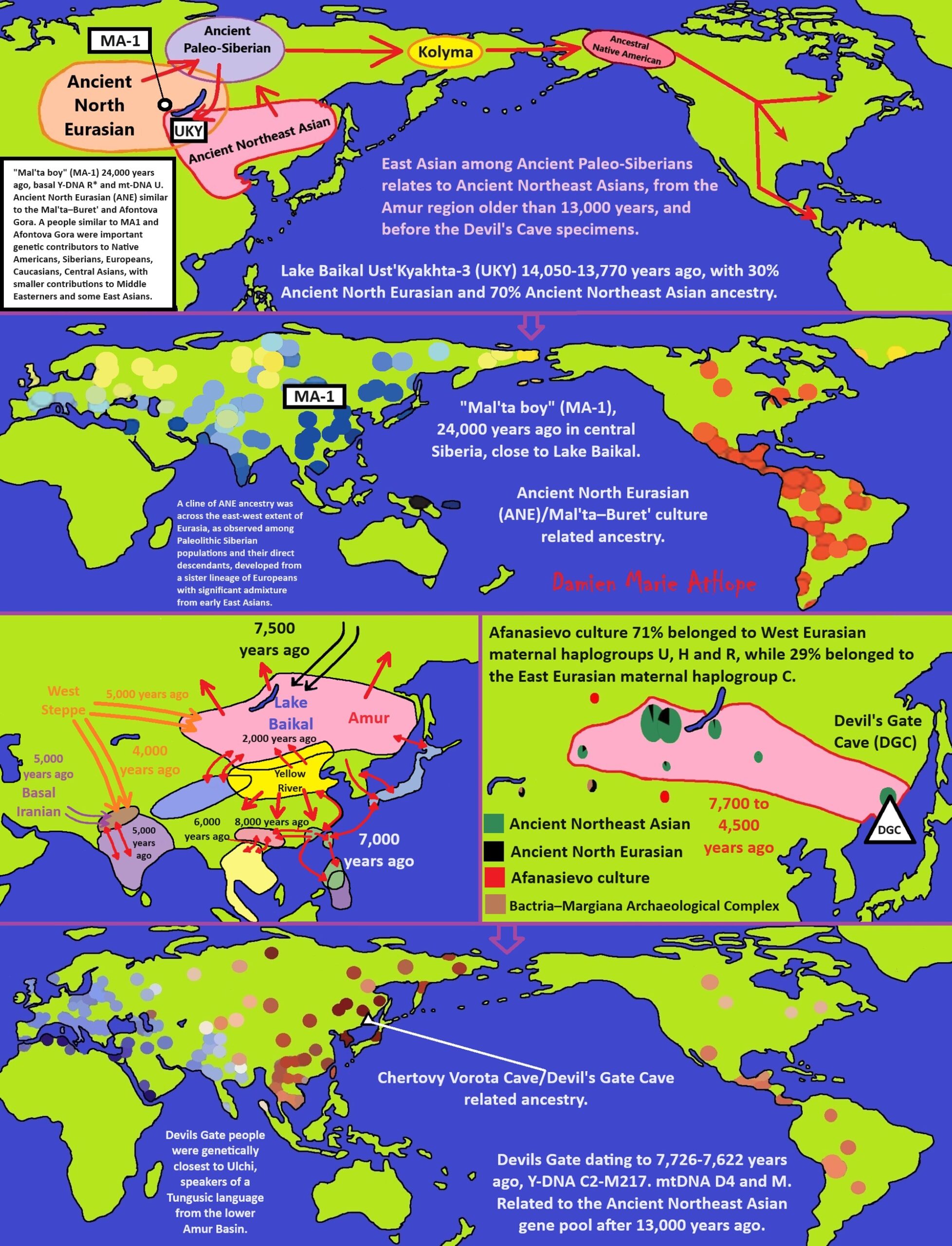
ref, ref, ref, ref, ref, ref, ref, ref, ref, ref, ref, ref, ref, ref, ref
“A 2016 study found that the global maximum of Ancient North Eurasian (ANE) ancestry occurs in modern-day Kets, Mansi, Native Americans, and Selkups. ANE ancestry has spread throughout Eurasia and the Americas in various migrations since the Upper Paleolithic, and more than half of the world’s population today derives between 5 and 42% of their genomes from the Ancient North Eurasians. Significant ANE ancestry can be found in Native Americans, as well as in regions of northern Europe, South Asia, Central Asia, and Siberia. It has been suggested that their mythology may have featured narratives shared by both Indo-European and some Native American cultures, such as the existence of a metaphysical world tree and a fable in which a dog guards the path to the afterlife.” ref
Ancient Northern East Asian/ later became Ancient Northeast Asian
Ancient Paleo-Siberian
Mal’ta–Buret’ culture (Mal’ta boy MA-1)
The Kolyma Shaitans: Legends and Reality (I only use just a small part)
“A unique “shaitan” burial was discovered on the bank of Omuk-Kuel Lake in the Middle-Kolyma ulus in Yakutia. According to the legends, buried in it are mummified remains of a shaman woman who died during a devastating smallpox epidemics in the 18th c. In an attempt to overcome the deadly disease, the shaman’s relatives used her remains as an emeget fetish. The author believes that these legends reflect the real events of those far-away years. The Arabic word “shaitan” came to the Russian language from Turkic languages. According to Islamic tradition, a shaitan is a genie, an evil spirit, a demon. During Russian colonization and Christianization of Siberia, all sacred things used by the aborigines as fetishes, patron spirits of the family, and the tribe, grew to be called “shaitans.” There are various facts, dating to the 18th and 19th cc., confirming that this word also referred to the mummified remains of outstanding shamans.” ref
“In the 1740s, a member of the Second Kamchatka Expedition Yakov Lindenau wrote, “Meat is scratched off the [shaman’s] bones and the bones are put together to form a skeleton, which is dressed in human’s clothes and worshipped as a deity. The Yukagirs place such dressed bones…in their yurts, their number can sometimes reach 10 or 15. If somebody commits even a minor sacrilege with respect to these bones, he stirs up rancor on the part of the Yukagirs… While traveling and hunting, the Yukagirs carry these bones in their sledges, and moreover, in their best sledges pulled by their best deer. When the Yukagirs are going to undertake something really important, they tell fortune using these skeletons: lift a skeleton up, and if it seems light, it means that their enterprise will have a favorable outcome. The Yukagirs call these skeletons stariks (old men), endow them with their best furs, and sit them on beds covered with deer hides, in a circle, as though they are alive.” (Lindenau, 1983, p. 155)” ref
“In the late 19th c., a famous explorer of aboriginal culture V. I. Jochelson noted the changes that occurred in the ritual in the last century and a half. So, the Yukagirs divided among themselves the shaman’s meat dried in the sun and then put it in separate tents. The dead bodies of killed dogs were left there as well. “After that,” V. I. Jochelson writes, “they would divide the shaman’s bones, dry them and wrap in clothes. The skull was an object of worshipping. It was put on top of a trunk (body) cut out of wood. A caftan and two hats – a winter and a summer one – were sewn for the idol. The caftan was all embroidered. On the skull, a special mask was put, with holes for the eyes and the mouth… The figure was placed in the front corner of the home. Before a meal, a piece of food was thrown into the fire and the idol was held above it. This feeding of the idol… was committed before each meal.” (V. I. Jochelson, 2005, pp. 236—237)” ref
“The idol was kept by the children of the dead shaman. One of them was inducted into the shamanism mysteries while his father was still alive. The idol was carried in a wooden box. Sometimes, in line with the air burial ritual, the box was erected on poles or trees, and the idol was taken out only before hunting or a long journey so that the outcome of the enterprise planned could be predicted. With time, the Yukagirs began using wooden idols as charms. V. I. Jochelson notes that by the late 19th c. the Yukagirs had developed a skeptical attitude towards idols and referred to them as “shaitans.” In this way, under the influence of Christianity, the worshipped ancestor’s spirit turned into its opposite – an evil spirit, a devil, a Satan.” ref
Ancestral Native American, Ancient Beringian
14,000-year-old Ust-Kyakhta-3 (UKY) individual found near Lake Baikal
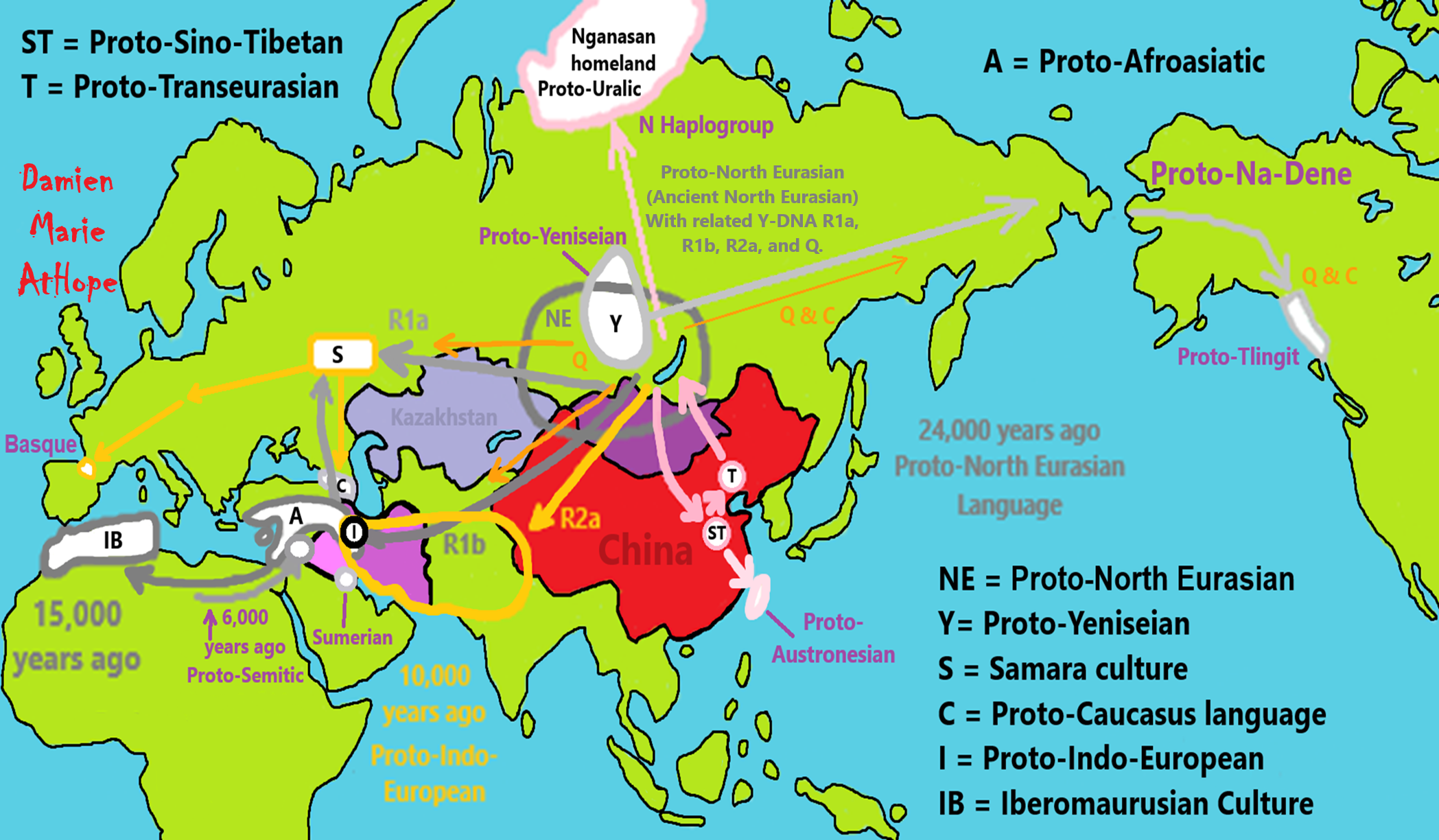
ref, ref, ref, ref, ref, ref, ref, ref, ref, ref, ref, ref, ref, ref, ref, ref, ref, ref, ref, ref, ref, ref, ref, ref, ref, ref, ref, ref, ref, ref, ref
This art above explains my thinking from my life of investigation
I am an anarchist (Social anarchism, Left-wing anarchism, or Socialist anarchism) trying to explain prehistory as I see it after studying it on my own starting 2006. Anarchists are for truth and believe in teaching the plain truth; misinformation is against this, and we would and should fight misinformation and disinformation.
I see anarchism as a social justice issue not limited to some political issue or monetary persuasion. People own themselves, have self/human rights, and deserve freedoms. All humanity is owed respect for its dignity; we are all born equal in dignity and human rights, and no plot of dirt we currently reside on changes this.
I fully enjoy the value (axiology) of archaeology (empirical evidence from fact or artifacts at a site) is knowledge (epistemology) of the past, adding to our anthropology (evidence from cultures both the present and past) intellectual (rational) assumptions of the likely reality of actual events from time past.
I am an Axiological Atheist, Philosopher & Autodidact Pre-Historical Writer/Researcher, Anti-theist, Anti-religionist, Anarcho Humanist, LGBTQI, Race, & Class equality. I am not an academic, I am a revolutionary sharing education and reason to inspire more deep thinking. I do value and appreciate Academics, Archaeologists, Anthropologists, and Historians as they provide us with great knowledge, informing us about our shared humanity.
I am a servant leader, as I serve the people, not myself, not my ego, and not some desire for money, but rather a caring teacher’s heart to help all I can with all I am. From such thoughtfulness may we all see the need for humanism and secularism, respecting all as helpful servant leaders assisting others as often as we can to navigate truth and the beauty of reality.
‘Reality’ ie. real/external world things, facts/evidence such as that confirmed by science, or events taken as a whole documented understanding of what occurred/is likely to have occurred; the accurate state of affairs. “Reason” is not from a mind devoid of “unreason” but rather demonstrates the potential ability to overcome bad thinking. An honest mind, enjoys just correction. Nothing is a justified true belief without valid or reliable reason and evidence; just as everything believed must be open to question, leaving nothing above challenge.
I don’t believe in gods or ghosts, and nor souls either. I don’t believe in heavens or hells, nor any supernatural anything. I don’t believe in Aliens, Bigfoot, nor Atlantis. I strive to follow reason and be a rationalist. Reason is my only master and may we all master reason. Thinking can be random, but reason is organized and sound in its Thinking. Right thinking is reason, right reason is logic, and right logic can be used in math and other scientific methods. I don’t see religious terms Animism, Totemism, Shamanism, or Paganism as primitive but original or core elements that are different parts of world views and their supernatural/non-natural beliefs or thinking.
I am inspired by philosophy, enlightened by archaeology, and grounded by science that religion claims, on the whole, along with their magical gods, are but dogmatic propaganda, myths, and lies. To me, religions can be summed up as conspiracy theories about reality, a reality mind you is only natural and devoid of magic anything. And to me, when people talk as if Atlantis is anything real, I stop taking them seriously. Like asking about the reality of Superman or Batman just because they seem to involve metropolitan cities in their stores. Or if Mother Goose actually lived in a shoe? You got to be kidding.
We are made great in our many acts of kindness, because we rise by helping each other.
NE = Proto-North Eurasian/Ancient North Eurasian/Mal’ta–Buret’ culture/Mal’ta Boy “MA-1” 24,000 years old burial
A = Proto-Afroasiatic/Afroasiatic
S = Samara culture
ST = Proto-Sino-Tibetan/Sino-Tibetan
T = Proto-Transeurasian/Altaic
C = Proto-Northwest Caucasus language/Northwest Caucasian/Languages of the Caucasus
I = Proto-Indo-European/Indo-European
IB = Iberomaurusian Culture/Capsian culture
Natufian culture (15,000–11,500 years ago, Syria, Lebanon, Jordan, the Sinai Peninsula, and the Negev desert)
Nganasan people/Nganasan language
Na-Dene languages/Dené–Yeniseian, Dené–Caucasian
Proto-Semitic/Semitic languages
24,000 years ago, Proto-North Eurasian Language (Ancient North Eurasian) migrations?
My thoughts:
Proto-North Eurasian Language (Ancient North Eurasian) With related Y-DNA R1a, R1b, R2a, and Q Haplogroups.
R1b 22,0000-15,000 years ago in the Middle east creates Proto-Afroasiatic languages moving into Africa around 15,000-10,000 years ago connecting with the Iberomaurusian Culture/Taforalt near the coasts of Morocco, Algeria, and Tunisia.
R2a 10,000 years ago in Iran brings/creates Proto-Indo-European language and also a possibility is R1a in Russia around 9,000 years ago may have had a version of Proto-Indo-European language.
Around 14,000-10,000 years ago??? Proto-North Eurasian Language goes to the Yellow River basin (eventually relating with the Yangshao culture) in China creates Proto-Sino-Tibetan language.
Proto-Sino-Tibetan language then moves to the West Liao River valley (eventually relating with the Hongshan culture) in China creating Proto-Transeurasian (Altaic) language around 9,000 years ago.
N Haplogroups 9,000 years ago with Proto-Transeurasian language possibly moves north to Lake Baikal. Then after living with Proto-North Eurasian Language 24,000-9,000 years ago?/Pre-Proto-Yeniseian language 9,000-7,000 years ago Q Haplogroups (eventually relating with the Ket language and the Ket people) until around 5,500 years ago, then N Haplogroups move north to the Taymyr Peninsula in North Siberia (Nganasan homeland) brings/creates the Proto-Uralic language.
Q Haplogroups with Proto-Yeniseian language /Proto-Na-Dene language likely emerge 8,000/7,000 years ago or so and migrates to the Middle East (either following R2a to Iraq or R1a to Russia (Samara culture) then south to Iraq creates the Sumerian language. It may have also created the Proto-Caucasian languages along the way. And Q Haplogroups with Proto-Yeniseian language to a migration to North America that relates to Na-Dené (and maybe including Haida) languages, of which the first branch was Proto-Tlingit language 5,000 years ago, in the Pacific Northwest.
Sino-Tibetan language then moves more east in China to the Hemudu culture pre-Austronesian culture, next moved to Taiwan creating the Proto-Austronesian language around 6,000-5,500 years ago.
R1b comes to Russia from the Middle East around 7,500 years ago, bringing a version of Proto-Indo-European languages to the (Samara culture), then Q Y-DNA with Proto-Yeniseian language moves south from the (Samara culture) and may have been the language that created the Proto-Caucasian language. And R1b from the (Samara culture) becomes the 4,200 years or so R1b associated with the Basques and Basque language it was taken with R1b, but language similarities with the Proto-Caucasian language implies language ties to Proto-Yeniseian language.

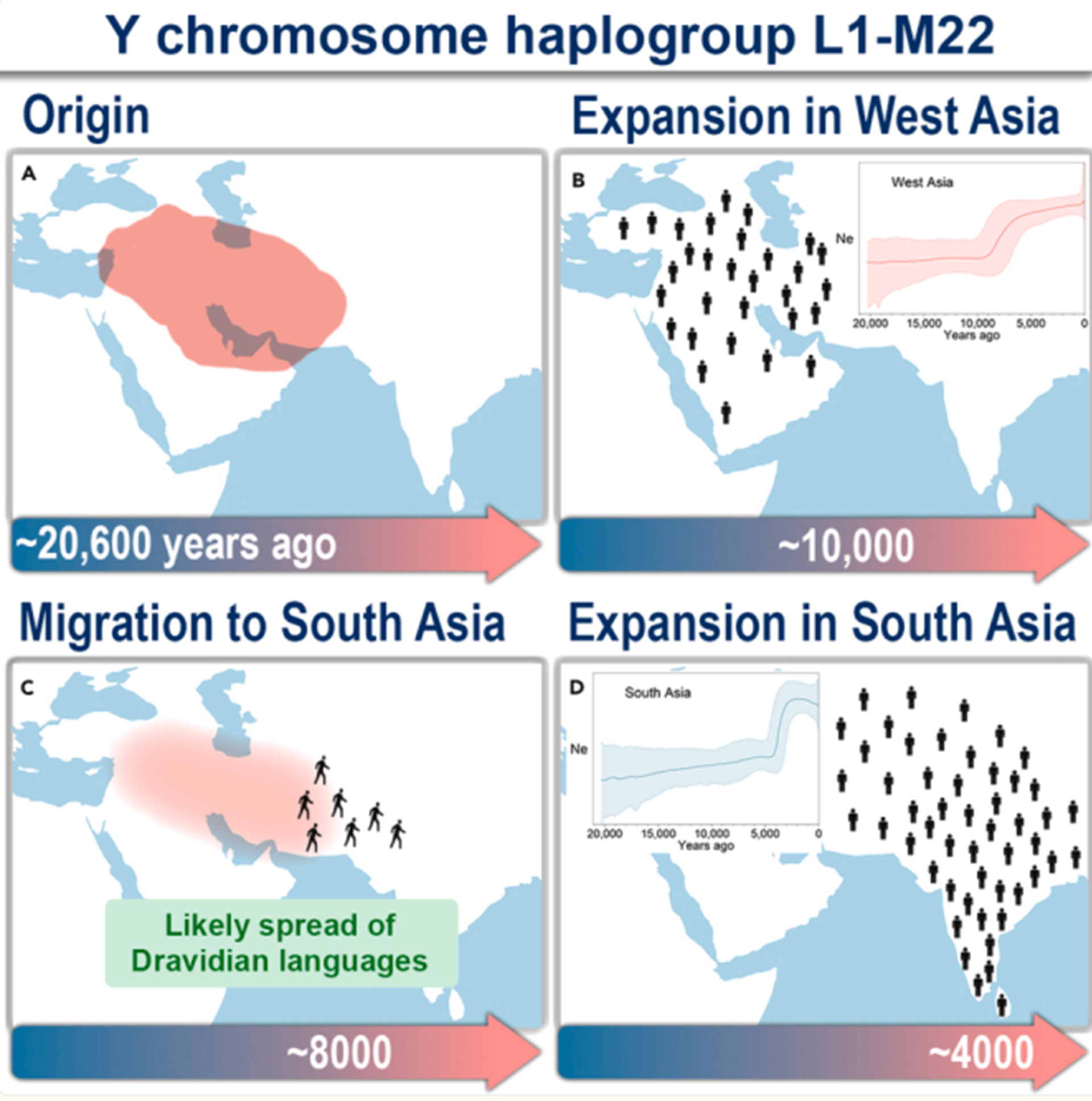
Human Y chromosome haplogroup L1-M22 traces Neolithic expansion in West Asia and supports the Elamite and Dravidian connection
“West and South Asian populations profoundly influenced Eurasian genetic and cultural diversity. We investigate the genetic history of the Y chromosome haplogroup L1-M22, which, while prevalent in these regions, lacks in-depth study. Robust Bayesian analyses of 165 high-coverage Y chromosomes favor a West Asian origin for L1-M22 ∼20,600 years ago. Moreover, this haplogroup parallels the genome-wide genetic ancestry of hunter-gatherers from the Iranian Plateau and the Caucasus. We characterized two L1-M22 harboring population groups during the Early Holocene. One expanded with the West Asian Neolithic transition. The other moved to South Asia ∼8,000-6,000 years ago but showed no expansion. This group likely participated in the spread of Dravidian languages. These South Asian L1-M22 lineages expanded ∼4,000-3,000 years ago, coinciding with the Steppe ancestry introduction. Our findings advance the current understanding of Eurasian historical dynamics, emphasizing L1-M22’s West Asian origin, associated population movements, and possible linguistic impacts.” ref
After looking at the info, I think Afroasiatic is likely the related origin of Dravidian languages, so an Afro-Dravidian Hypothesis. That still fits with my main Proto-North Eurasian Hypothesis, which I think links Afroasiatic. I think it was the likely language in Iran hunter-gatherer/proto-farmers R1b, L, and J, possibly even R1a, and thus, to me, would likely speak Afroasiatic or some version of it as they share a lot of cultural aspects with Turkey and the wider Fertal Cresent that spoke Afroasiatic. It is their cultural ideas and haplogroup L1-M22 that relate to Mehrgarh (7000 BCE to 2600 BCE) and Iran.
Here is a link, not mine, addressing it, but this is not how I came to think about this possibility of an Afro-Dravidian Hypothesis: Afroasiatic Origins and the Afro-Dravidian Hypothesis:
“The Afro-Dravidian hypothesis argues that the Dravidian language is a derivative of an African language from the Niger-Congo family of languages, and that much of the cultural and technological packet associated with Dravidian culture has African origins. Frenchman Bernard Sargent is one of its principle advocates. I’m not entirely convinced of this hypotheis, but there is enough data to back it up to warrant giving the idea serious consideration, so I don’t dismiss it out of hand either, as many do.” ref
“The linguistic evidence from within the Dravidian languages points to an origin of the Dravidian language of India around the time of the South Asian Neolithic ca. 2500 BCE. A few linguists have noted similarities between some Niger-Congo languages (particularly those on the Afro-Asiatic/Niger-Congo boundary area) and the proto-Dravidian language.
The crops used in early Dravidian agriculture were domesticated in and had their origins the African Sahel. There are no meaningful African mtDNA traces in Dravidian South Asia that can’t be attributed to events in the historic era, however, and the strongest outside Y-DNA signal, which coincides quite well with the locations of the proto-Dravidan society are rich in Y-DNA haplogroup T.” ref
“Given the fact that ancient peoples rich in Y-DNA haplogroup T were sailing the Red Sea and Indian Ocean from the Horn of Africa at the time, it makes sense that a male dominated group of people from the Horn of Africa might arrived on the east coast of India and bring new crops and technologies around 2500 BCE. Recent genetic profiles of tribal populations in India also support the inferrence that some of these populations may have genetic origins outside India in a time frame similar to that of the arrival of Indo-European and Austroasiatic food production and archeological cultures to India, rather than with the hunter-gatherers of India’s deep indigeneous past. So, the fact that some of the high frequency Y-DNA haplogroup T populations in Indian are tribal populations doesn’t necessarily contradict an Afro-Dravidian hypothesis.” ref
“The crops, technologies and potential linguistic links seem like a better fit to a Sahel agriculture, Niger-Congo language speaking people, however, than to a society that one might expect to be a Cushitic language speaking people then and there in what might have been the Kingdom of Punt or the Kingdom of Cush, which Y-DNA haplogroup T is currently common, and haplogroup T arguably looks like it has Egyptian or Mesopotamian origins, not Sahel African origins. Why would people with overwhelming Egyptian/Mesopotamian patrilines speak a Niger-Congo language or be familiar with Sahel agriculture? Was Cushitic limited to areas further north at the time, and were Niger-Congo languages (driven by the expansion of Sahel agriculture) a layer present before Afro-Asiatic languages were in the Horn of Africa? Did ethnic Egyptians precede the Cushitic language in the sea trade of the Horn of Africa?” ref
“The “substrate” genetics of East Africa after one removes markers that look like Eurasian back migrations and also removes markers strongly associated with one or another Afro-Asiatic linguistic family, in uniparental and autosomal genetics, are distinctly East African and do not suggest prior genetic unity with West African populations prior to a very remote date (ca. 30,000+ years). Another way to think about that fact is that East Africa has experienced at least two wave of Eurasian back migration. Sometime in the early Holocene (a period that bridges the Epipaleolithic and the Neolithic eras) associated with mtDNA haplogroups like M1 and U6. The other with the arrival of the Ethiosemitic languages. One plausible way to understand the spread of the Afro-Asiatic languages is to guess that it occured at the time of the early Holocene event.” ref
“But, East Africa has a distinct genetic identity that predates either of these events, and this identity is distinct from West Africa. West African sourced African genetics don’t appear in East Africa until around the time of Bantu expansion into East Africa, contradicting the plausible thought that West Africans could have had notable demic influences on East Africa starting when the West Africans developed Sahel agriculture. (As Jared Diamond explains in “Guns, Germs and Steel”, neither Sahel crops nor Fertile Crescent crops do well in the other’s climate due to their differing seasonal patterns, although Sahel crops can do well in the monsoon climate of Southern India, which has a seasonal pattern similar to the African Sahel.)” ref
“One possibility is that Horn of Africa people who could have brought the cultural package of Sahel agriculture to India may have themselves been recent recipients of that cultural package and experienced language shift in an early wave of Bantu, or pre-Bantu, expansion from West Africa, that was limited to a cultural/political elite and that the Niger-Congo language may have experienced similar linguistic trends to other languages on the Niger-Congo/Afro-Asiatic linguistic border like Swahili and some of the Niger-Congo languages spoken in the general vicinity of Senegal.” ref
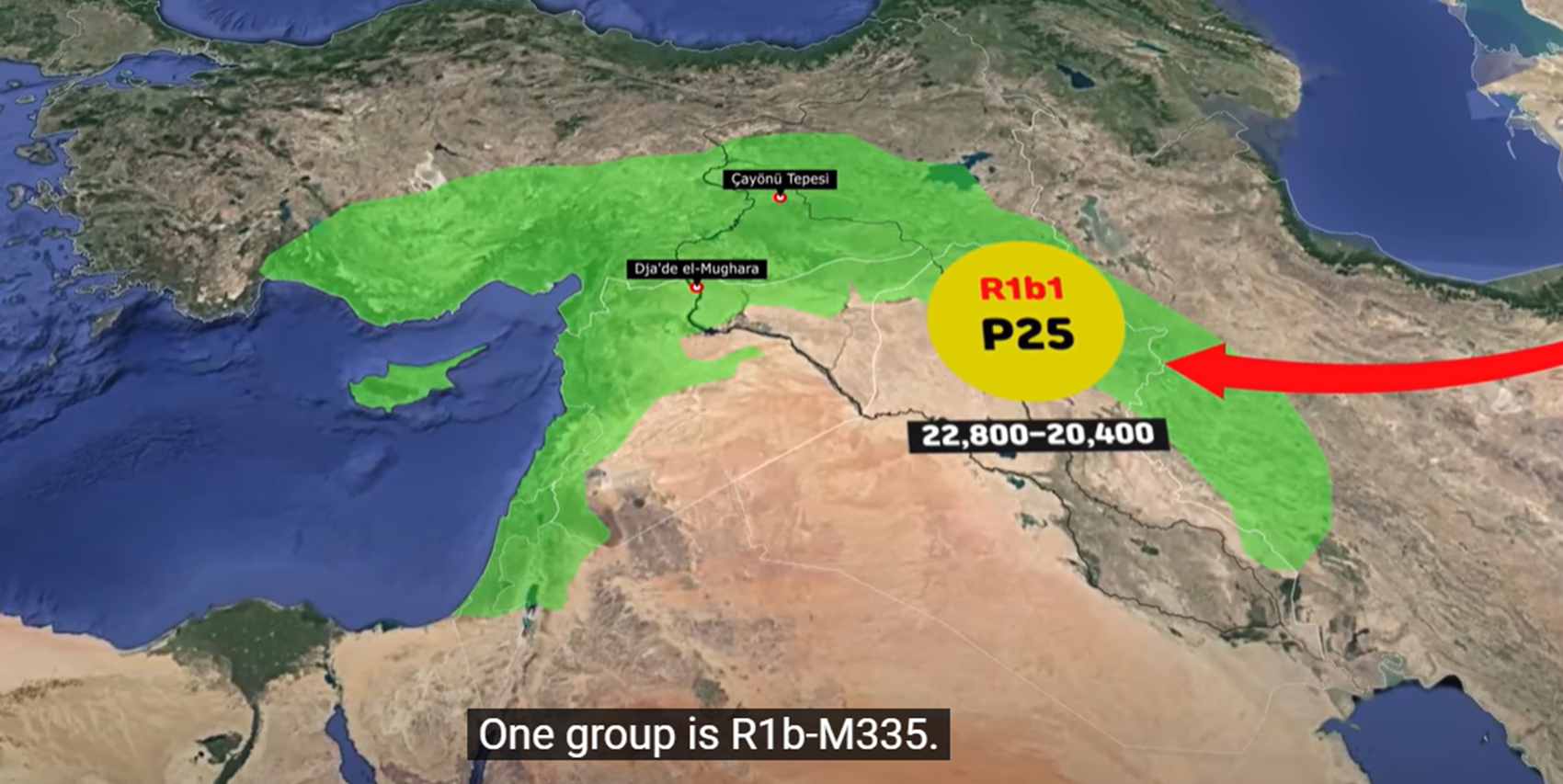

Are the people in Africa’s R1b European? (R1b-V88) https://www.youtube.com/watch?v=WGwApjdDy6M
Haplogroup R1b
“According to ancient DNA studies, most R1a and R1b lineages would have expanded from the Caspian Sea along with the Indo-European languages and shared religious ideas. The Proto-Indo-European religious beliefs includes a number of securely reconstructed deities, since they are both cognates – linguistic siblings from a common origin – and associated with similar attributes and body of myths: such as *Dyḗws Ph₂tḗr, the daylight-sky god; his consort *Dʰéǵʰōm, the earth mother; his daughter *H₂éwsōs, the dawn goddess; his sons the Divine Twins; and *Seh₂ul, a solar goddess. Some deities, like the weather god *Perkʷunos or the herding-god *Péh₂usōn.” ref, ref
“Haplogroup R1b is the most frequently occurring paternal lineage in Western Europe, as well as some parts of Russia (e.g. the Bashkirs) and pockets of Central Africa (e.g. parts of Chad and among the Chadic-speaking minority ethnic groups of Cameroon). The clade is also present at lower frequencies throughout Eastern Europe, Western Asia, as well as parts of North Africa, South Asia and Central Asia. R1b has two primary branches: R1b1-L754 and R1b2-PH155. R1b1-L754 has two major subclades: R1b1a1b-M269, which predominates in Western Europe, and R1b1b-V88, which is today common in parts of Central Africa.” ref

Basic phylogenetic tree for R1b
R1b1b (R-V88)
“R1b1b (PF6279/V88; previously R1b1a2) is defined by the presence of SNP marker V88, the discovery of which was announced in 2010 by Cruciani et al. Apart from individuals in southern Europe and Western Asia, the majority of R-V88 was found in the Sahel, especially among populations speaking Afroasiatic languages of the Chadic branch.” ref
“Studies in 2005–08 reported “R1b*” at high levels in Jordan, Egypt and Sudan. Subsequent research by Myres et al. (2011) indicates that the samples concerned most likely belong to the subclade R-V88, which is now concentrated in Sub-Saharan Africa. According to Myres et al. (2011), this may be explained by a back-migration from Asia into Africa by R1b-carrying people. Gonzales et al. (2013), using more advanced techniques, indicate that it is equally probable that V88 originated in Central Africa and spread northward towards Asia. The patterns of diversity in African R1b-V88 did not seem to fit with a movement of Chadic-speaking people from the North, across the Sahara to West-Central Africa, but was compatible with the reverse. An origin of V88 lineages in Central Africa, followed by a migration to North Africa. However, Shriner, D., & Rotimi, C. N. (2018), associate the introduction of R1b into Chad, with the more recent movements of Baggara Arabs.” ref
“D’Atanasio et al. (2018) propose that R1b-V88 originated in Europe about 12,000 years ago and crossed to North Africa by about 8,000 years ago; it may formerly have been common in southern Europe, where it has since been replaced by waves of other haplogroups, leaving remnant subclades almost exclusively in Sardinia. It first radiated within Africa likely between 7 and 8 000 years ago – at the same time as trans-Saharan expansions within the unrelated haplogroups E-M2 and A-M13 – possibly due to population growth allowed by humid conditions and the adoption of livestock herding in the Sahara. R1b-V1589, the main subclade within R1b-V88, underwent a further expansion around 5,500 years ago, likely in the Lake Chad Basin region, from which some lines recrossed the Sahara to North Africa.” ref
“Marcus et al. (2020) provide strong evidence for this proposed model of North to South trans-saharan movement: The earliest basal R1b-V88 haplogroups are found in several Eastern European Hunter Gatherers close to 10,000 years ago. The haplogroup then seemingly further spread with the Neolithic Cardial Ware expansion, which established agriculture in the Western Mediterranean around 7,500 years ago: R1b-V88 haplogroups were identified in ancient Neolithic individuals in central Italy, Iberia and, at a particularly high frequency, in Sardinia. A part of the branch leading to present-day African haplogroups (V2197) is already derived in some of these ancient Neolithic European individuals, providing further support for a North to South trans-saharan movement.” ref
Distribution of R-V88 in Africa Central Sahel Region is 23.0% and in Northern Africa 5.2%
“The Sahel part of Africa includes – from west to east – parts of northern Senegal, southern Mauritania, central Mali, northern Burkina Faso, the extreme south of Algeria, Niger, the extreme north of Nigeria, Cameroon and Central African Republic, central Chad, central and southern Sudan, the extreme north of South Sudan, Eritrea and Ethiopia. As can be seen in the data table, R-V88 is found in northern Cameroon in west central Africa at a very high frequency, where it is considered to be caused by a pre-Islamic movement of people from Eurasia.” ref, ref
Ouldeme people of Cameroon speaking the Chadic and Afro-Asiatic languages are R-V88 as high as 95.5%
Mafa people of Cameroon speaking the Chadic and Afro-Asiatic languages are R-V88 as high as 87.5%
Mada people of Cameroon speaking the Chadic and Afro-Asiatic languages are R-V88 as high as 82.4%
Guiziga people of Cameroon speaking the Chadic and Afro-Asiatic languages are R-V88 as high as 77.8%
Guidar people of Cameroon speaking the Chadic and Afro-Asiatic languages are R-V88 as high as 66.7%
Moundang people of Cameroon speaking the Niger–Congo and Adamawa languages are R-V88 as high as 66.7%
Daba people of Cameroon speaking the Chadic and Afro-Asiatic languages are R-V88 as high as 42.1%
Shuwa Arab people of Cameroon speaking the Semitic and Afro-Asiatic languages are R-V88 as high as 40.0%
Massa people of Cameroon speaking the Chadic and Afro-Asiatic languages are R-V88 as high as 28.6%
Berbers from Siwa people of Egypt speaking the Berber and Afro-Asiatic languages are R-V88 as high as 28.6%
Fali people of Cameroon speaking the the Niger–Congo and Adamawa languages are R-V88 as high as 20.8% ref


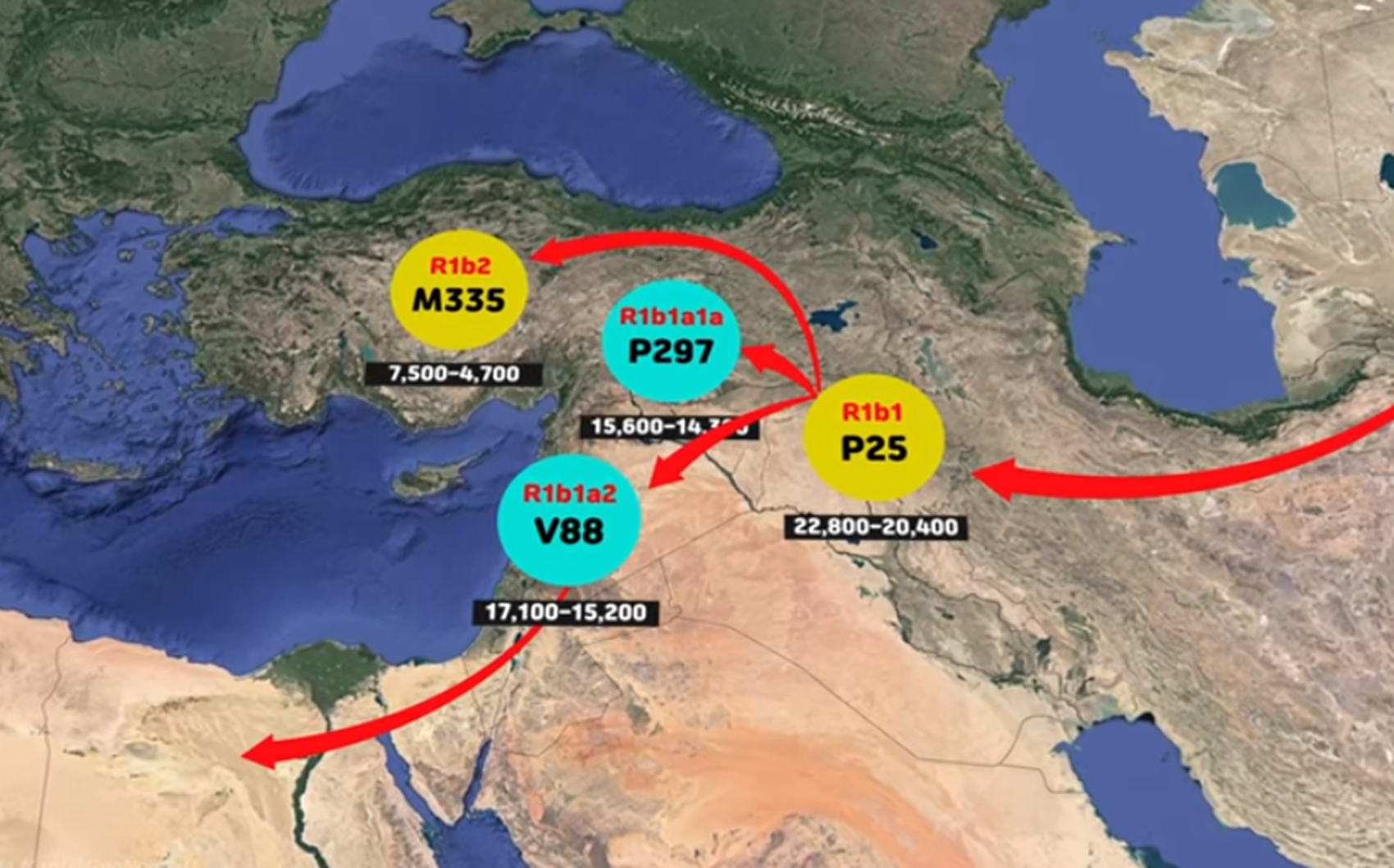
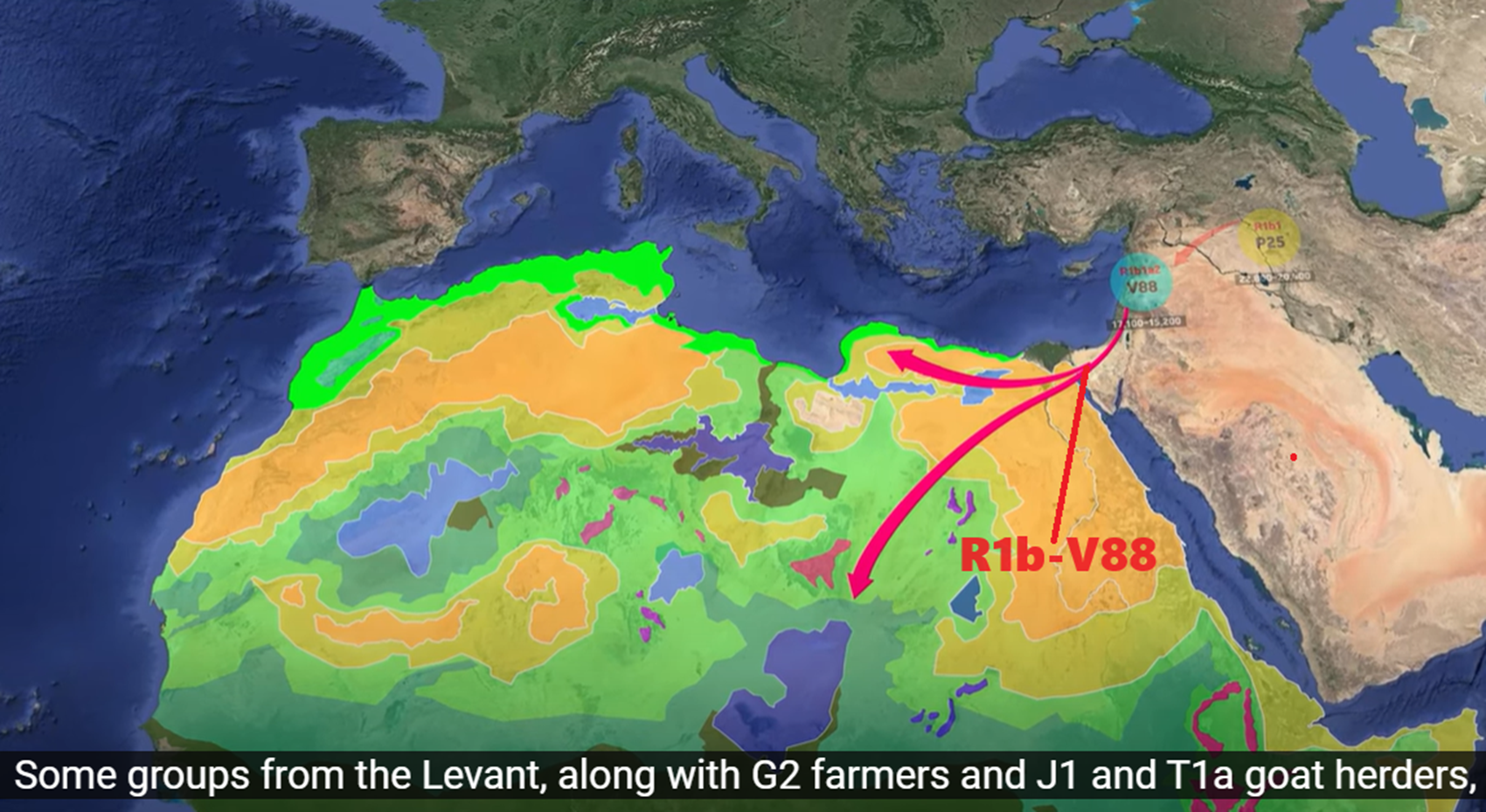
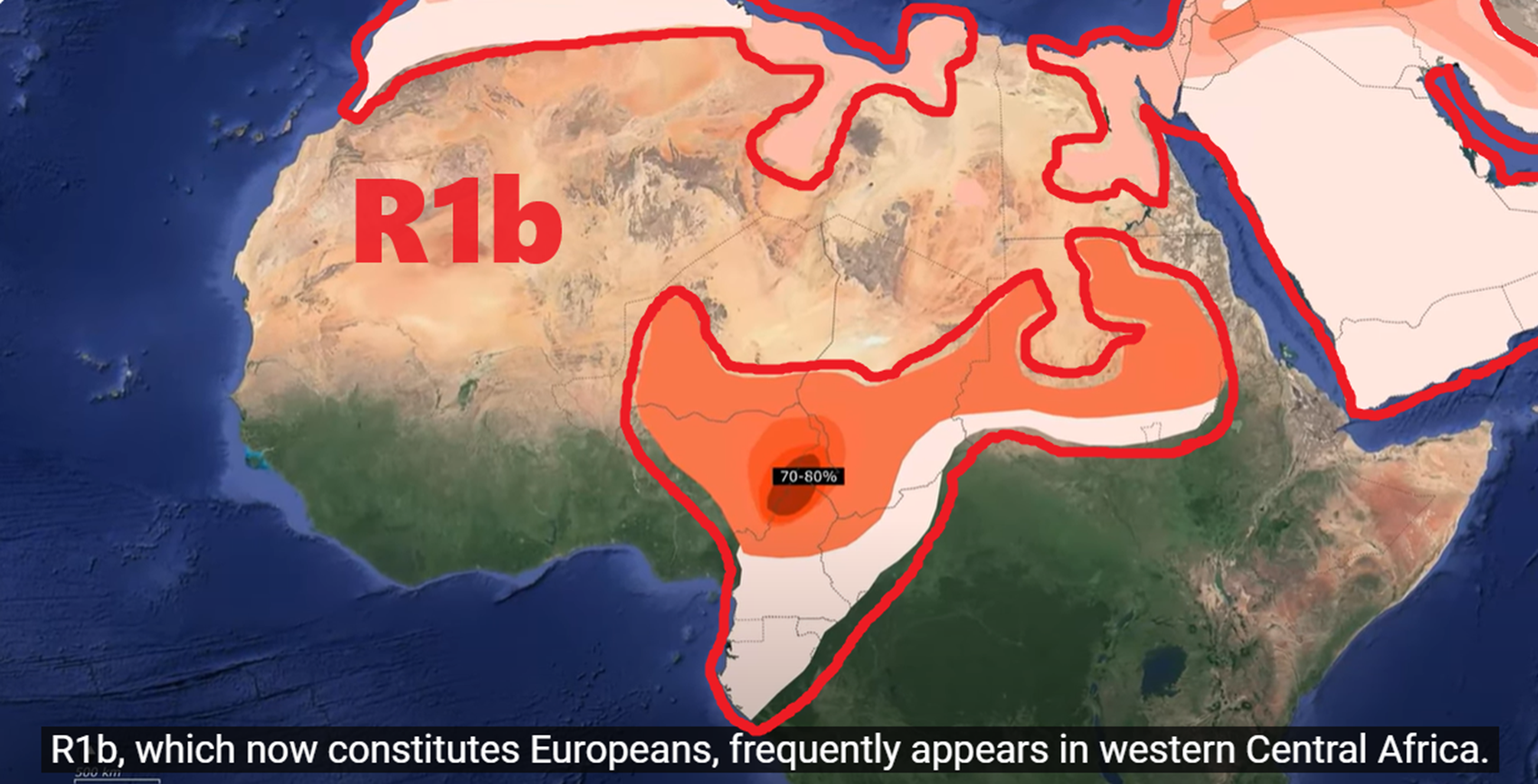
“Migration from Siberia behind the formation of Göbeklitepe: Expert states. People who migrated from Siberia formed the Göbeklitepe, and those in Göbeklitepe migrated in five other ways to spread to the world, said experts about the 12,000-year-old Neolithic archaeological site in the southwestern province of Şanlıurfa.“ The upper paleolithic migrations between Siberia and the Near East is a process that has been confirmed by material culture documents,” he said.” ref
“Semih Güneri, a retired professor from Caucasia and Central Asia Archaeology Research Center of Dokuz Eylül University, and his colleague, Professor Ekaterine Lipnina, presented the Siberia-Göbeklitepe hypothesis they have developed in recent years at the congress held in Istanbul between June 11 and 13. There was a migration that started from Siberia 30,000 years ago and spread to all of Asia and then to Eastern and Northern Europe, Güneri said at the international congress.” ref
“The relationship of Göbeklitepe high culture with the carriers of Siberian microblade stone tool technology is no longer a secret,” he said while emphasizing that the most important branch of the migrations extended to the Near East. “The results of the genetic analyzes of Iraq’s Zagros region confirm the traces of the Siberian/North Asian indigenous people, who arrived at Zagros via the Central Asian mountainous corridor and met with the Göbeklitepe culture via Northern Iraq,” he added.” ref
“Emphasizing that the stone tool technology was transported approximately 7,000 kilometers from east to west, he said, “It is not clear whether this technology is transmitted directly to long distances by people speaking the Turkish language at the earliest, or it travels this long-distance through using way stations.” According to the archaeological documents, it is known that the Siberian people had reached the Zagros region, he said. “There seems to be a relationship between Siberian hunter-gatherers and native Zagros hunter-gatherers,” Güneri said, adding that the results of genetic studies show that Siberian people reached as far as the Zagros.” ref
“There were three waves of migration of Turkish tribes from the Southern Siberia to Europe,” said Osman Karatay, a professor from Ege University. He added that most of the groups in the third wave, which took place between 2600-2400 BCE, assimilated and entered the Germanic tribes and that there was a genetic kinship between their tribes and the Turks. The professor also pointed out that there are indications that there is a technology and tool transfer from Siberia to the Göbeklitepe region and that it is not known whether people came, and if any, whether they were Turkish.” ref
“Around 12,000 years ago, there would be no ‘Turks’ as we know it today. However, there may have been tribes that we could call our ‘common ancestors,’” he added. “Talking about 30,000 years ago, it is impossible to identify and classify nations in today’s terms,” said Murat Öztürk, associate professor from İnönü University. He also said that it is not possible to determine who came to where during the migrations that were accepted to have been made thousands of years ago from Siberia. On the other hand, Mehmet Özdoğan, an academic from Istanbul University, has an idea of where “the people of Göbeklitepe migrated to.” ref
“According to Özdoğan, “the people of Göbeklitepe turned into farmers, and they could not stand the pressure of the overwhelming clergy and started to migrate to five ways.” “Migrations take place primarily in groups. One of the five routes extends to the Caucasus, another from Iran to Central Asia, the Mediterranean coast to Spain, Thrace and [the northwestern province of] Kırklareli to Europe and England, and one route is to Istanbul via [Istanbul’s neighboring province of] Sakarya and stops,” Özdoğan said. In a very short time after the migration of farmers in Göbeklitepe, 300 settlements were established only around northern Greece, Bulgaria, and Thrace. “Those who remained in Göbeklitepe pulled the trigger of Mesopotamian civilization in the following periods, and those who migrated to Mesopotamia started irrigated agriculture before the Sumerians,” he said.” ref

12,000-year-old Gobekli Tepe: “first human-made pagan temple”
Just think of the kind and amount of religious faith one would need to build such a site as this. Speaking of building, one of the most fascinating facts about this site is that they didn’t have the wheel nor metal tools. All they had were stone tools and little else.
- Epipalaeolithic Near East 20,000 to 9,000 years ago and the Emergence of Advanced Culture as well as New Religion?
- Epigravettians Join the Religious Partying at Gobekli Tepe?
- Gobekli Tepe is more like Shamanistic early Paganism, Not Adam, Eve, and Cain or Bible anything!
- Male-Homosexual (female-like) / Trans-woman (female) Seated Figurine from Gobekli Tepe
- Alcohol, where Agriculture and Religion Become one? Such as Gobekli Tepe’s Ritualistic use of Grain as Food and Ritual Drink
- Ritualistic Bird Symbolism at Gobekli Tepe and its “Ancestor Cult”
- Göbekli Tepe 12,000 years old T-shaped Pillars are not Alone (not Ancient Aliens)
- Could a 12,000-year-old Bull Geoglyph at Göbekli Tepe relate to older Bull and Female Art 25,000 years ago and Later Goddess and the Bull cults like Catal Huyuk?
- The Gravettian culture (Europe) shared ritual ideas and The Ancient North Eurasian culture (Asia) 24,000 years ago
- Are the Natufians of Israel around 15,000 to 11,500 years ago who you thought they were?
- 12,400 – 11,700 Years Ago – Kortik Tepe (Turkey) Pre/early-Agriculture Cultic Ritualism
- Pre-Pottery Neolithic (10000 – 6500 BCE) and Pottery Neolithic (7000–5000 BCE)
- Masked Head Hunters of “Karahan Tepe” 11,400-year-old monumental site from the Pre-Pottery Neolithic A to B
“Haplogroup R* originated in North Asia just before the Last Glacial Maximum (26,500-19,000 years ago). This haplogroup has been identified in the remains of a 24,000 year-old boy from the Altai region, in south-central Siberia (Raghavan et al. 2013). This individual belonged to a tribe of mammoth hunters that may have roamed across Siberia and parts of Europe during the Paleolithic. Autosomally this Paleolithic population appears to have contributed mostly to the ancestry of modern Europeans and South Asians, the two regions where haplogroup R also happens to be the most common nowadays (R1b in Western Europe, R1a in Eastern Europe, Central and South Asia, and R2 in South Asia).” ref
“The oldest forms of R1b (M343, P25, L389) are found dispersed at very low frequencies from Western Europe to India, a vast region where could have roamed the nomadic R1b hunter-gatherers during the Ice Age. The three main branches of R1b1 (R1b1a, R1b1b, R1b1c) all seem to have stemmed from the Middle East. The southern branch, R1b1c (V88), is found mostly in the Levant and Africa. The northern branch, R1b1a (P297), seems to have originated around the Caucasus, eastern Anatolia or northern Mesopotamia, then to have crossed over the Caucasus, from where they would have invaded Europe and Central Asia. R1b1b (M335) has only been found in Anatolia.” ref
“It has been hypothesized that R1b people (perhaps alongside neighboring J2 tribes) were the first to domesticate cattle in northern Mesopotamia some 10,500 years ago. R1b tribes descended from mammoth hunters, and when mammoths went extinct, they started hunting other large game such as bisons and aurochs. With the increase of the human population in the Fertile Crescent from the beginning of the Neolithic (starting 12,000 years ago), selective hunting and culling of herds started replacing indiscriminate killing of wild animals. The increased involvement of humans in the life of aurochs, wild boars, and goats led to their progressive taming. Cattle herders probably maintained a nomadic or semi-nomadic existence, while other people in the Fertile Crescent (presumably represented by haplogroups E1b1b, G, and T) settled down to cultivate the land or keep smaller domesticates.” ref
“The analysis of bovine DNA has revealed that all the taurine cattle (Bos taurus) alive today descend from a population of only 80 aurochs. The earliest evidence of cattle domestication dates from circa 8,500 BCE in the Pre-Pottery Neolithic cultures in the Taurus Mountains. The two oldest archaeological sites showing signs of cattle domestication are the villages of Çayönü Tepesi in southeastern Turkey and Dja’de el-Mughara in northern Iraq, two sites only 250 km away from each others. This is presumably the area from which R1b lineages started expanding – or in other words the “original homeland” of R1b.” ref
“The early R1b cattle herders would have split in at least three groups. One branch (M335) remained in Anatolia, but judging from its extreme rarity today wasn’t very successful, perhaps due to the heavy competition with other Neolithic populations in Anatolia, or to the scarcity of pastures in this mountainous environment. A second branch migrated south to the Levant, where it became the V88 branch. Some of them searched for new lands south in Africa, first in Egypt, then colonizing most of northern Africa, from the Mediterranean coast to the Sahel. The third branch (P297), crossed the Caucasus into the vast Pontic-Caspian Steppe, which provided ideal grazing grounds for cattle. They split into two factions: R1b1a1 (M73), which went east along the Caspian Sea to Central Asia, and R1b1a2 (M269), which at first remained in the North Caucasus and the Pontic Steppe between the Dnieper and the Volga. It is not yet clear whether M73 actually migrated across the Caucasus and reached Central Asia via Kazakhstan, or if it went south through Iran and Turkmenistan. In any case, M73 would be a pre-Indo-European branch of R1b, just like V88 and M335.” ref
“R1b-M269 (the most common form in Europe) is closely associated with the diffusion of Indo-European languages, as attested by its presence in all regions of the world where Indo-European languages were spoken in ancient times, from the Atlantic coast of Europe to the Indian subcontinent, which comprised almost all Europe (except Finland, Sardinia and Bosnia-Herzegovina), Anatolia, Armenia, European Russia, southern Siberia, many pockets around Central Asia (notably in Xinjiang, Turkmenistan, Tajikistan and Afghanistan), without forgetting Iran, Pakistan, northern India and Nepal. The history of R1b and R1a are intricately connected to each others.” ref
The Levantine & African branch of R1b (V88)
“Like its northern counterpart (R1b-M269), R1b-V88 is associated with the domestication of cattle in northern Mesopotamia. Both branches of R1b probably split soon after cattle were domesticated, approximately 10,500 years ago (8,500 BCE). R1b-V88 migrated south towards the Levant and Egypt. The migration of R1b people can be followed archeologically through the presence of domesticated cattle, which appear in central Syria around 8,000-7,500 BCE (late Mureybet period), then in the Southern Levant and Egypt around 7,000-6,500 BCE (e.g. at Nabta Playa and Bir Kiseiba). Cattle herders subsequently spread across most of northern and eastern Africa. The Sahara desert would have been more humid during the Neolithic Subpluvial period (c. 7250-3250 BCE), and would have been a vast savannah full of grass, an ideal environment for cattle herding.” ref
“Evidence of cow herding during the Neolithic has shown up at Uan Muhuggiag in central Libya around 5500 BCE, at the Capeletti Cave in northern Algeria around 4500 BCE. But the most compelling evidence that R1b people related to modern Europeans once roamed the Sahara is to be found at Tassili n’Ajjer in southern Algeria, a site famous pyroglyphs (rock art) dating from the Neolithic era. Some painting dating from around 3000 BCE depict fair-skinned and blond or auburn haired women riding on cows. The oldest known R1b-V88 sample in Europe is a 6,200 year-old farmer/herder from Catalonia tested by Haak et al. (2015). Autosomally this individual was a typical Near Eastern farmer, possessing just a little bit of Mesolithic West European admixture.” ref
“After reaching the Maghreb, R1b-V88 cattle herders could have crossed the Strait of Gibraltar to Iberia, probably accompanied by G2 farmers, J1 and T1a goat herders. These North African Neolithic farmers/herders could have been the ones who established the Almagra Pottery culture in Andalusia in the 6th millennium BCE.” ref
“Nowadays small percentages (1 to 4%) of R1b-V88 are found in the Levant, among the Lebanese, the Druze, and the Jews, and almost in every country in Africa north of the equator. Higher frequency in Egypt (5%), among Berbers from the Egypt-Libya border (23%), among the Sudanese Copts (15%), the Hausa people of Sudan (40%), the the Fulani people of the Sahel (54% in Niger and Cameroon), and Chadic tribes of northern Nigeria and northern Cameroon (especially among the Kirdi), where it is observed at a frequency ranging from 30% to 95% of men. According to Cruciani et al. (2010) R1b-V88 would have crossed the Sahara between 9,200 and 5,600 years ago, and is most probably associated with the diffusion of Chadic languages, a branch of the Afroasiatic languages. V88 would have migrated from Egypt to Sudan, then expanded along the Sahel until northern Cameroon and Nigeria. However, R1b-V88 is not only present among Chadic speakers, but also among Senegambian speakers (Fula-Hausa) and Semitic speakers (Berbers, Arabs).” ref
“R1b-V88 is found among the native populations of Rwanda, South Africa, Namibia, Angola, Congo, Gabon, Equatorial Guinea, Ivory Coast, Guinea-Bissau. The wide distribution of V88 in all parts of Africa, its incidence among herding tribes, and the coalescence age of the haplogroup all support a Neolithic dispersal. In any case, a later migration out of Egypt would be improbable since it would have brought haplogroups that came to Egypt during the Bronze Age, such as J1, J2, R1a or R1b-L23. The maternal lineages associated with the spread of R1b-V88 in Africa are mtDNA haplogroups J1b, U5 and V, and perhaps also U3 and some H subclades (=> see Retracing the mtDNA haplogroups of the original R1b people).” ref
R1b-v88 haplogroup
“According to ancient DNA studies, most R1a and R1b lineages would have expanded from the Pontic Steppe along with the Indo-European languages. Analysis of ancient Y-DNA from the remains from early Neolithic Central and North European Linear Pottery culture settlements have not yet found males belonging to haplogroup R1b-M269. Olalde et al. (2017) trace the spread of haplogroup R1b-M269 in western Europe, particularly Britain, to the spread of the Beaker culture, with a sudden appearance of many R1b-M269 haplogroups in Western Europe ca. 5000–4500 years BP during the early Bronze Age. Two branches of R-V88, R-M18 and R-V35, are found almost exclusively on the island of Sardinia. As can be seen in the above data table, R-V88 is found in northern Cameroon in west central Africa at a very high frequency, where it is considered to be caused by a pre-Islamic movement of people from Eurasia.” ref
R1b1b (R-V88)
“R1b1b (PF6279/V88; previously R1b1a2) is defined by the presence of SNP marker V88, the discovery of which was announced in 2010 by Cruciani et al. Apart from individuals in southern Europe and Western Asia, the majority of R-V88 was found in the Sahel, especially among populations speaking Afroasiatic languages of the Chadic branch. Studies in 2005–08 reported “R1b*” at high levels in Jordan, Egypt and Sudan. Subsequent research by Myres et al. (2011) indicates that the samples concerned most likely belong to the subclade R-V88, which is now concentrated in Sub-Saharan Africa.” ref
“According to Myres et al. (2011), this may be explained by a back-migration from Asia into Africa by R1b-carrying people. Gonzales et al. (2013), using more advanced techniques, indicate that it is equally probable that V88 originated in Central Africa and spread northward towards Asia. The patterns of diversity in African R1b-V88 did not seem to fit with a movement of Chadic-speaking people from the North, across the Sahara to West-Central Africa, but was compatible with the reverse. An origin of V88 lineages in Central Africa, followed by a migration to North Africa. However, Shriner, D., & Rotimi, C. N. (2018), associate the introduction of R1b into Chad, with the more recent movements of Baggara Arabs.” ref
“D’Atanasio et al. (2018) propose that R1b-V88 originated in Europe about 12 000 years ago and crossed to North Africa by about 8000 years ago; it may formerly have been common in southern Europe, where it has since been replaced by waves of other haplogroups, leaving remnant subclades almost exclusively in Sardinia. It first radiated within Africa likely between 8000 and 7000 years ago – at the same time as trans-Saharan expansions within the unrelated haplogroups E-M2 and A-M13 – possibly due to population growth allowed by humid conditions and the adoption of livestock herding in the Sahara. R1b-V1589, the main subclade within R1b-V88, underwent a further expansion around 5500 years ago, likely in the Lake Chad Basin region, from which some lines recrossed the Sahara to North Africa.” ref
“Marcus et al. (2020) provide strong evidence for this proposed model of North to South trans-Saharan movement: The earliest basal R1b-V88 haplogroups are found in several Eastern European Hunter Gatherers close to 10,000 years ago. The haplogroup then seemingly further spread with the Neolithic Cardial Ware expansion, which established agriculture in the Western Mediterranean around 7500 years ago: R1b-V88 haplogroups were identified in ancient Neolithic individuals in central Italy, Iberia and, at a particularly high frequency, in Sardinia. A part of the branch leading to present-day African haplogroups (V2197) is already derived in some of these ancient Neolithic European individuals, providing further support for a North-to-South trans-Saharan movement.” ref
“Early human remains found to carry R1b include:
- Villabruna 1 (individual I9030), a Western Hunter-Gatherer (WHG), found in an Epigravettian culture setting in the Cismon valley (modern Veneto, Italy), who lived circa 14000 years ago and belonged to R1b1a.
- Several males of the Iron Gates Mesolithic in the Balkans buried between 11,200 to 8,200 years ago carried R1b1a1a. These individuals were determined to be largely of WHG ancestry, with slight Eastern Hunter-Gatherer (EHG) admixture.
- Several males of the Mesolithic Kunda culture and Neolithic Narva culture buried in the Zvejnieki burial ground in modern-day Latvia c. 9,500–6,000 years ago carried R1b1b. These individuals were determined to be largely of WHG ancestry, with slight EHG admixture.
- Several Mesolithic and Neolithic males buried at Deriivka and Vasil’evka in modern-day Ukraine c. 9500-7000 years ago carried R1b1a. These individuals were largely of EHG ancestry, with significant WHG admixture.
- A WHG male buried at Ostrovul Corbuli, Romania c. 8,700 years ago carried R1b1c.
- A male buried at Lepenski Vir, Serbia c. 8,200-7,900 years ago carried R1b1a.
- An EHG buried near Samara, Russia 7,500 years ago carried R1b1a1a.
- An Eneolithic male buried at Khvalynsk, Russia c. 7,200-6,000 years ago carried R1b1a.
- A Neolithic male buried at Els Trocs, Spain c. 7,178-7,066 years ago, who may have belonged to the Epi-Cardial culture, was found to be a carrier of R1b1.
- A Late Chalcolithic male buried in Smyadovo, Bulgaria c. 6,500 years ago carried R1b1a.
- An Early Copper Age male buried in Cannas di Sotto, Carbonia, Sardinia c. 6,450 years ago carried R1b1b2.
- A male of the Baalberge group in Central Europe buried c. 5,600 years ago carried R1b1a.
- A male of the Botai culture in Central Asia buried c. 5,500 years ago carried R1b1a1 (R1b-M478).
- 7 males that were tested of the Yamnaya culture were all found to belong to the M269 subclade of haplogroup R1b.” ref
“R1b is a subclade within the “macro-haplogroup“ K (M9), the most common group of human male lines outside of Africa. K is believed to have originated in Asia (as is the case with an even earlier ancestral haplogroup, F (F-M89). Karafet T. et al. (2014) “rapid diversification process of K-M526 likely occurred in Southeast Asia, with subsequent westward expansions of the ancestors of haplogroups R and Q.” ref
“Three genetic studies in 2015 gave support to the Kurgan hypothesis of Marija Gimbutas regarding the Proto-Indo-European homeland. According to those studies, haplogroups R1b-M269 and R1a, now the most common in Europe (R1a is also common in South Asia) would have expanded from the West Eurasian Steppe, along with the Indo-European languages; they also detected an autosomal component present in modern Europeans which was not present in Neolithic Europeans, which would have been introduced with paternal lineages R1b and R1a, as well as Indo-European languages.” ref

Pic ref
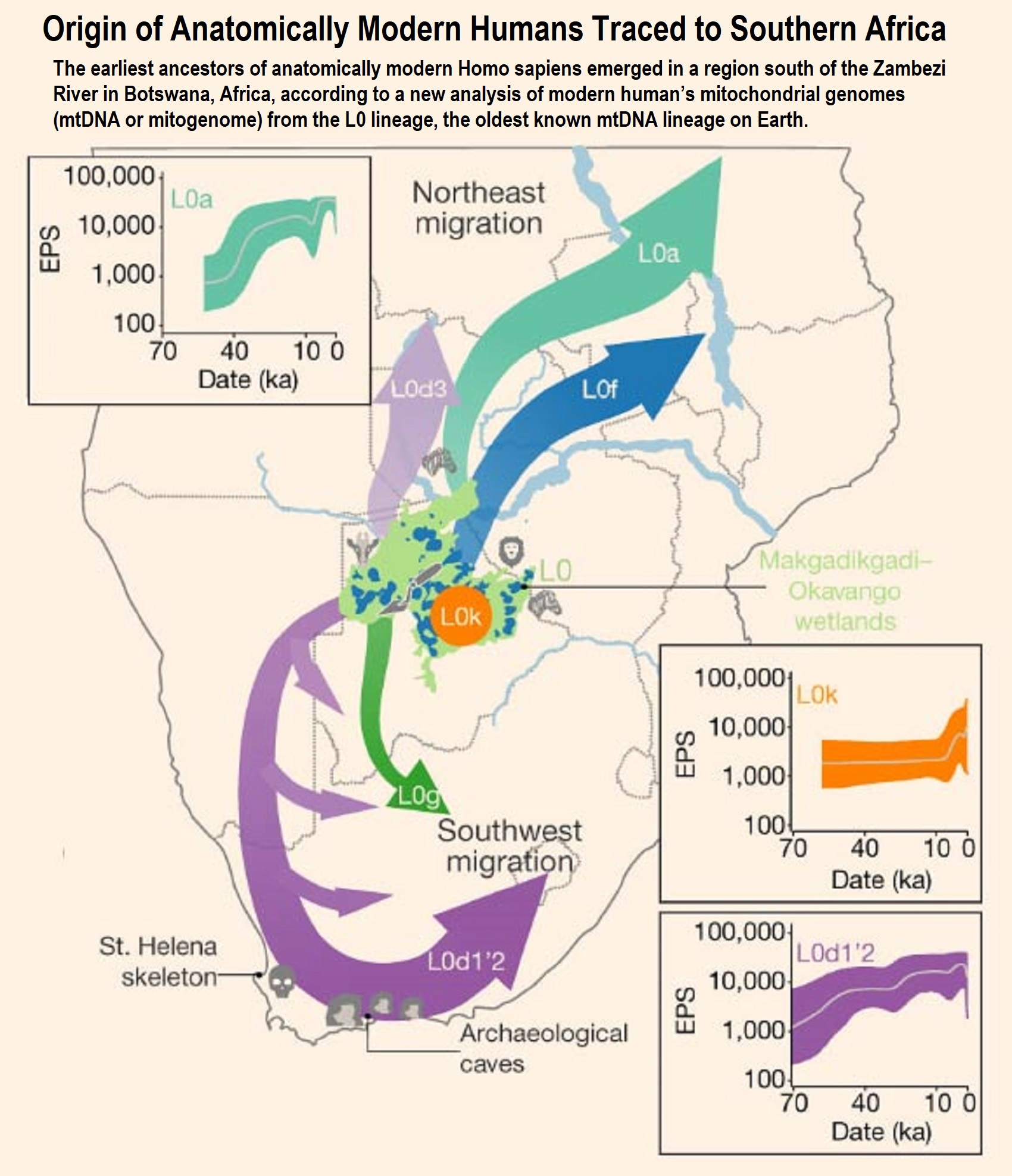
Pic ref
“The earliest ancestors of anatomically modern Homo sapiens emerged in a region south of the Zambezi River in Botswana, Africa, according to a new analysis of modern human’s mitochondrial genomes (mtDNA or mitogenome) from the L0 lineage, the oldest known mtDNA lineage on Earth.” ref
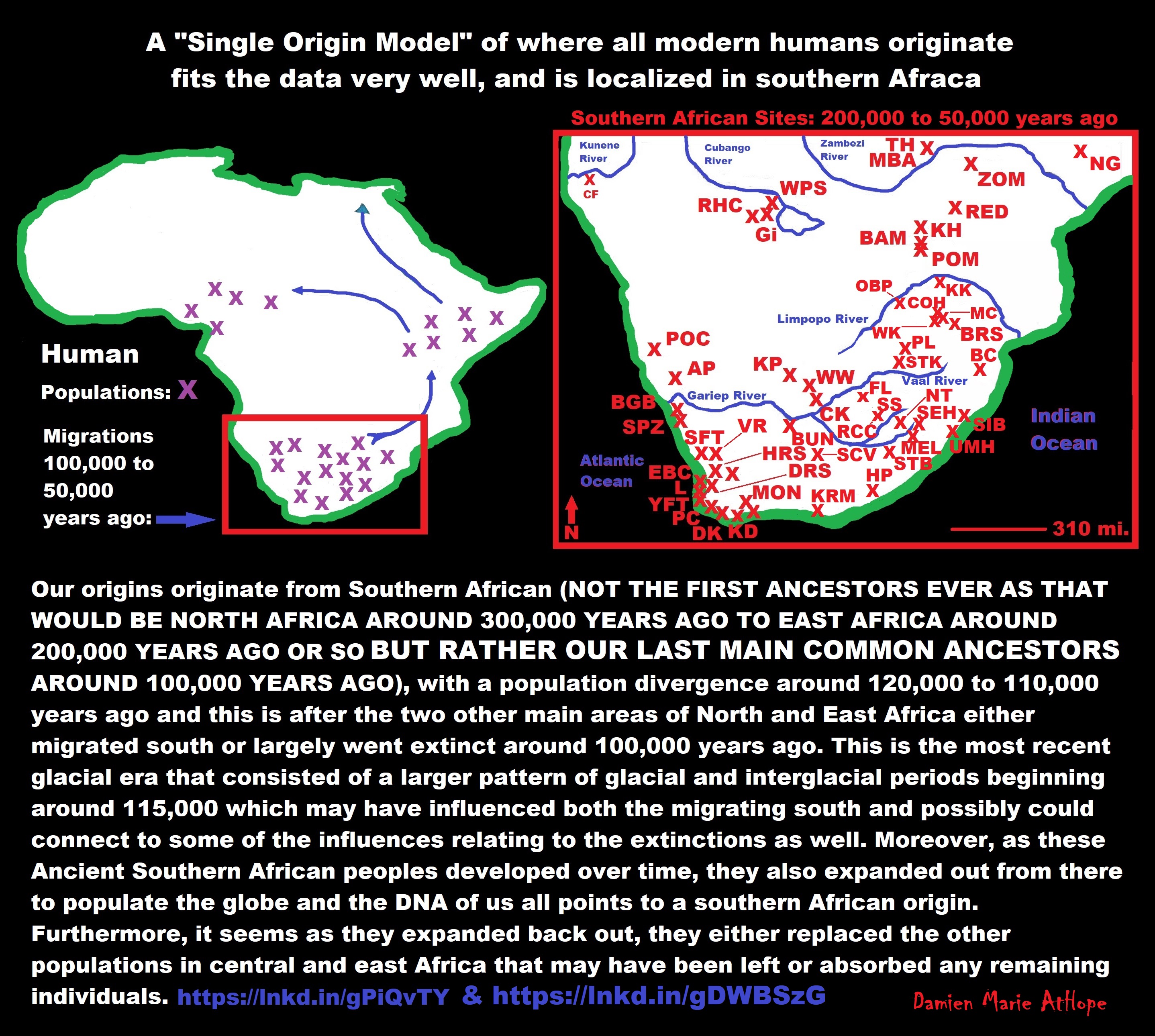
Our origins originate from Southern African (NOT THE FIRST ANCESTORS EVER AS THAT WOULD BE NORTH AFRICA AROUND 300,000 YEARS AGO TO EAST AFRICA AROUND 200,000 YEARS AGO OR SO BUT RATHER OUR LAST MAIN COMMON ANCESTORS AROUND 100,000 YEARS AGO), with a population divergence around 120,000 to 110,000 years ago and this is after the two other main areas of North and East Africa either migrated south or largely went extinct around 100,000 years ago. This is the most recent glacial era that consisted of a larger pattern of glacial and interglacial periods beginning around 115,000 which may have influenced both the migrating south and possibly could connect to some of the influences relating to the extinctions as well. Moreover, as these Ancient Southern African peoples developed over time, they also expanded out from there to populate the globe, and the DNA of us all points to a southern African origin. Furthermore, it seems as they expanded back out, they either replaced the other populations in central and east Africa that may have been left or absorbed any remaining individuals. ref
Southern African Middle Stone Age sites:
(Ap) Apollo 11; (BAM) Bambata; (BBC) Blombos Cave; (BC) Border Cave; (BGB)Boegoeberg; (BPA) Boomplaas; (BRS) Bushman Rock Shelter; (BUN) Bundu Farm; (CF)Cufema Reach; (CK) Canteen Kopje; (COH) Cave of Hearths; (CSB) Cape St Blaize; (DK)Die Kelders Cave 1; (DRS) Diepkloof Rock Shelter; (EBC) Elands Bay Cave; (FL) Florisbad; (≠GI) ≠Gi; (HP) Howiesons Poort; (HRS) Hollow Rock Shelter; (KD) Klipdrift; (KKH) Klein Kliphuis; (KH) Khami; (KK) Kudu Koppie; (KP) Kathu Pan; (KRM) Klasies River Main Site; (L) Langebaan; (MBA) Mumbwa Caves; (MC) Mwulu’s Cave; (MEL)Melikane; (MON) Montagu Cave; (NBC) Nelson Bay Cave; (NG) Ngalue; (NT) Ntloana Tšoana; (OBP) Olieboomspoort; (PC) Peers Cave; (POC) Pockenbank; (PL) Plover’s Lake; (POM) Pomongwe; (PP) Pinnacle Point; (RCC) Rose Cottage Cave; (RED) Redcliff; (RHC) Rhino Cave; (SCV) Seacow Valley; (SFT) Soutfontein; (SEH) Sehonghong; (SIB)Sibudu Cave; (SPZ) Spitzkloof Rock Shelter; (SS) Sunnyside 1; (STB) Strathalan Cave B; (STK) Sterkfontein; (TR) Twin Rivers; (UMH) Umhlatuzana; (VR) Varsche Rivier 003; (WPS) White Paintings Shelter; (WK) Wonderkrater; (WW) Wonderwerk; (YFT)Ysterfontein 1; (ZOM) Zombepata Cave. ref
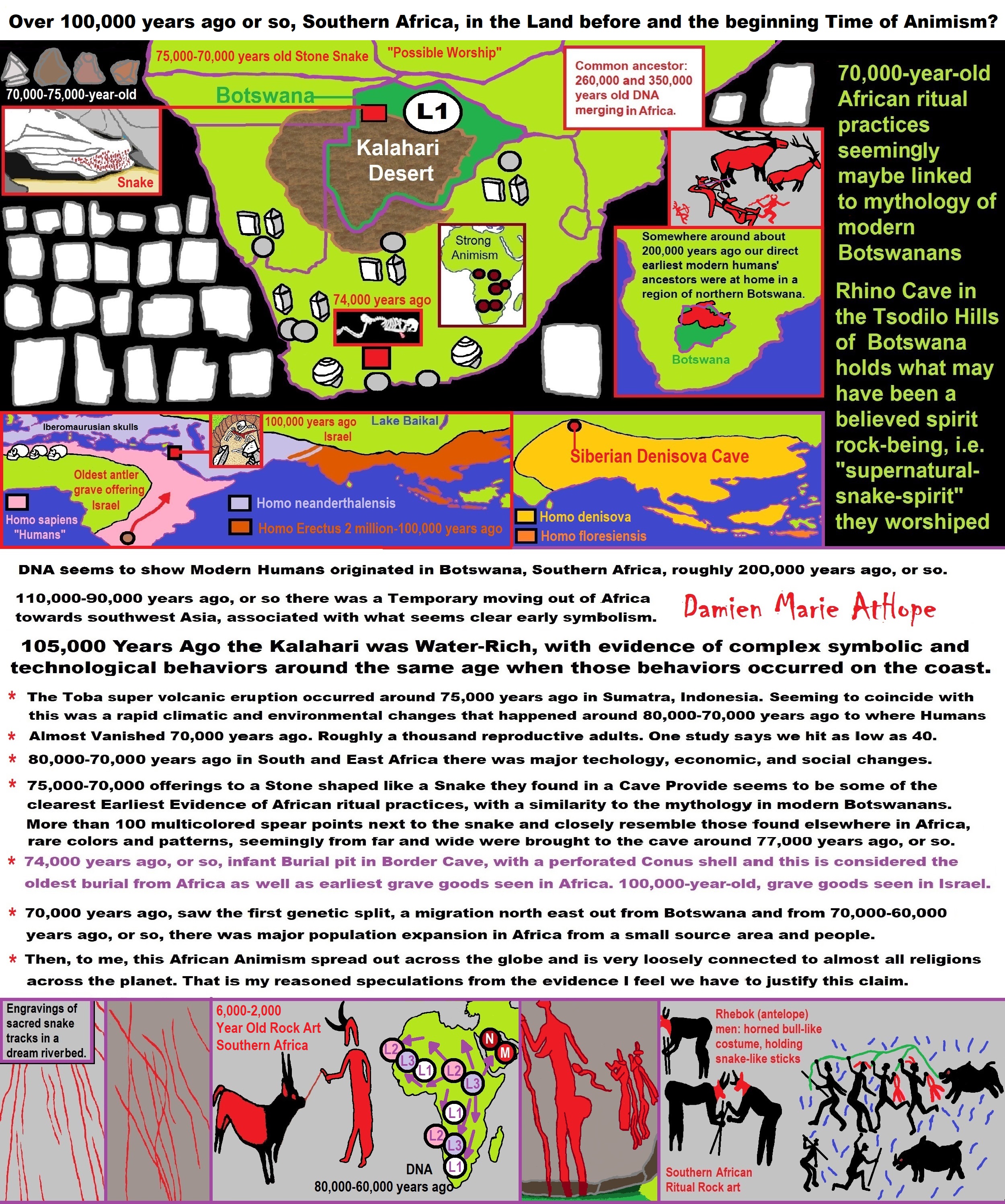
ref, ref, ref, ref, ref, ref, ref, ref, ref, ref, ref, ref, ref, ref, ref, ref, ref, ref, ref, ref, ref, ref, ref, ref, ref, ref, ref, ref, ref, ref, ref, ref, ref, ref, ref, ref, ref, ref, ref, ref, ref, ref, ref, ref, ref, ref, ref, ref, ref, ref, ref, ref
Animism: a belief among some indigenous people, young children, or all religious people!
Over 100,000 years ago or so, Southern Africa, in the Land before and the beginning Time of Animism: LINK

ref, ref, ref, ref, ref, ref, ref, ref, ref, ref, ref, ref, ref, ref, ref, ref, ref, ref, ref, ref, ref, ref, ref, ref, ref, ref, ref, ref, ref, ref, ref, ref, ref, ref, ref, ref, ref, ref, ref, ref, ref, ref, ref, ref, ref, ref, ref, ref, ref, ref, ref, ref, ref, ref, ref, ref, ref, ref, ref, ref,
Explaining the Earliest Religious Expression, that of Animism (beginning 100,000 to 70,000 years ago?) to Totemism (beginning 30,000 to 3,000 years ago?) in Southern Africa: LINK
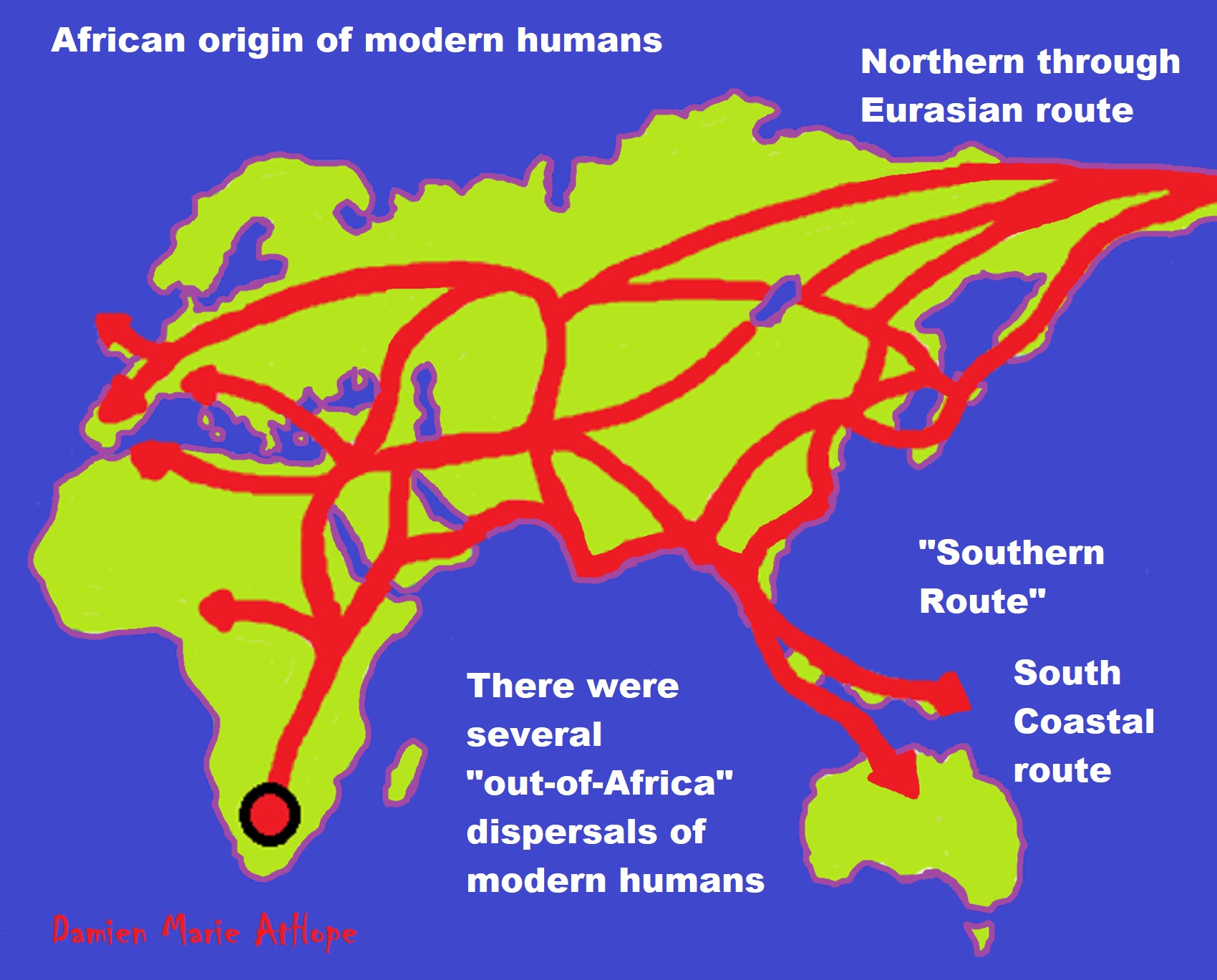
ref, ref, ref, ref, ref, ref, ref, ref
“There are two geographically plausible routes that have been proposed for humans to emerge from Africa: through the current Egypt and Sinai (Northern Route), or through Ethiopia, the Bab el Mandeb strait, and the Arabian Peninsula (Southern Route).” ref
“Although there is a general consensus on the African origin of early modern humans, there is disagreement about how and when they dispersed to Eurasia. This paper reviews genetic and Middle Stone Age/Middle Paleolithic archaeological literature from northeast Africa, Arabia, and the Levant to assess the timing and geographic backgrounds of Upper Pleistocene human colonization of Eurasia. At the center of the discussion lies the question of whether eastern Africa alone was the source of Upper Pleistocene human dispersals into Eurasia or were there other loci of human expansions outside of Africa? The reviewed literature hints at two modes of early modern human colonization of Eurasia in the Upper Pleistocene: (i) from multiple Homo sapiens source populations that had entered Arabia, South Asia, and the Levant prior to and soon after the onset of the Last Interglacial (MIS-5), (ii) from a rapid dispersal out of East Africa via the Southern Route (across the Red Sea basin), dating to ~74,000-60,000 years ago.” ref
“Within Africa, Homo sapiens dispersed around the time of its speciation, roughly 300,000 years ago. The so-called “recent dispersal” of modern humans took place about 70–50,000 years ago. It is this migration wave that led to the lasting spread of modern humans throughout the world. The coastal migration between roughly 70,000 and 50,000 years ago is associated with mitochondrial haplogroups M and N, both derivative of L3. Europe was populated by an early offshoot that settled the Near East and Europe less than 55,000 years ago. Modern humans spread across Europe about 40,000 years ago, possibly as early as 43,000 years ago, rapidly replacing the Neanderthal population.” ref, ref
Evolution of human skin color? How did I get white?
“Most of us think of Europe as the ancestral home of white people. Most people associate Africans with dark skin. Well, surprise! Ancient European had dark skin and blue eyes, DNA reveals not white at all.” ref, ref, ref
We all were once black people. We all trace our shared DNA back to 70,000 years ago in Southern Africa. It is the last place we all can call home as one human family. White people are less than 10,000 years old and didn’t even show as a population until about 8,000 years ago in North West Europe. So most of humanity’s history starting at 300,000/200,000 years ago was non-white. Black people are the original people.
Here is a blog of mine on our beginnings in Africa if anyone is interested: “Over 100,000 years ago or so, Southern Africa, in the Land before and the beginning Time of Animism?” Link
Here is a blog of mine on the greatness of our oldest African Cultures if anyone is interested: “I Support the World Following the Social Ways of the Animists in Africa as they have Beautiful Humanity.” Link
“Many different groups of people in Africa have almost every skin color on the planet, from the deepest black in the Dinka of South Sudan to beige in the San of South Africa. Now, researchers have discovered a handful of new gene variants responsible for this palette of tones. The study, published online this week in Science, traces the evolution of these genes and how they traveled around the world. While the dark skin of some Pacific Islanders can be traced to Africa, gene variants from Eurasia also seem to have made their way back to Africa. And surprisingly, some of the mutations responsible for lighter skin in Europeans turn out to have an ancient African origin.” ref
“A study shows that pale skin and other traits such as tallness and the ability to digest milk as adults arrived in most of the continent relatively recently. The work, presented here last week at the 84th annual meeting of the American Association of Physical Anthropologists, offers dramatic evidence of recent evolution in Europe and shows that most modern Europeans don’t look much like those of 8000 years ago.” ref
“The origins of Europeans have come into sharp focus in the past year as researchers have sequenced the genomes of ancient populations, rather than only a few individuals. By comparing key parts of the DNA across the genomes of 83 ancient individuals from archaeological sites throughout Europe, the international team of researchers reported earlier this year that Europeans today are a mix of the blending of at least three ancient populations of hunter-gatherers and farmers who moved into Europe in separate migrations over the past 8000 years. The study revealed that a massive migration of Yamnaya herders from the steppes north of the Black Sea may have brought Indo-European languages to Europe about 4500 years ago.” ref
“Now, a study from the same team drills down further into that remarkable data to search for genes that were under strong natural selection—including traits so favorable that they spread rapidly throughout Europe in the past 8000 years. By comparing the ancient European genomes with those of recent ones from the 1000 Genomes Project, population geneticist Iain Mathieson, a postdoc in the Harvard University lab of population geneticist David Reich, found five genes associated with changes in diet and skin pigmentation that underwent strong natural selection.” ref
Here’s How Europeans Quickly Evolved Lighter Skin
“No, Europeans did not inherit pale skins from Neanderthals!” ref
“The people who built Stonehenge 5000 years ago probably had the same pallid complexion of many modern inhabitants of the UK. Now it seems that the humans occupying Britain and mainland Europe only lost the darker skins of their African ancestors perhaps just 6000 years earlier, long after Neanderthals had died out. The finding confirms that modern Europeans didn’t gain their pale skin from Neanderthals – adding to evidence suggesting that European Homo sapiens and Neanderthals generally kept their relationships strictly platonic.” ref
“Because it must be understood that until fairly recently only Darker skinned people lived in Europe. For example, earlier this year, the genome sequencing of a hunter-gatherer who lived in what is now Spain helped build the case that Europe was home to blue-eyed but dark-skinned people. This man, however, lived just 7,000 years ago. The researchers write that their analysis suggests that light skin was not yet widespread and ubiquitous in Europe at the time. Earlier work done with the genes of the 83 people in the new study, supported by linguistic evidence, also shows that populations in Europe about 8,000 years ago would have been mixed and diverse.” ref
“The study adds to this growing pile of evidence. Gibbons reports that the researchers found that Europeans probably couldn’t have digested milk until about 4,300 years ago. And the story of skin pigmentation is complex. She writes:
[T]he new data confirm that about 8500 years ago, early hunter-gatherers in Spain, Luxembourg, and Hungary also had darker skin: They lacked versions of two genes—SLC24A5 and SLC45A2—that lead to depigmentation and, therefore, pale skin in Europeans today.But in the far north—where low light levels would favor pale skin—the team found a different picture in hunter-gatherers: Seven people from the 7700-year-old Motala archaeological site in southern Sweden had both light skin gene variants, SLC24A5 and SLC45A2. They also had a third gene, HERC2/OCA2, which causes blue eyes and may also contribute to light skin and blond hair. Thus ancient hunter-gatherers of the far north were already pale and blue-eyed, but those of central and southern Europe had darker skin.” ref
Blue-eyed people have been living in Europe for at least 7,000 years, scientists have discovered.
“A man who lived on the Iberian peninsula before Europeans became farmers probably had blue eyes but dark hair and skin, according to scientists who have sequenced his DNA. This surprising combination of eye, hair, and skin coloring may have not have been unusual during his lifetime, but it is no longer seen among modern Europeans, the team reported Sunday in the journal Nature.” ref
“The man, a Neolithic hunter-gatherer known to scientists as La Braña 1, is of great interest to scientists because he offers a snapshot of what was in Europeans’ DNA before agriculture spread through the continent. Experts have theorized that certain genetic traits spread quickly among humans after they adopted the farming lifestyle. La Braña 1 shows that at least some of their predictions were correct.” ref
“The man’s skeleton, along with that of a male companion, was discovered in 2006 in a cave in what is now northeastern Spain. The site, known as La Braña-Arintero, sits about 5,000 feet above sea level, and the cave provided a cold, refrigerator-like environment that preserved his DNA.” ref
“Researchers agree that our early australopithecine ancestors in Africa probably had light skin beneath hairy pelts. “If you shave a chimpanzee, its skin is light,” says evolutionary geneticist Sarah Tishkoff of the University of Pennsylvania, the lead author of the new study. “If you have body hair, you don’t need dark skin to protect you from ultraviolet [UV] radiation.” ref
“Until recently, researchers assumed that after human ancestors shed most body hair, sometime before 2 million years ago, they quickly evolved dark skin for protection from skin cancer and other harmful effects of UV radiation. Then, when humans migrated out of Africa and headed to the far north, they evolved lighter skin as an adaptation to limited sunlight. (Pale skin synthesizes more vitamin D when light is scarce.)” ref
“Previous research on skin-color genes fit that picture. For example, a “depigmentation gene” called SLC24A5 linked to pale skin swept through European populations in the past 6000 years. But Tishkoff ’s team found that the story of skin color evolution isn’t so black and white. Her team, including African researchers, used a light meter to measure skin reflectance in 2092 people in Ethiopia, Tanzania, and Botswana. They found the darkest skin in the Nilo-Saharan pastoralist populations of eastern Africa, such as the Mursi and Surma, and the lightest skin in the San of southern Africa, as well as many shades in between, as in the Agaw people of Ethiopia.” ref
“At the same time, they collected blood samples for genetic studies. They sequenced more than 4 million single nucleotide polymorphisms (SNPs)—places where a single letter of the genetic code varies across the genomes of 1570 of these Africans. They found four key areas of the genome where specific SNPs correlate with skin color. The first surprise was that SLC24A5, which swept Europe, is also common in East Africa—found in as many as half the members of some Ethiopian groups. This variant arose 30,000 years ago and was probably brought to eastern Africa by people migrating from the Middle East, Tishkoff says. But though many East Africans have this gene, they don’t have white skin, probably because it is just one of several genes that shape their skin color.” ref
“The team also found variants of two neighboring genes, HERC2 and OCA2, which are associated with light skin, eyes, and hair in Europeans but arose in Africa; these variants are ancient and common in the light-skinned San people. The team proposes that the variants arose in Africa as early as 1 million years ago and spread later to Europeans and Asians. “Many of the gene variants that cause light skin in Europe have origins in Africa,” Tishkoff says. The most dramatic discovery concerned a gene known as MFSD12. Two mutations that decrease the expression of this gene were found in high frequencies in people with the darkest skin. These variants arose about a half-million years ago, suggesting that human ancestors before that time may have had moderately dark skin, rather than the deep black hue created today by these mutations.” ref
“These same two variants are found in Melanesians, Australian Aborigines, and some Indians. These people may have inherited the variants from ancient migrants from Africa who followed a “southern route” out of East Africa, along the southern coast of India to Melanesia and Australia, Tishkoff says. That idea, however, counters three genetic studies that concluded last year that Australians, Melanesians, and Eurasians all descend from a single migration out of Africa. Alternatively, this great migration may have included people carrying variants for both light and dark skin, but the dark variants later were lost in Eurasians.” ref
“To understand how the MFSD12 mutations help make darker skin, the researchers reduced the expression of the gene in cultured cells, mimicking the action of the variants in dark-skinned people. The cells produced more eumelanin, the pigment responsible for black and brown skin, hair, and eyes. The mutations may also change skin color by blocking yellow pigments: When the researchers knocked out MFSD12 in zebrafish and mice, red and yellow pigments were lost, and the mice’s light brown coats turned gray. “This new mechanism for producing intensely dark pigmentation is really the big story,” says Nina Jablonski, an anthropologist at Pennsylvania State University in State College.” ref
“The study adds to established research undercutting old notions of race. You can’t use skin color to classify humans, any more than you can use other complex traits like height, Tishkoff says. “There is so much diversity in Africans that there is no such thing as an African race.” ref
“First, the scientists confirmed an earlier report that the hunter-gatherers in Europe could not digest the sugars in milk 8000 years ago, according to a poster. They also noted an interesting twist: The first farmers also couldn’t digest milk. The farmers who came from the Near East about 7800 years ago and the Yamnaya pastoralists who came from the steppes 4800 years ago lacked the version of the LCT gene that allows adults to digest sugars in milk. It wasn’t until about 4300 years ago that lactose tolerance swept through Europe.
“When it comes to skin color, the team found a patchwork of evolution in different places, and three separate genes that produce light skin, telling a complex story for how European’s skin evolved to be much lighter during the past 8000 years. The modern humans who came out of Africa to originally settle Europe about 40,000 years are presumed to have had dark skin, which is advantageous in sunny latitudes. And the new data confirm that about 8500 years ago, early hunter-gatherers in Spain, Luxembourg, and Hungary also had darker skin: They lacked versions of two genes—SLC24A5 and SLC45A2—that lead to depigmentation and, therefore, pale skin in Europeans today.” ref
“But in the far north—where low light levels would favor pale skin—the team found a different picture in hunter-gatherers: Seven people from the 7700-year-old Motala archaeological site in southern Sweden had both light skin gene variants, SLC24A5 and SLC45A2. They also had a third gene, HERC2/OCA2, which causes blue eyes and may also contribute to light skin and blond hair. Thus ancient hunter-gatherers of the far north were already pale and blue-eyed, but those of central and southern Europe had darker skin.” ref
“Then, the first farmers from the Near East arrived in Europe; they carried both genes for light skin. As they interbred with the indigenous hunter-gatherers, one of their light-skin genes swept through Europe, so that central and southern Europeans also began to have lighter skin. The other gene variant, SLC45A2, was at low levels until about 5800 years ago when it swept up to high frequency.” ref
“The team also tracked complex traits, such as height, which are the result of the interaction of many genes. They found that selection strongly favored several gene variants for tallness in northern and central Europeans, starting 8000 years ago, with a boost coming from the Yamnaya migration, starting 4800 years ago. The Yamnaya have the greatest genetic potential for being tall of any of the populations, which is consistent with measurements of their ancient skeletons. In contrast, selection favored shorter people in Italy and Spain starting 8000 years ago, according to the paper now posted on the bioRxiv preprint server. Spaniards, in particular, shrank in stature 6000 years ago, perhaps as a result of adapting to colder temperatures and a poor diet.” ref
Surprisingly, the team found no immune genes under intense selection, which is counter to hypotheses that diseases would have increased after the development of agriculture.
“The paper doesn’t specify why these genes might have been under such strong selection. But the likely explanation for the pigmentation genes is to maximize vitamin D synthesis, said paleoanthropologist Nina Jablonski of Pennsylvania State University (Penn State), University Park, as she looked at the poster’s results at the meeting. People living in northern latitudes often don’t get enough UV to synthesize vitamin D in their skin so natural selection has favored two genetic solutions to that problem—evolving pale skin that absorbs UV more efficiently or favoring lactose tolerance to be able to digest the sugars and vitamin D naturally found in milk. “What we thought was a fairly simple picture of the emergence of depigmented skin in Europe is an exciting patchwork of selection as populations disperse into northern latitudes,” Jablonski says. “This data is fun because it shows how much recent evolution has taken place.” ref
Your embracing and supporting “white privilege” makes me sick!!!
Hell YES, America is a Racist Country!!!
For the love of Hillbillies and Teachers?
Less Imperialism Worship in Prehistory/History, PLEASE
7,000 years of Class Conflict, Class War Struggle Ain’t Nothing New!
I love when people of Statism-worship persuasion, love saying, things are so bad and we need to lower the struggle,
I think what the delusion are you talking about, it has always been class war, crazy fucker, you know, for about 7,000 years ago of oppressions forced on us at the end.
Between 7,000-5,000 Years ago, rise of unequal hierarchy elite, leading to a “birth of the State” or worship of power, strong new sexism, oppression of non-elites, and the fall of Women’s equal status
Here are a few of what I see as “Animist only” Cultures:
“Aka people” Central African nomadic Mbenga pygmy people. PRONUNCIATION: AH-kah
“The Aka people are very warm and hospitable. Relationships between men and women are extremely egalitarian. Men and women contribute equally to a household’s diet, either a husband or wife can initiate divorce, and violence against women is very rare. No cases of rape have been reported. The Aka people are fiercely egalitarian and independent. No individual has the right to force or order another individual to perform an activity against his or her will. Aka people have a number of informal methods for maintaining their egalitarianism. First, they practice “prestige avoidance”; no one draws attention to his or her own abilities. Individuals play down their achievements.” ref
“Mbuti People”
“The Mbuti people are generally hunter-gatherers who commonly are in the Congo’s Ituri Forest have traditionally lived in stateless communities with gift economies and largely egalitarian gender relations. They were a people who had found in the forest something that made life more than just worth living, something that made it, with all its hardships and problems and tragedies, a wonderful thing full of joy and happiness and free of care. Pygmies, like the Inuit, minimize discrimination based upon sex and age differences. Adults of all genders make communal decisions at public assemblies. The Mbuti people do not have a state, or chiefs or councils.” ref
“Hadza people”
“The Hadza people of Tanzania in East Africa are egalitarian, meaning there are no real status differences between individuals. While the elderly receive slightly more respect, within groups of age and sex all individuals are equal, and compared to strictly stratified societies, women are considered fairly equal. This egalitarianism results in high levels of freedom and self-dependency. When conflict does arise, it may be resolved by one of the parties voluntarily moving to another camp. Ernst Fehr and Urs Fischbacher point out that the Hadza people “exhibit a considerable amount of altruistic punishment” to organize these tribes. The Hadza people live in a communal setting and engage in cooperative child-rearing, where many individuals (both related and unrelated) provide high-quality care for children. Having no tribal or governing hierarchy, the Hadza people trace descent bilaterally (through paternal and maternal lines), and almost all Hadza people can trace some kin tie to all other Hadza people.” ref
I Support the World Following the Social Ways of the Animists in Africa as they have Beautiful Humanity.
Can we do better?
Reparations for Slavery, American Terrorism?
Reparations for Jim Crow, American Terrorism?
Reparations for Red Lining, American Terrorism?
Reparations for Lynchings, American Terrorism?
Reparations for Unarmed Shootings, American Terrorism?
Yes, I believe we should!
A Study Finds 4,000 Lynchings in Jim Crow South, Will U.S. Address Legacy of Racial Terrorism?
Such vile American-Terrorism, So horrific, I totally support reparations.
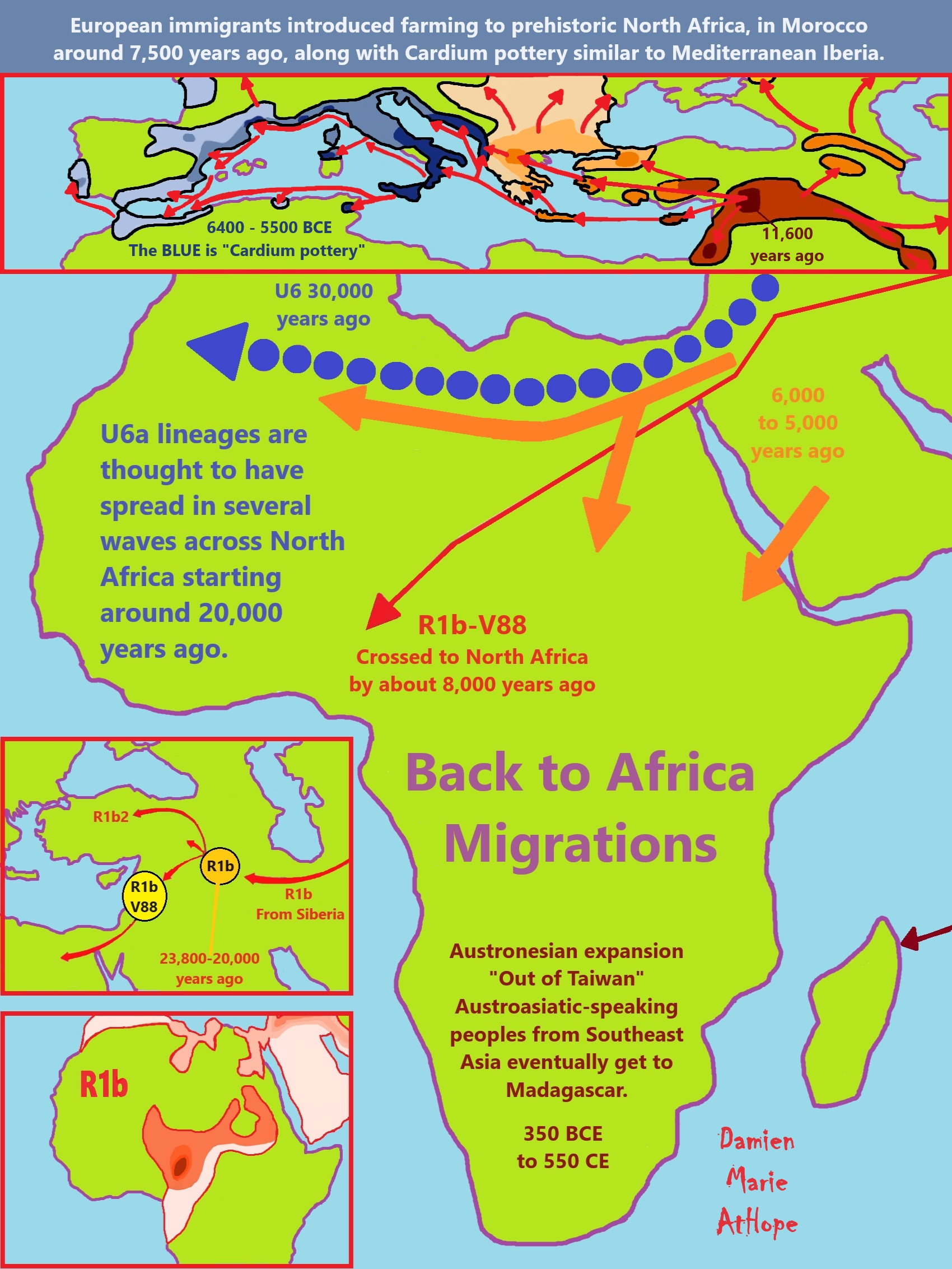
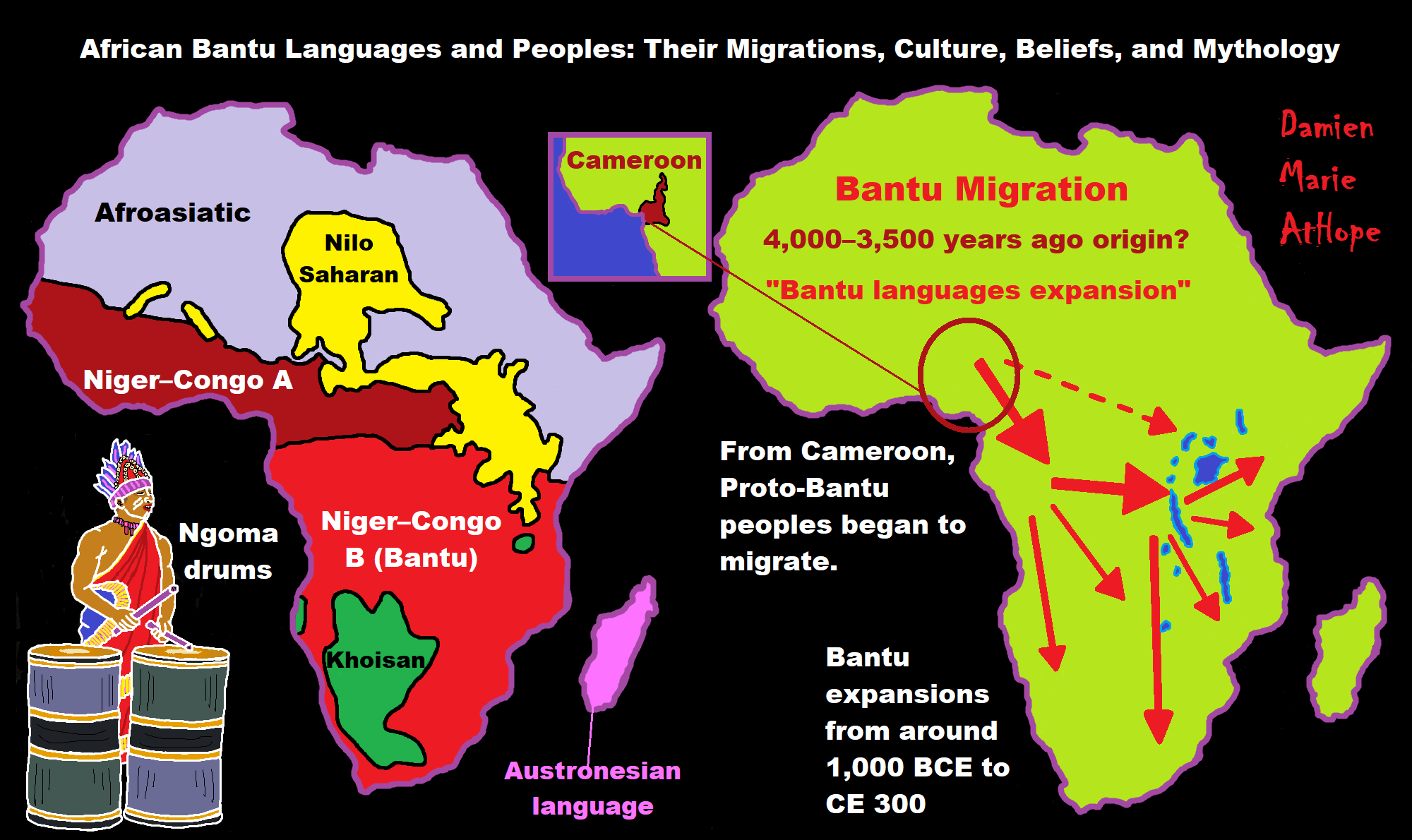
Main African Language families, shown above:
- Afroasiatic languages are spread throughout Western Asia, North Africa, the Horn of Africa, and parts of the Sahel.
- Saharan, Nilotic, and Sudanic languages (previously grouped under the hypothetical Nilo-Saharan macro-family), are present in East Africa and Sahel.
- Niger–Congo, which includes the large Atlantic-Congo and Bantu branches in West, Central, Southeast, or Southern Africa.
- The Khoisan languages are a number of African languages that have click consonants but do not belong to other African language families and are now held to comprise three distinct language families and two language isolates. ref, ref
- White (light complexion skin) Bigotry and Sexism started 7,000 years ago?
- Nordic Paganism/Shamanism, Vikings, White Supremacists Imaginary, Viking Past, Neo-paganism/Neo-Shamanism, and Far-right Religio-Nationalism Bigotry
- Anti-White racism isn’t a thing? What do you mean by that?
- Racism Hate, is Psychological/Emotional Violence?
- Taxonomy of Race? Construct or a biological reality?
- Slavery, Racism, Religion, and the Confederate Flag
- New Testament: bigotry, cruelty, sexism, slavery, racism, etc.
- Bigotry Related to and with Religious or Nonreligious Terms?
Racism
“Racism is discrimination and prejudice against people based on their race or ethnicity. Racism can be present in social actions, practices, or political systems (e.g. apartheid) that support the expression of prejudice or aversion in discriminatory practices. The ideology underlying racist practices often assumes that humans can be subdivided into distinct groups that are different in their social behavior and innate capacities and that can be ranked as inferior or superior. Racist ideology can become manifest in many aspects of social life. Associated social actions may include nativism, xenophobia, otherness, segregation, hierarchical ranking, supremacism, and related social phenomena.” ref
“While the concepts of race and ethnicity are considered to be separate in contemporary social science, the two terms have a long history of equivalence in popular usage and older social science literature. “Ethnicity” is often used in a sense close to one traditionally attributed to “race”, the division of human groups based on qualities assumed to be essential or innate to the group (e.g. shared ancestry or shared behavior). Racism and racial discrimination are often used to describe discrimination on an ethnic or cultural basis, independent of whether these differences are described as racial. According to the United Nations‘s Convention on the Elimination of All Forms of Racial Discrimination, there is no distinction between the terms “racial” and “ethnic” discrimination. It further concludes that superiority based on racial differentiation is scientifically false, morally condemnable, socially unjust, and dangerous. The convention also declared that there is no justification for racial discrimination, anywhere, in theory or in practice.” ref
“Racism is frequently described as a relatively modern concept, arising in the European age of imperialism, the subsequent growth of capitalism, and especially the Atlantic slave trade, of which it was a major driving force. It was also a major force behind racial segregation in the United States in the 19th and early 20th centuries, and of apartheid in South Africa; 19th and 20th-century racism in Western culture is particularly well documented and constitutes a reference point in studies and discourses about racism. Racism has played a role in genocides such as the Holocaust, the Armenian genocide, the Rwandan genocide, and the Genocide of Serbs in the Independent State of Croatia, as well as colonial projects including the European colonization of the Americas, Africa, Asia, and the population transfer in the Soviet Union including deportations of indigenous minorities. Indigenous peoples have been—and are—often subject to racist attitudes.” ref
“In the 19th century, many scientists subscribed to the belief that the human population can be divided into races. The term racism is a noun describing the state of being racist, i.e., subscribing to the belief that the human population can or should be classified into races with differential abilities and dispositions, which in turn may motivate a political ideology in which rights and privileges are differentially distributed based on racial categories. The term “racist” may be an adjective or a noun, the latter describing a person who holds those beliefs. The origin of the root word “race” is not clear. Linguists generally agree that it came to the English language from Middle French, but there is no such agreement on how it generally came into Latin-based languages. A recent proposal is that it derives from the Arabic ra’s, which means “head, beginning, origin” or the Hebrew rosh, which has a similar meaning. Early race theorists generally held the view that some races were inferior to others and they consequently believed that the differential treatment of races was fully justified. These early theories guided pseudo-scientific research assumptions; the collective endeavors to adequately define and form hypotheses about racial differences are generally termed scientific racism, though this term is a misnomer, due to the lack of any actual science backing the claims.” ref
“Most biologists, anthropologists, and sociologists reject a taxonomy of races in favor of more specific and/or empirically verifiable criteria, such as geography, ethnicity, or a history of endogamy. Human genome research indicates that race is not a meaningful genetic classification of humans.” ref
“An entry in the Oxford English Dictionary (2008) defines racialism as “[a]n earlier term than racism, but now largely superseded by it”, and cites the term “racialism” in a 1902 quote. The revised Oxford English Dictionary cites the shorter term “racism” in a quote from the year 1903. It was defined by the Oxford English Dictionary (2nd edition 1989) as “[t]he theory that distinctive human characteristics and abilities are determined by race”; the same dictionary termed racism a synonym of racialism: “belief in the superiority of a particular race”. By the end of World War II, racism had acquired the same supremacist connotations formerly associated with racialism: racism by then implied racial discrimination, racial supremacism, and a harmful intent. The term “race hatred” had also been used by sociologist Frederick Hertz in the late 1920s.” ref
“As its history indicates, the popular use of the word racism is relatively recent. The word came into widespread usage in the Western world in the 1930s, when it was used to describe the social and political ideology of Nazism, which treated “race” as a naturally given political unit. It is commonly agreed that racism existed before the coinage of the word, but there is not a wide agreement on a single definition of what racism is and what it is not. Today, some scholars of racism prefer to use the concept in the plural racisms, in order to emphasize its many different forms that do not easily fall under a single definition. They also argue that different forms of racism have characterized different historical periods and geographical areas. Garner (2009: p. 11) summarizes different existing definitions of racism and identifies three common elements contained in those definitions of racism. First, a historical, hierarchical power relationship between groups; second, a set of ideas (an ideology) about racial differences; and, third, discriminatory actions (practices).” ref
“Though many countries around the globe have passed laws related to race and discrimination, the first significant international human rights instrument developed by the United Nations (UN) was the Universal Declaration of Human Rights (UDHR), which was adopted by the United Nations General Assembly in 1948. The UDHR recognizes that if people are to be treated with dignity, they require economic rights, social rights including education, and the rights to cultural and political participation and civil liberty. It further states that everyone is entitled to these rights “without distinction of any kind, such as race, colour, sex, language, religion, political or other opinion, national or social origin, property, birth or other status.” ref
“The UN does not define “racism”; however, it does define “racial discrimination”. According to the 1965 UN International Convention on the Elimination of All Forms of Racial Discrimination,
The term “racial discrimination” shall mean any distinction, exclusion, restriction, or preference based on race, colour, descent, or national or ethnic origin that has the purpose or effect of nullifying or impairing the recognition, enjoyment or exercise, on an equal footing, of human rights and fundamental freedoms in the political, economic, social, cultural or any other field of public life.” ref
“In their 1978 United Nations Educational, Scientific, and Cultural Organization (UNESCO) Declaration on Race and Racial Prejudice (Article 1), the UN states, “All human beings belong to a single species and are descended from a common stock. They are born equal in dignity and rights and all form an integral part of humanity.” The UN definition of racial discrimination does not make any distinction between discrimination based on ethnicity and race, in part because the distinction between the two has been a matter of debate among academics, including anthropologists. Similarly, in British law, the phrase racial group means “any group of people who are defined by reference to their race, color, nationality (including citizenship) or ethnic or national origin.” ref
“In Norway, the word “race” has been removed from national laws concerning discrimination because the use of the phrase is considered problematic and unethical. The Norwegian Anti-Discrimination Act bans discrimination based on ethnicity, national origin, descent, and skin color. Sociologists, in general, recognize “race” as a social construct. This means that, although the concepts of race and racism are based on observable biological characteristics, any conclusions drawn about race on the basis of those observations are heavily influenced by cultural ideologies. Racism, as an ideology, exists in a society at both the individual and institutional level.” ref
“While much of the research and work on racism during the last half-century or so has concentrated on “white racism” in the Western world, historical accounts of race-based social practices can be found across the globe. Thus, racism can be broadly defined to encompass individual and group prejudices and acts of discrimination that result in material and cultural advantages conferred on a majority or a dominant social group. So-called “white racism” focuses on societies in which white populations are the majority or the dominant social group. In studies of these majority white societies, the aggregate of material and cultural advantages is usually termed “white privilege.” ref
“Race and race relations are prominent areas of study in sociology and economics. Much of the sociological literature focuses on white racism. Some of the earliest sociological works on racism were written by sociologist W. E. B. Du Bois, the first African American to earn a doctoral degree from Harvard University. Du Bois wrote, “[t]he problem of the twentieth century is the problem of the color line.” Wellman (1993) defines racism as “culturally sanctioned beliefs, which, regardless of intentions involved, defend the advantages whites have because of the subordinated position of racial minorities”. In both sociology and economics, the outcomes of racist actions are often measured by the inequality in income, wealth, net worth, and access to other cultural resources (such as education), between racial groups.” ref
“In sociology and social psychology, racial identity and the acquisition of that identity, is often used as a variable in racism studies. Racial ideologies and racial identity affect individuals’ perception of race and discrimination. Cazenave and Maddern (1999) define racism as “a highly organized system of ‘race’-based group privilege that operates at every level of society and is held together by a sophisticated ideology of color/’race’ supremacy. Racial centrality (the extent to which a culture recognizes individuals’ racial identity) appears to affect the degree of discrimination African-American young adults perceive whereas racial ideology may buffer the detrimental emotional effects of that discrimination.” Sellers and Shelton (2003) found that a relationship between racial discrimination and emotional distress was moderated by racial ideology and social beliefs.” ref
“Some sociologists also argue that, particularly in the West, where racism is often negatively sanctioned in society, racism has changed from being a blatant to a more covert expression of racial prejudice. The “newer” (more hidden and less easily detectable) forms of racism—which can be considered embedded in social processes and structures—are more difficult to explore and challenge. It has been suggested that, while in many countries overt or explicit racism has become increasingly taboo, even among those who display egalitarian explicit attitudes, an implicit or aversive racism is still maintained subconsciously.” ref
“This process has been studied extensively in social psychology as implicit associations and implicit attitudes, a component of implicit cognition. Implicit attitudes are evaluations that occur without conscious awareness towards an attitude object or the self. These evaluations are generally either favorable or unfavorable. They come about from various influences in the individual experience. Implicit attitudes are not consciously identified (or they are inaccurately identified) traces of past experience that mediate favorable or unfavorable feelings, thoughts, or actions towards social objects. These feelings, thoughts, or actions have an influence on behavior of which the individual may not be aware.” ref
“Therefore, subconscious racism can influence our visual processing and how our minds work when we are subliminally exposed to faces of different colors. In thinking about crime, for example, social psychologist Jennifer L. Eberhardt (2004) of Stanford University holds that, “blackness is so associated with crime you’re ready to pick out these crime objects.” Such exposures influence our minds and they can cause subconscious racism in our behavior towards other people or even towards objects. Thus, racist thoughts and actions can arise from stereotypes and fears of which we are not aware. For example, scientists and activists have warned that the use of the stereotype “Nigerian Prince” for referring to advance-fee scammers is racist, i.e. “reducing Nigeria to a nation of scammers and fraudulent princes, as some people still do online, is a stereotype that needs to be called out.” ref
“Language, linguistics, and discourse are active areas of study in the humanities, along with literature and the arts. Discourse analysis seeks to reveal the meaning of race and the actions of racists through careful study of the ways in which these factors of human society are described and discussed in various written and oral works. For example, Van Dijk (1992) examines the different ways in which descriptions of racism and racist actions are depicted by the perpetrators of such actions as well as by their victims. He notes that when descriptions of actions have negative implications for the majority, and especially for white elites, they are often seen as controversial, and such controversial interpretations are typically marked with quotation marks or they are greeted with expressions of distance or doubt. The previously cited book, The Souls of Black Folk by W.E.B. Du Bois, represents early African-American literature that describes the author’s experiences with racism when he was traveling in the South as an African American.” ref
“Much American fictional literature has focused on issues of racism and the black “racial experience” in the US, including works written by whites, such as Uncle Tom’s Cabin, To Kill a Mockingbird, and Imitation of Life, or even the non-fiction work Black Like Me. These books, and others like them, feed into what has been called the “white savior narrative in film“, in which the heroes and heroines are white even though the story is about things that happen to black characters. Textual analysis of such writings can contrast sharply with black authors’ descriptions of African Americans and their experiences in US society. African-American writers have sometimes been portrayed in African-American studies as retreating from racial issues when they write about “whiteness“, while others identify this as an African-American literary tradition called “the literature of white estrangement”, part of a multi-pronged effort to challenge and dismantle white supremacy in the US.” ref
“According to dictionary definitions, racism is prejudice and discrimination based on race. Racism can also be said to describe a condition in society in which a dominant racial group benefits from the oppression of others, whether that group wants such benefits or not. Foucauldian scholar Ladelle McWhorter, in her 2009 book, Racism and Sexual Oppression in Anglo-America: A Genealogy, posits modern racism similarly, focusing on the notion of a dominant group, usually whites, vying for racial purity and progress, rather than an overt or obvious ideology focused on the oppression of nonwhites.” ref
“In popular usage, as in some academic usage, little distinction is made between “racism” and “ethnocentrism“. Often, the two are listed together as “racial and ethnic” in describing some action or outcome that is associated with prejudice within a majority or dominant group in society. Furthermore, the meaning of the term racism is often conflated with the terms prejudice, bigotry, and discrimination. Racism is a complex concept that can involve each of those; but it cannot be equated with, nor is it synonymous, with these other terms.” ref
“The term is often used in relation to what is seen as prejudice within a minority or subjugated group, as in the concept of reverse racism. “Reverse racism” is a concept often used to describe acts of discrimination or hostility against members of a dominant racial or ethnic group while favoring members of minority groups. This concept has been used especially in the United States in debates over color-conscious policies (such as affirmative action) intended to remedy racial inequalities. However, many experts and other commenters view reverse racism as a myth rather than a reality. Academics commonly define racism not only in terms of individual prejudice, but also in terms of a power structure that protects the interests of the dominant culture and actively discriminates against ethnic minorities. From this perspective, while members of ethnic minorities may be prejudiced against members of the dominant culture, they lack the political and economic power to actively oppress them, and they are therefore not practicing “racism.” ref
“Aversive racism is a form of implicit racism, in which a person’s unconscious negative evaluations of racial or ethnic minorities are realized by a persistent avoidance of interaction with other racial and ethnic groups. As opposed to traditional, overt racism, which is characterized by overt hatred for and explicit discrimination against racial/ethnic minorities, aversive racism is characterized by more complex, ambivalent expressions and attitudes. Aversive racism is similar in implications to the concept of symbolic or modern racism (described below), which is also a form of implicit, unconscious, or covert attitude which results in unconscious forms of discrimination.” ref
“The term was coined by Joel Kovel to describe the subtle racial behaviors of any ethnic or racial group who rationalize their aversion to a particular group by appeal to rules or stereotypes. People who behave in an aversively racial way may profess egalitarian beliefs, and will often deny their racially motivated behavior; nevertheless they change their behavior when dealing with a member of another race or ethnic group than the one they belong to. The motivation for the change is thought to be implicit or subconscious. Experiments have provided empirical support for the existence of aversive racism. Aversive racism has been shown to have potentially serious implications for decision making in employment, in legal decisions, and in helping behavior.” ref
“In relation to racism, color blindness is the disregard of racial characteristics in social interaction, for example in the rejection of affirmative action, as a way to address the results of past patterns of discrimination. Critics of this attitude argue that by refusing to attend to racial disparities, racial color blindness in fact unconsciously perpetuates the patterns that produce racial inequality.” ref
“Eduardo Bonilla-Silva argues that color-blind racism arises from an “abstract liberalism, biologization of culture, naturalization of racial matters, and minimization of racism”. Color-blind practices are “subtle, institutional, and apparently nonracial” because race is explicitly ignored in decision-making. If race is disregarded in predominantly white populations, for example, whiteness becomes the normative standard, whereas people of color are othered, and the racism these individuals experience may be minimized or erased. At an individual level, people with “color-blind prejudice” reject racist ideology, but also reject systemic policies intended to fix institutional racism.” ref
“Cultural racism manifests as societal beliefs and customs that promote the assumption that the products of a given culture, including the language and traditions of that culture, are superior to those of other cultures. It shares a great deal with xenophobia, which is often characterized by fear of, or aggression toward, members of an outgroup by members of an ingroup. In that sense, it is also similar to communalism as used in South Asia. Cultural racism exists when there is a widespread acceptance of stereotypes concerning diverse ethnic or population groups. Whereas racism can be characterized by the belief that one race is inherently superior to another, cultural racism can be characterized by the belief that one culture is inherently superior to another.” ref
“Historical economic or social disparity is alleged to be a form of discrimination caused by past racism and historical reasons, affecting the present generation through deficits in the formal education and kinds of preparation in previous generations, and through primarily unconscious racist attitudes and actions on members of the general population. Economic discrimination may lead to choices that perpetuate racism. For example, color photographic film was tuned for white skin as are automatic soap dispensers and facial recognition systems. In 2011, Bank of America agreed to pay $335 million to settle a federal government claim that its mortgage division, Countrywide Financial, discriminated against black and Hispanic homebuyers.” ref
“Institutional racism (also known as structural racism, state racism or systemic racism) is racial discrimination by governments, corporations, religions, or educational institutions or other large organizations with the power to influence the lives of many individuals. Stokely Carmichael is credited for coining the phrase institutional racism in the late 1960s. He defined the term as “the collective failure of an organization to provide an appropriate and professional service to people because of their color, culture or ethnic origin”. Maulana Karenga argued that racism constituted the destruction of culture, language, religion, and human possibility and that the effects of racism were “the morally monstrous destruction of human possibility involved redefining African humanity to the world, poisoning past, present and future relations with others who only know us through this stereotyping and thus damaging the truly human relations among peoples.” ref
“Othering is the term used by some to describe a system of discrimination whereby the characteristics of a group are used to distinguish them as separate from the norm. Othering plays a fundamental role in the history and continuation of racism. To objectify a culture as something different, exotic, or underdeveloped is to generalize that it is not like ‘normal’ society. Europe’s colonial attitude towards the Orientals exemplifies this as it was thought that the East was the opposite of the West; feminine where the West was masculine, weak where the West was strong, and traditional where the West was progressive. By making these generalizations and othering the East, Europe was simultaneously defining herself as the norm, further entrenching the gap. Much of the process of othering relies on imagined difference, or the expectation of difference. Spatial difference can be enough to conclude that “we” are “here” and the “others” are over “there”. Imagined differences serve to categorize people into groups and assign them characteristics that suit the imaginer’s expectations.” ref
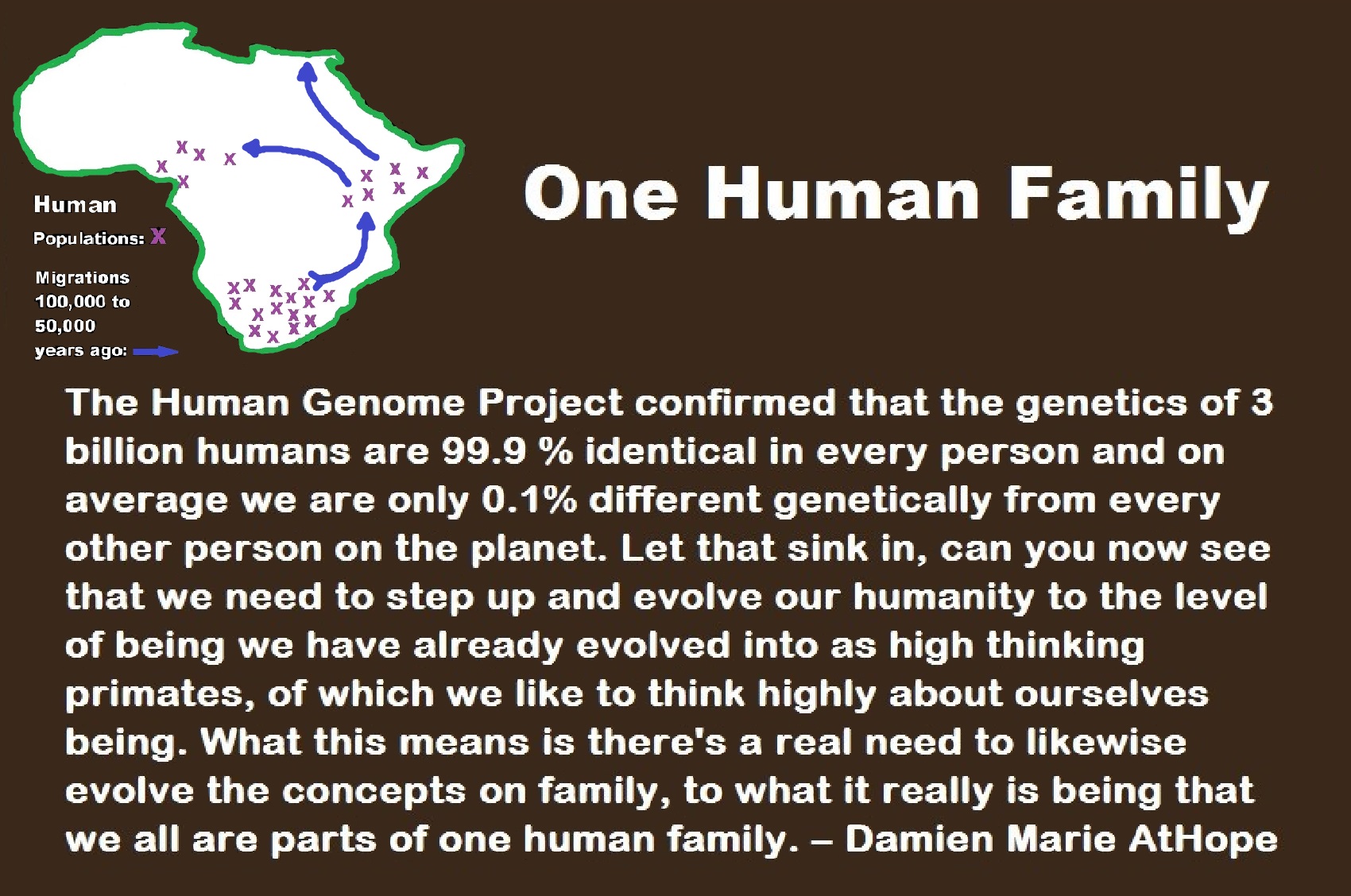
“When researchers completed the final analysis of the Human Genome Project in April 2003, they confirmed that the 3 billion base pairs of genetic letters in humans were 99.9 percent identical in every person. It also meant that individuals are, on average, 0.1 percent different genetically from every other person on the planet. And in that 0.1 percent lies the mystery of why some people are more susceptible to a particular illness or more likely to be healthy than their neighbor – or even another family member.” ref
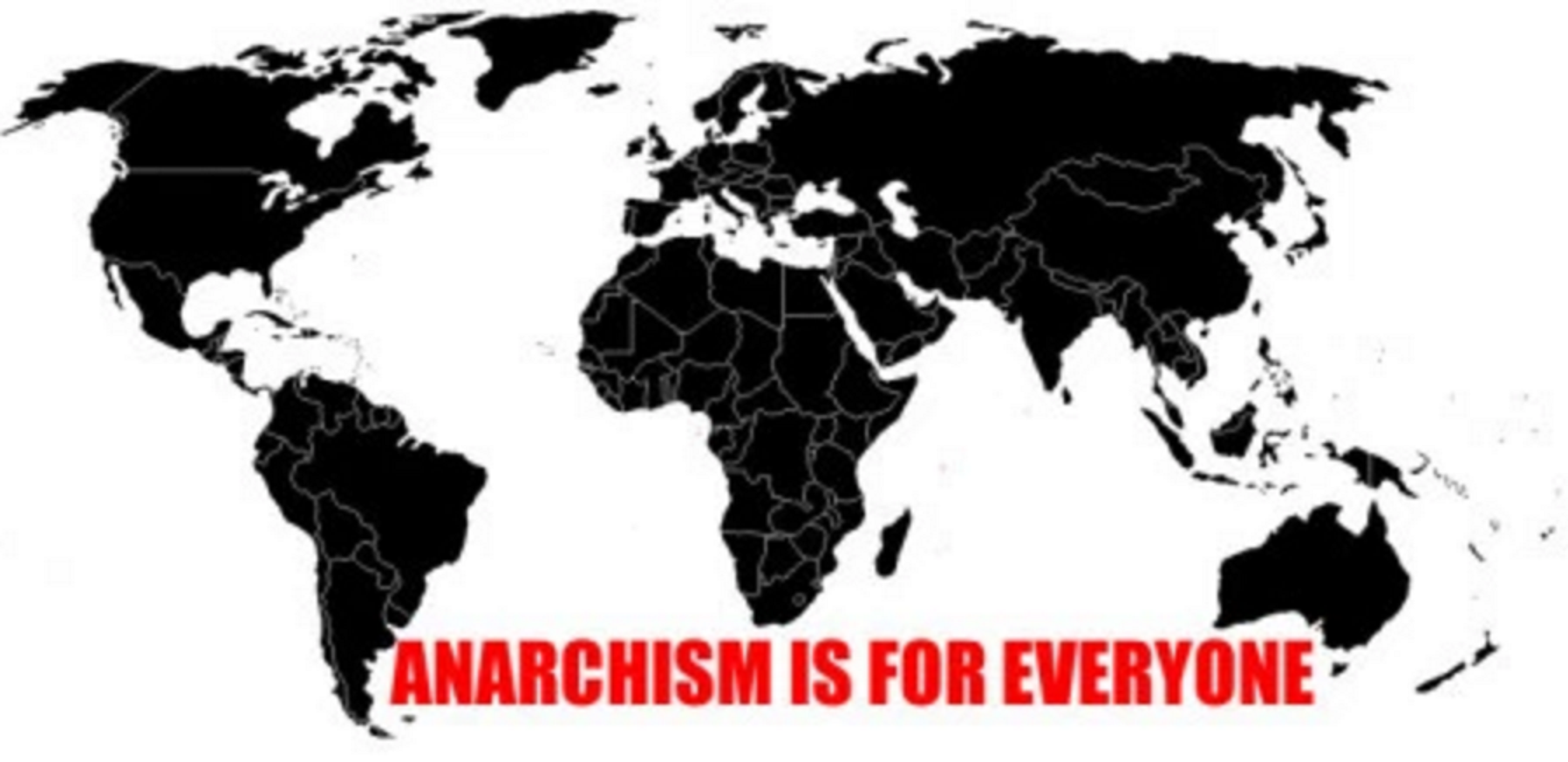


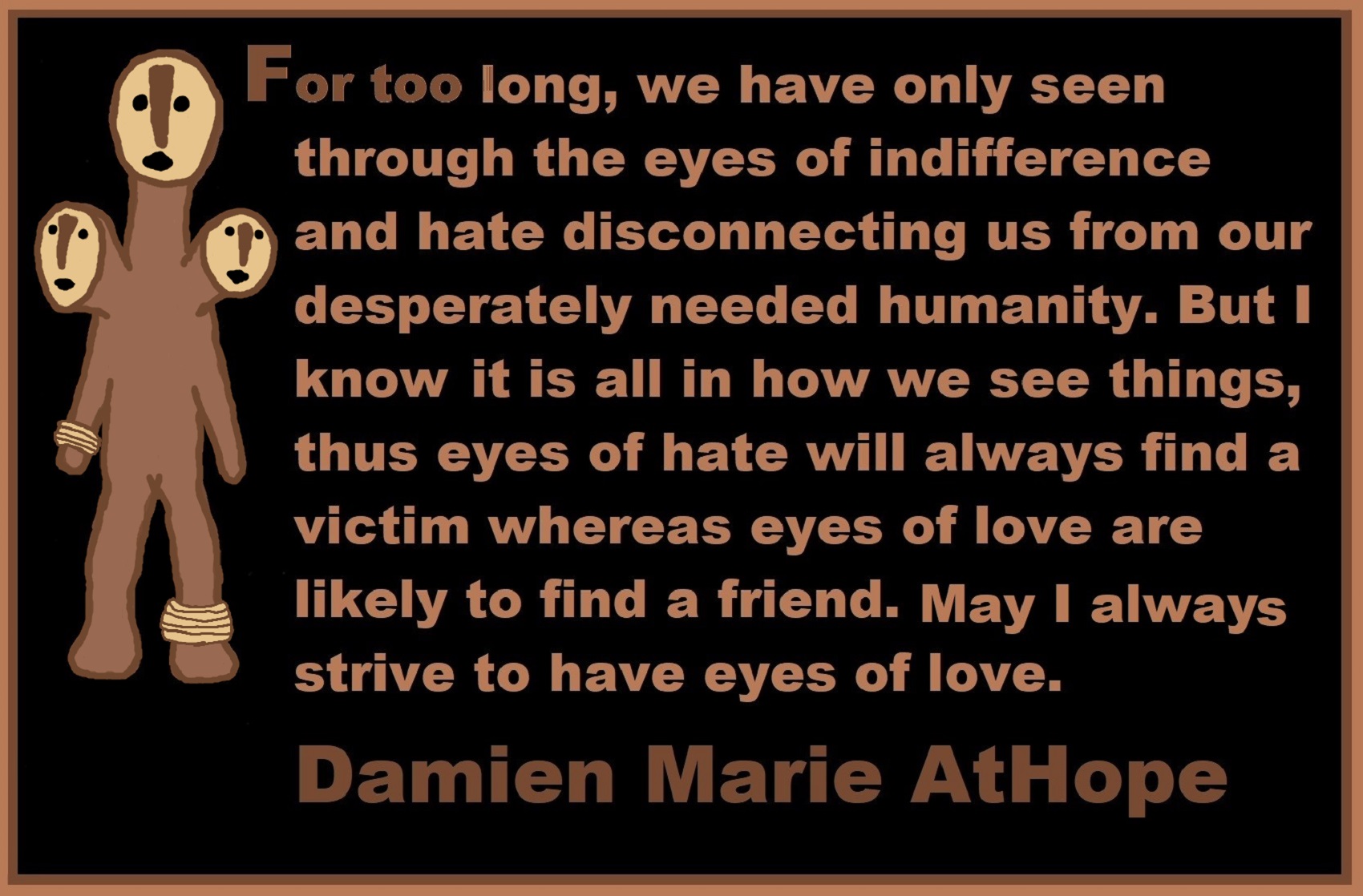
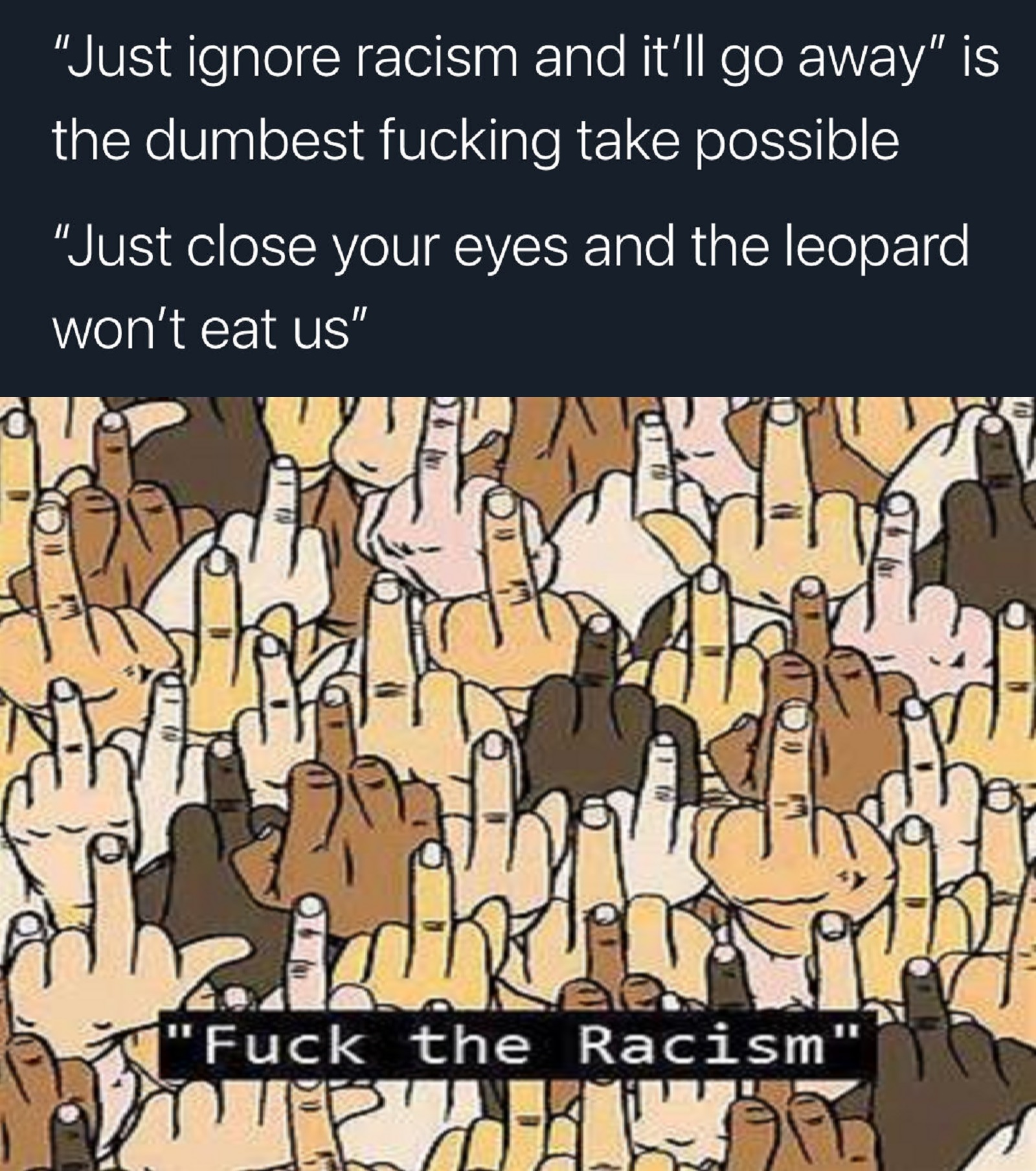
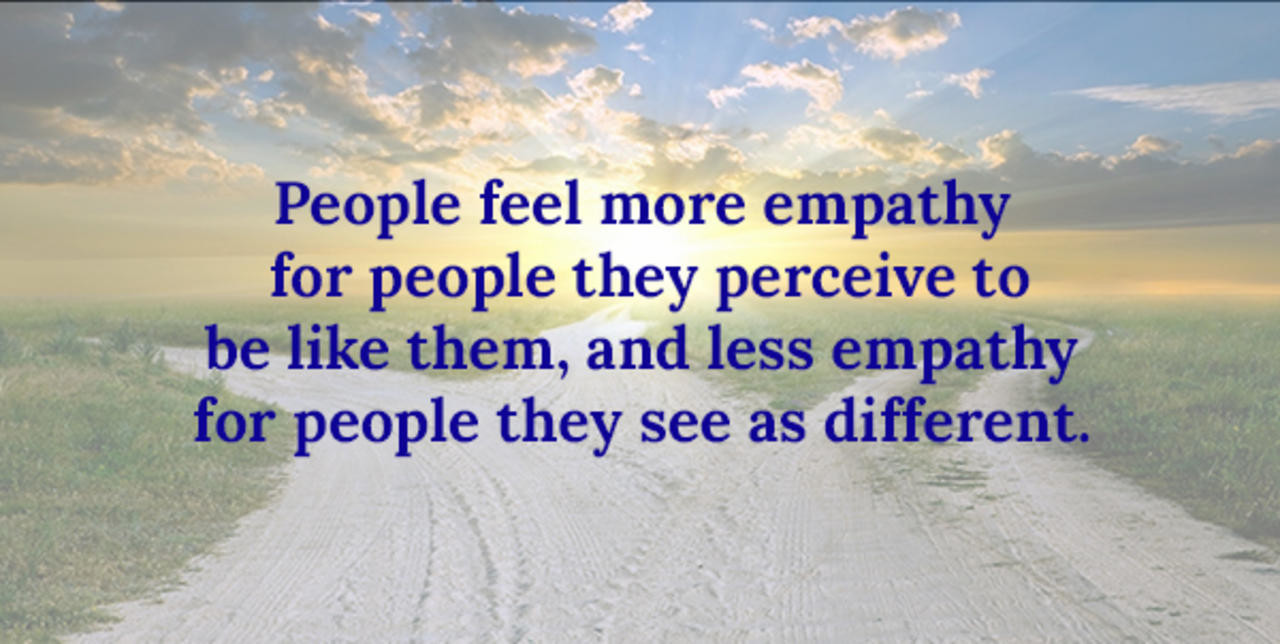

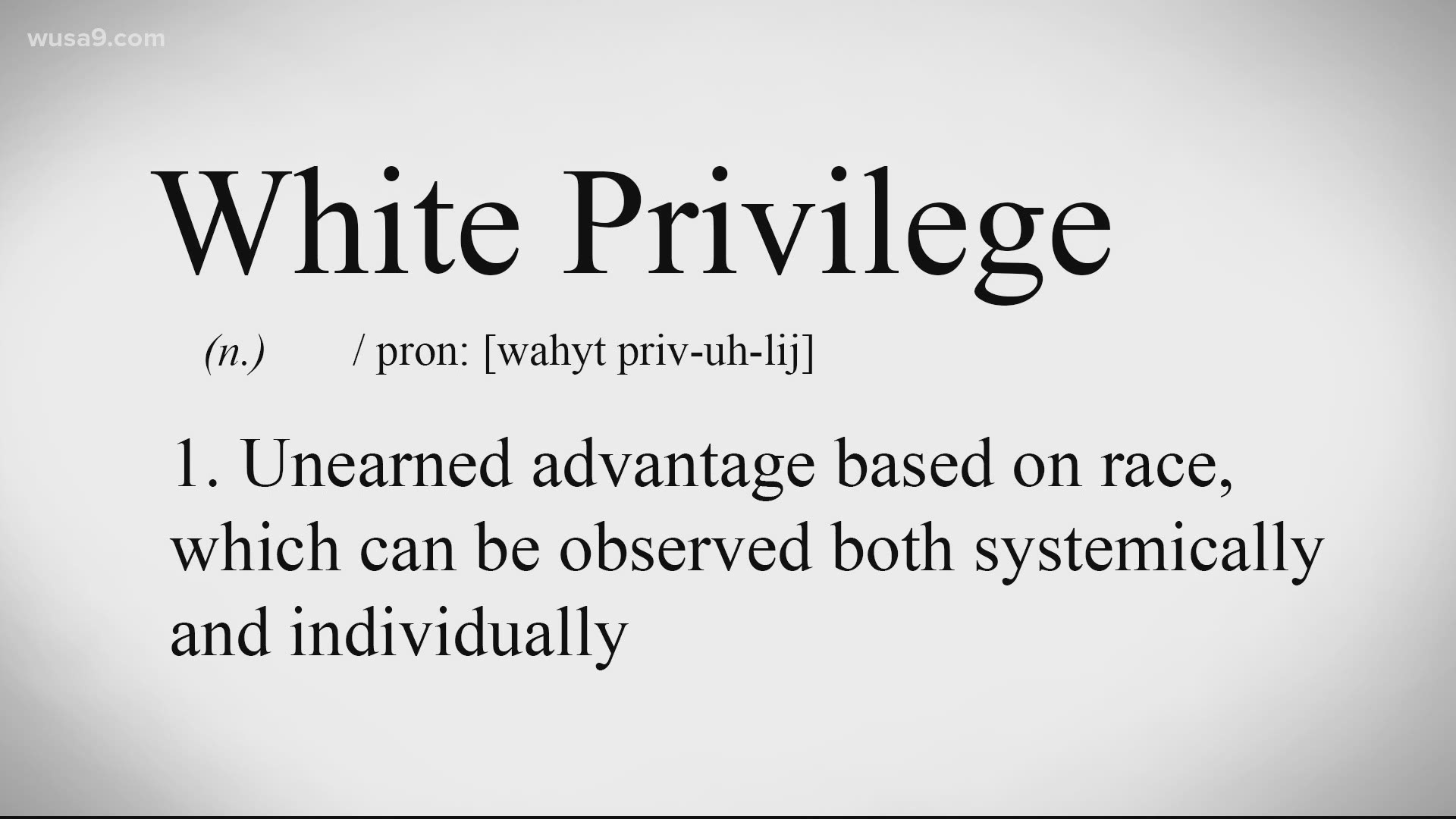
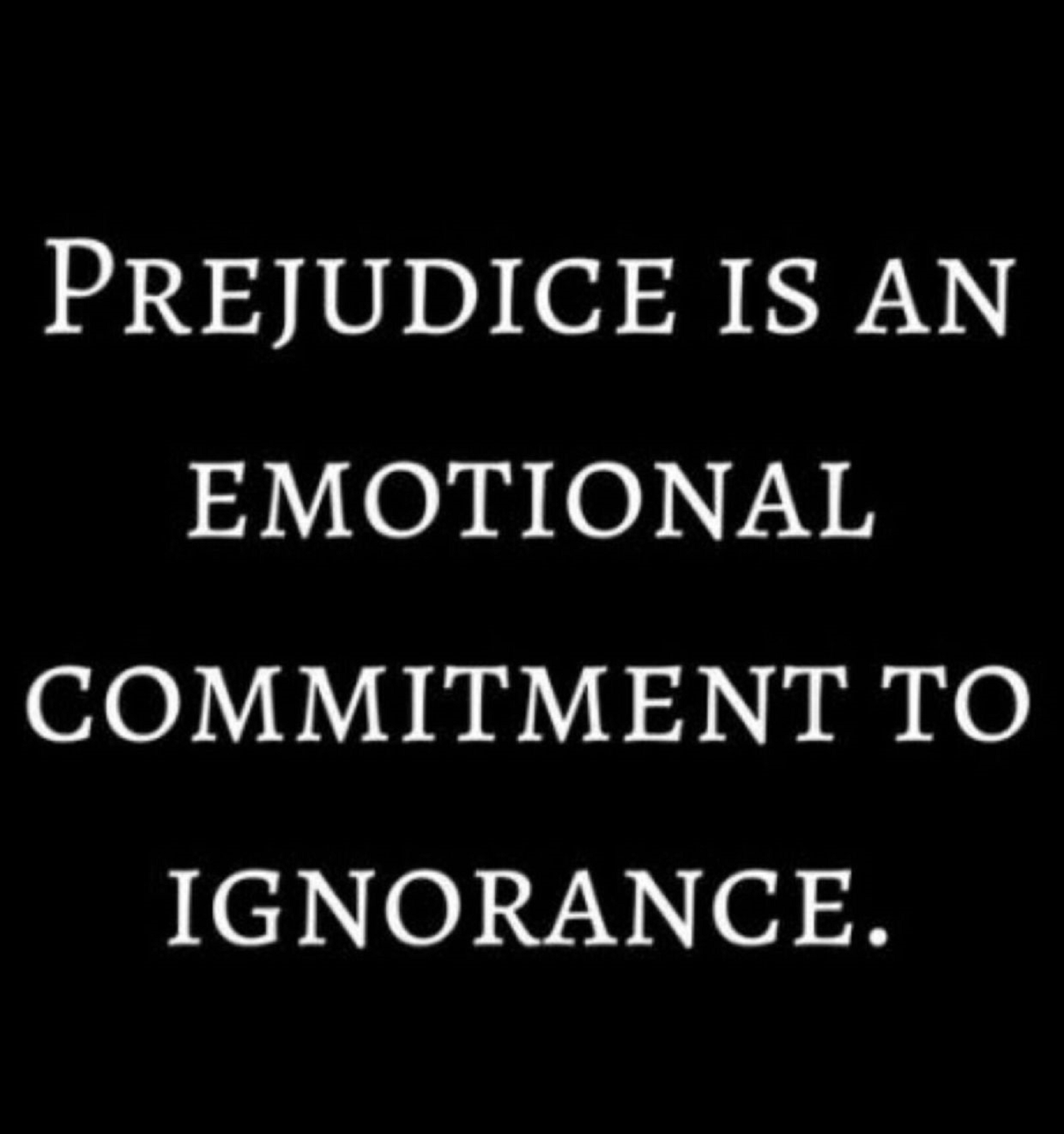
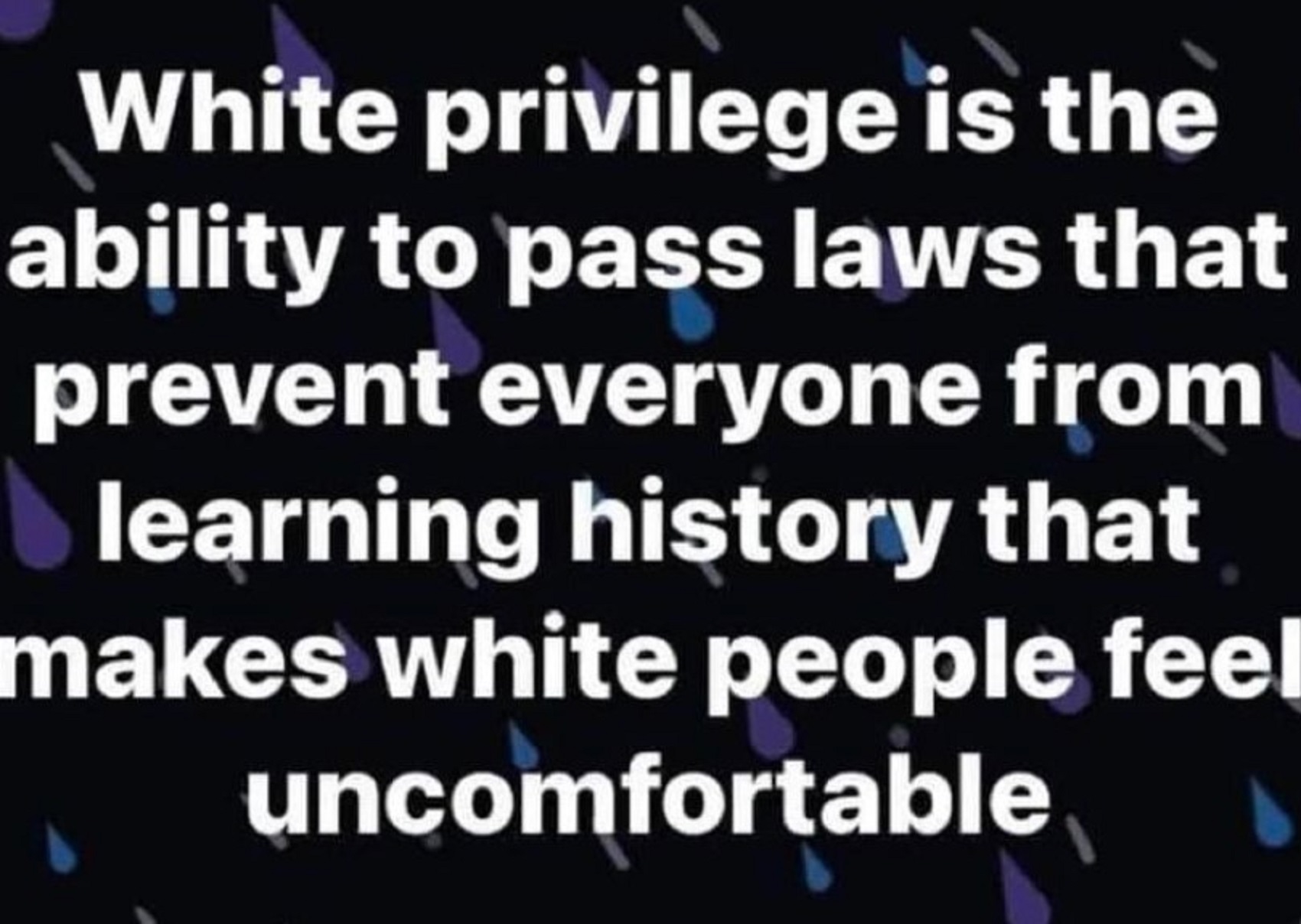
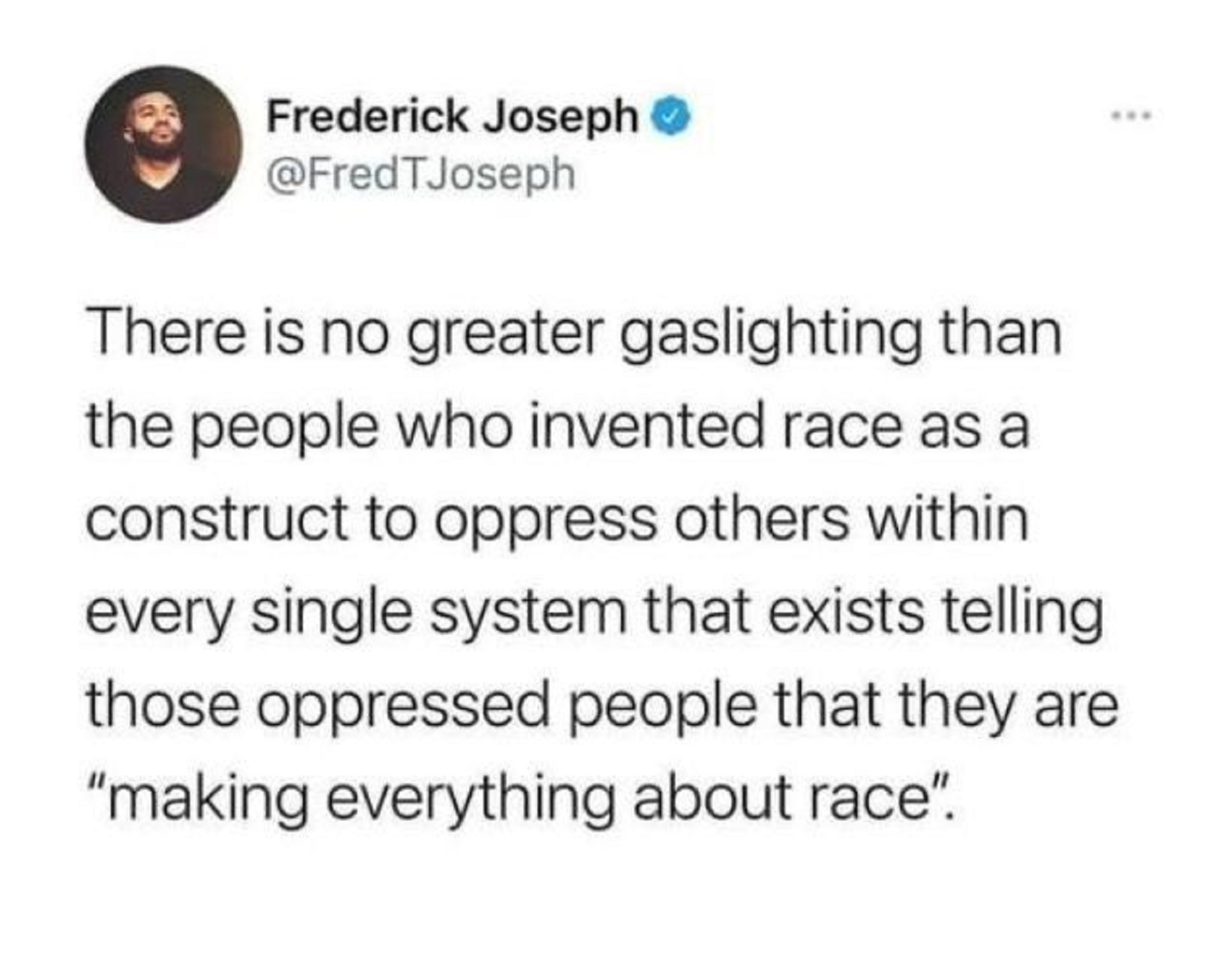
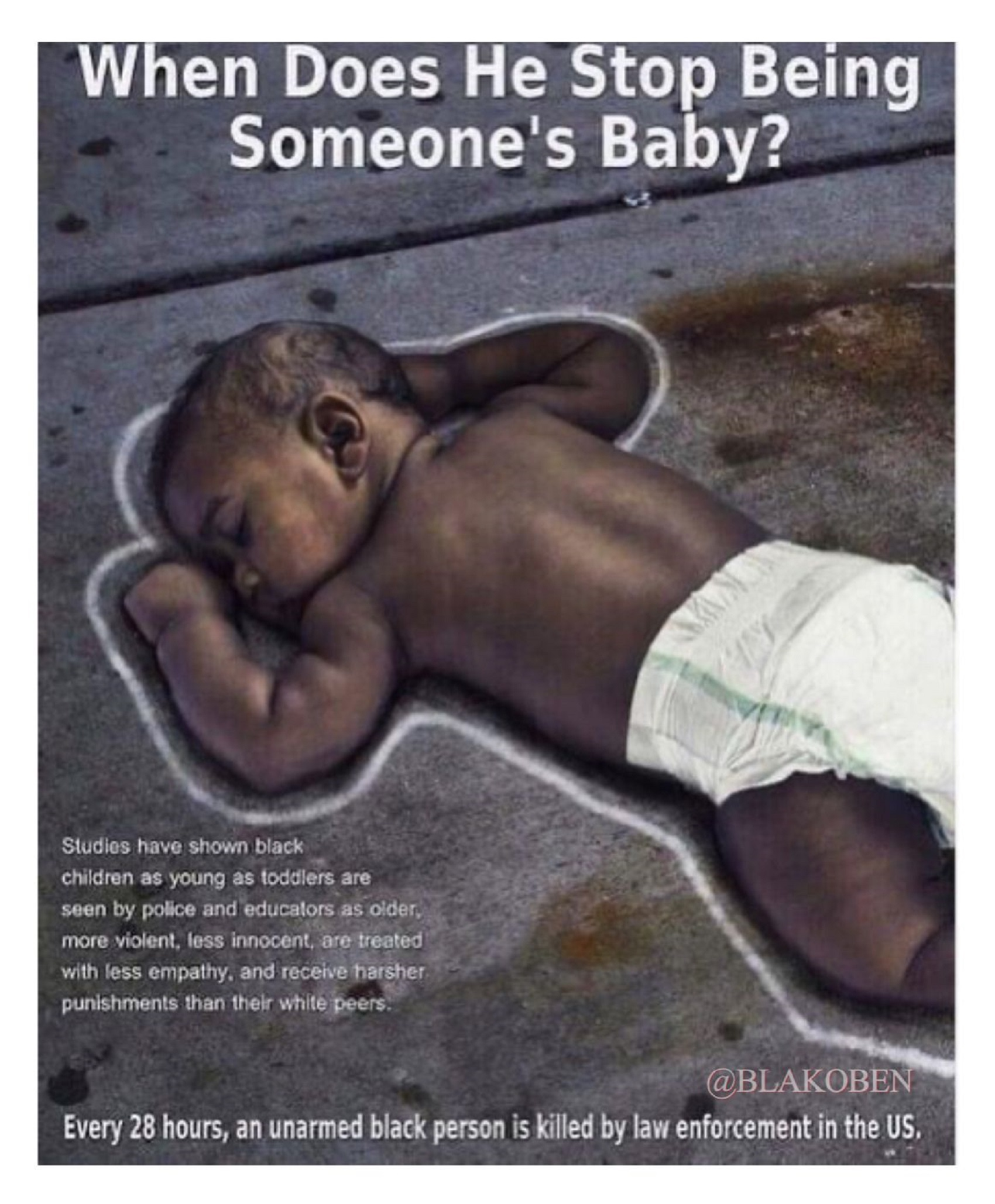
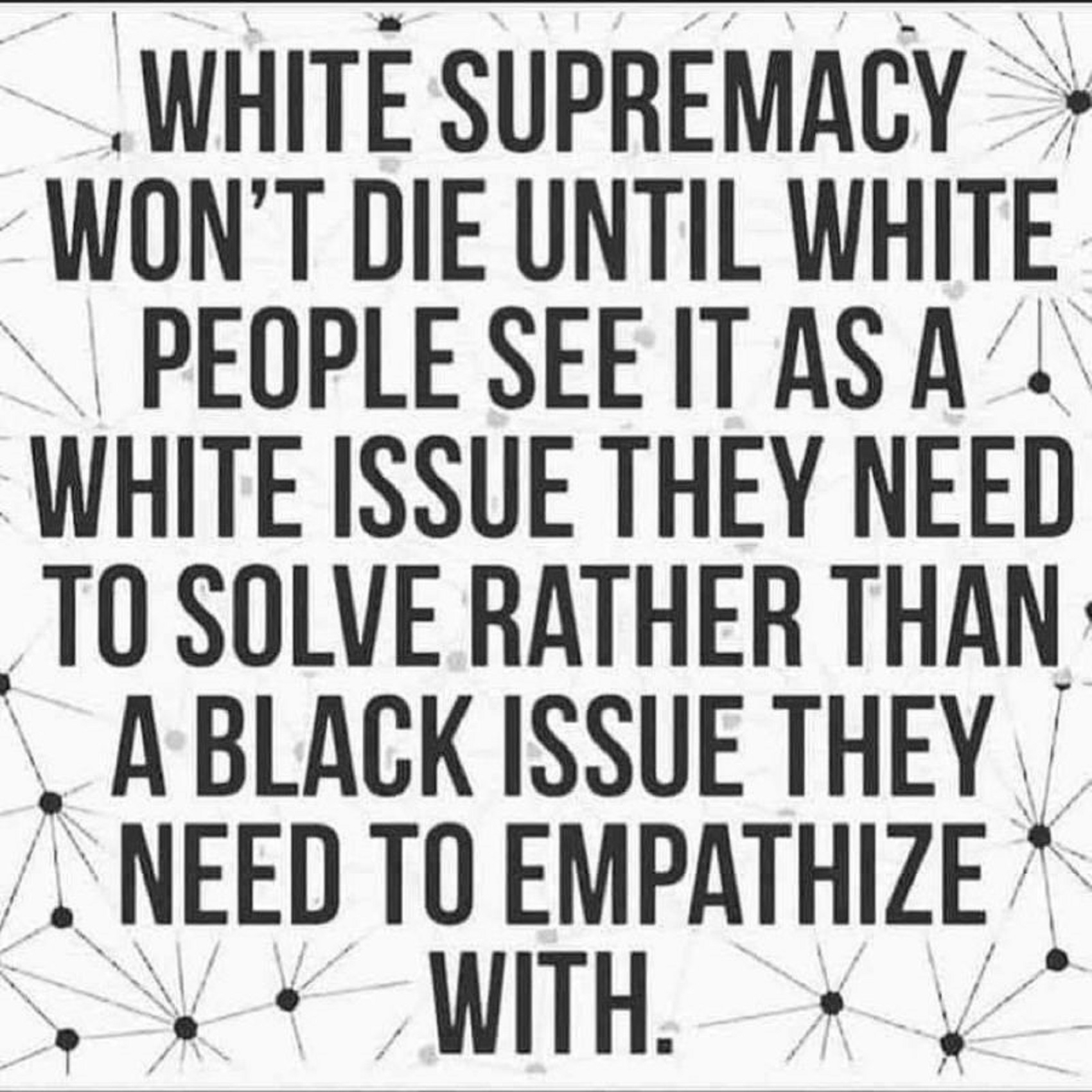

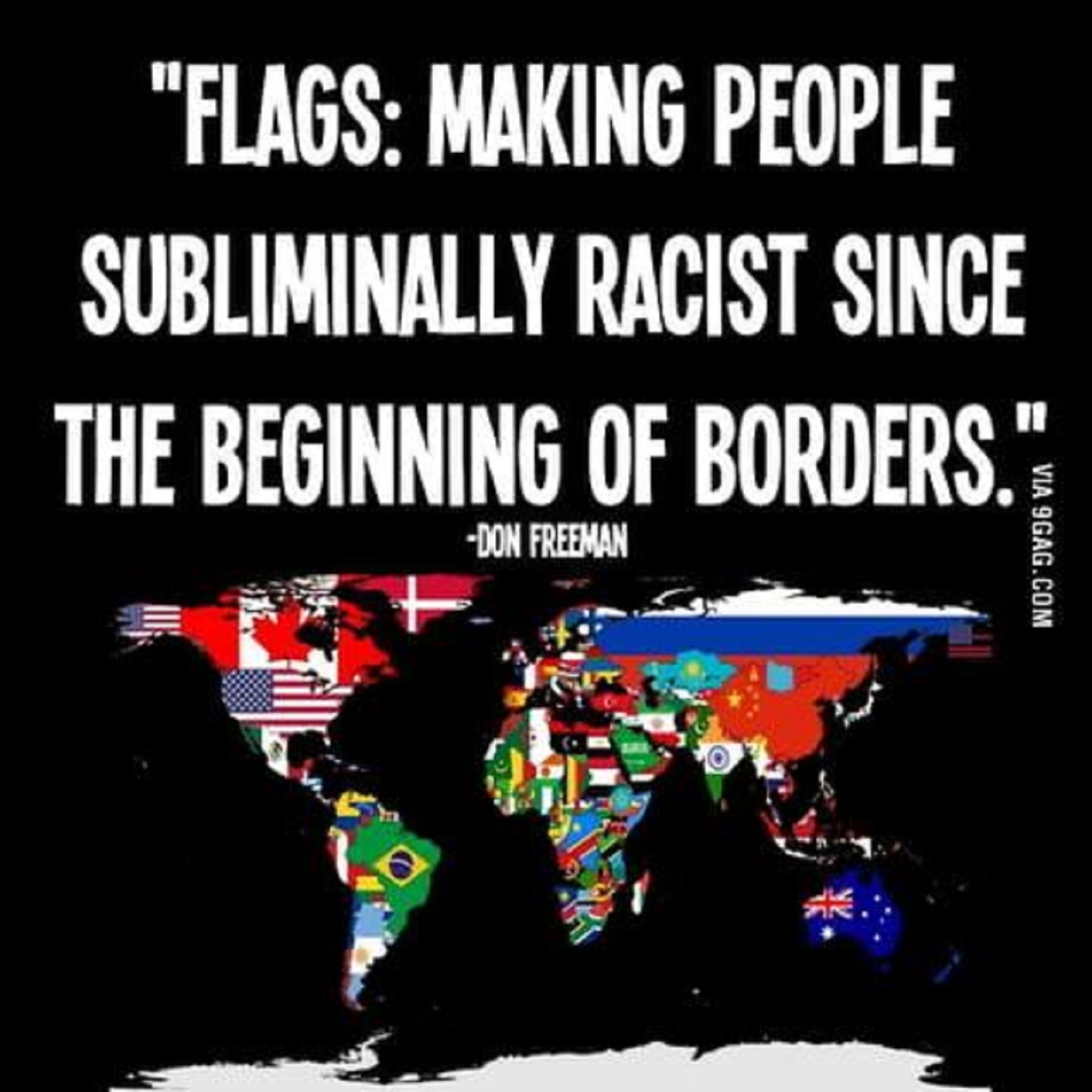
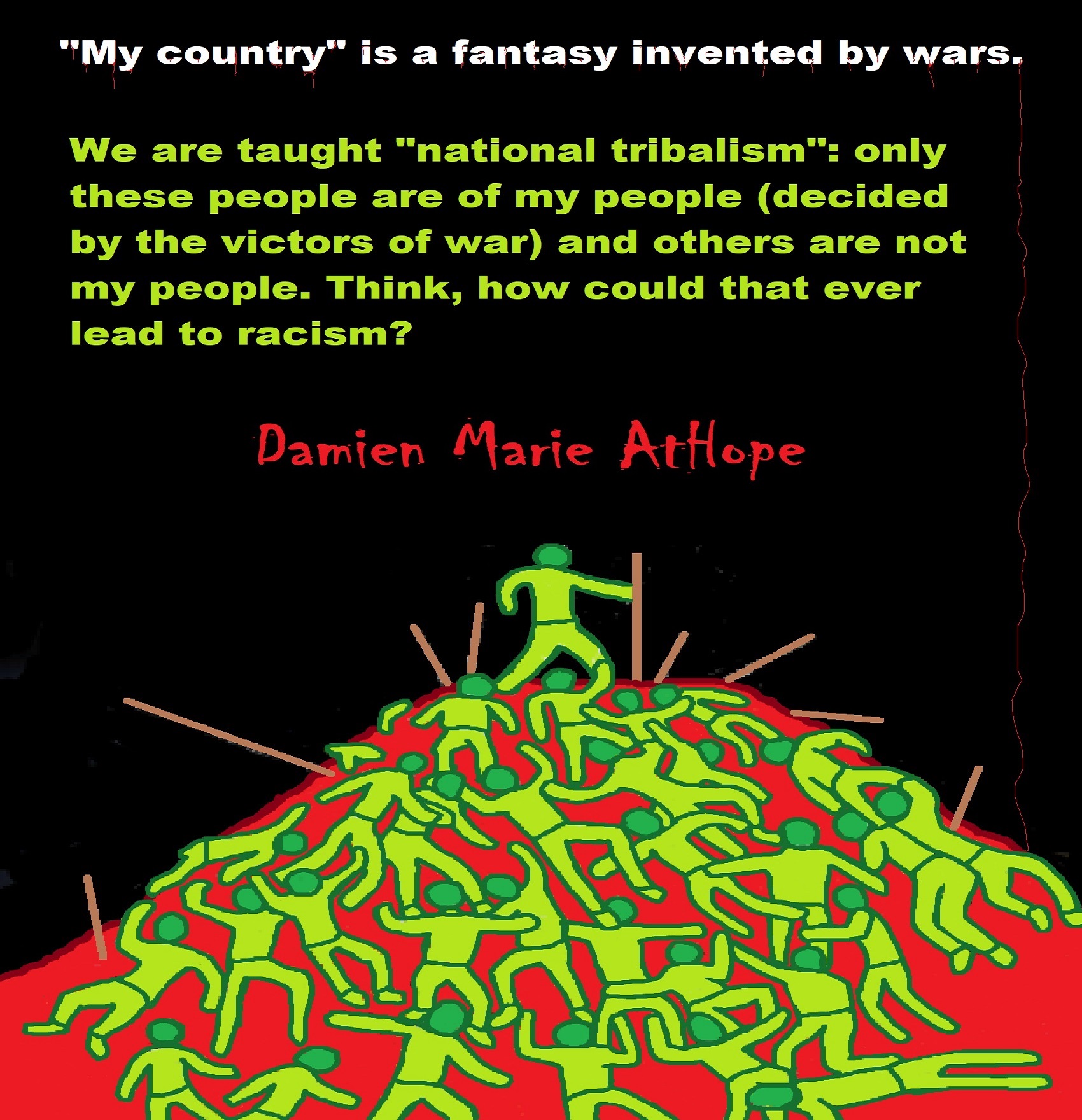


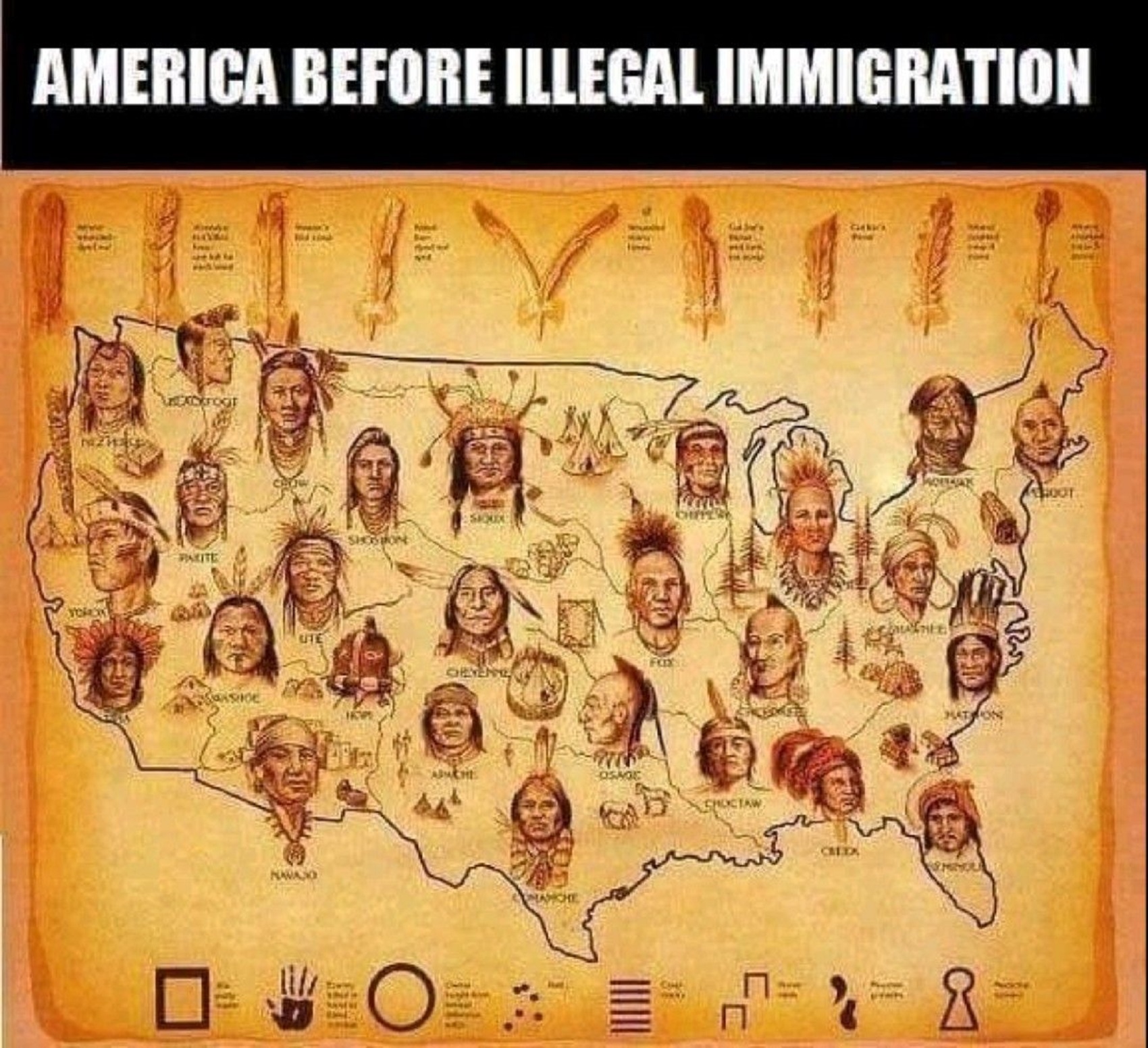
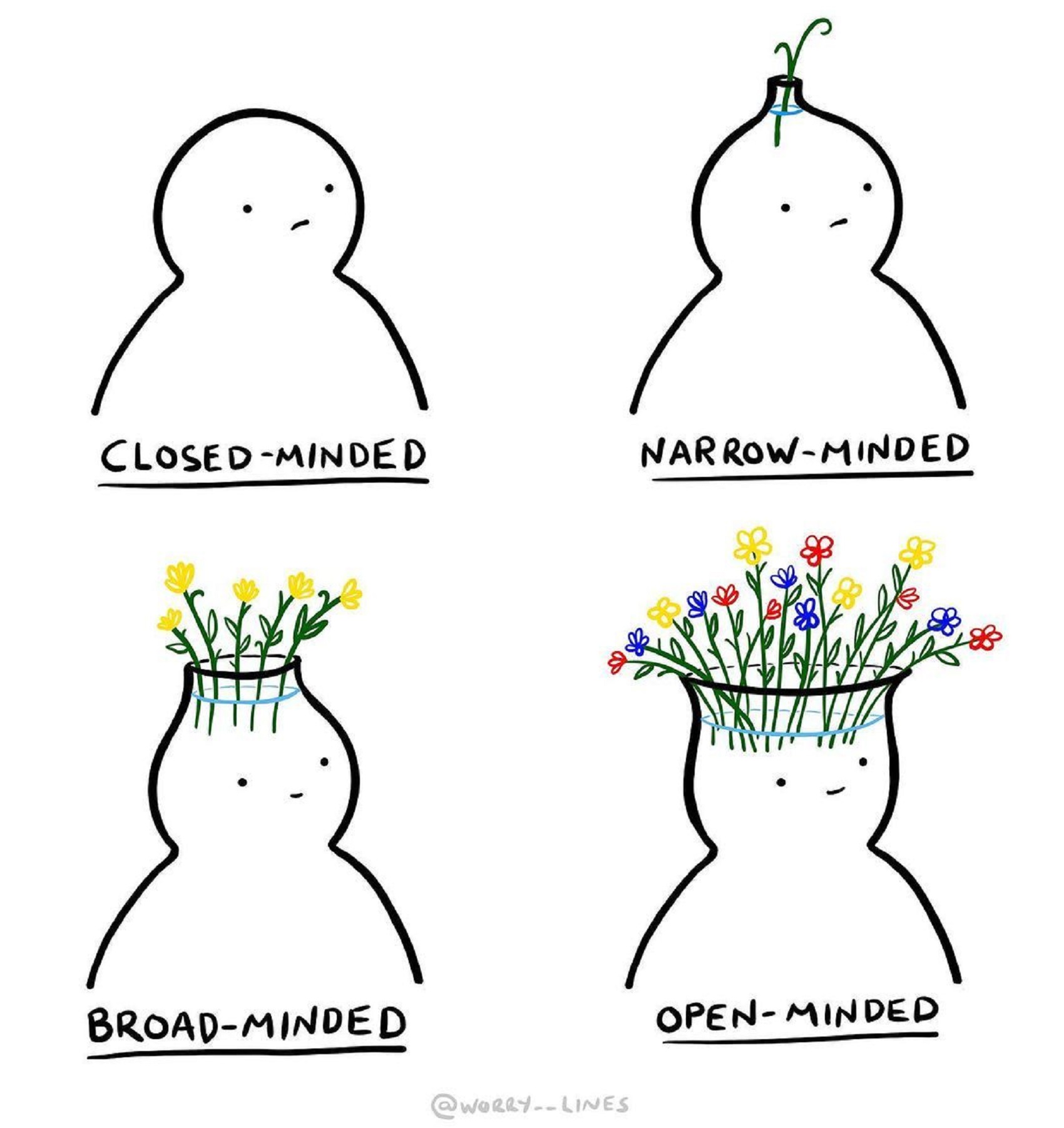


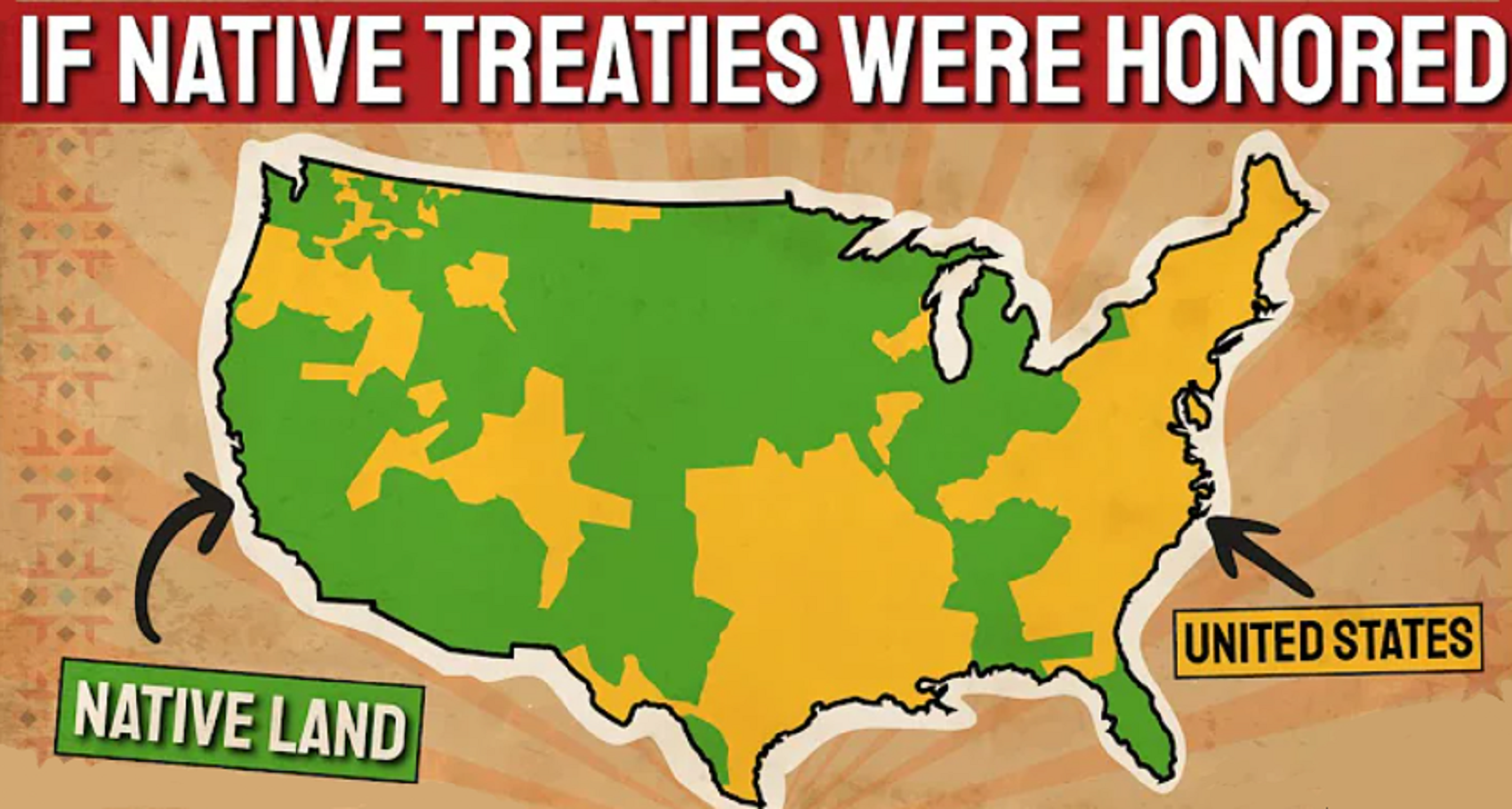

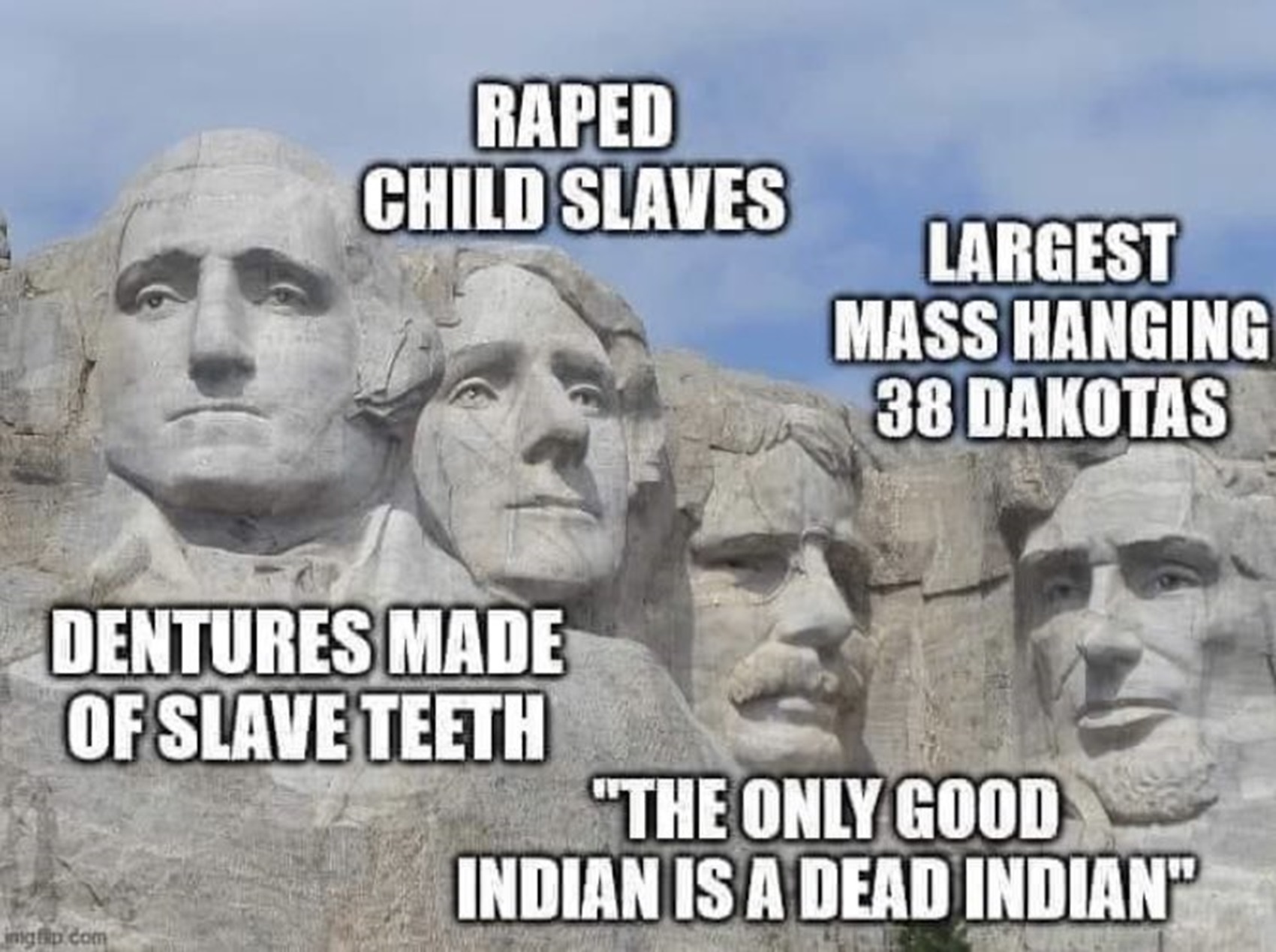
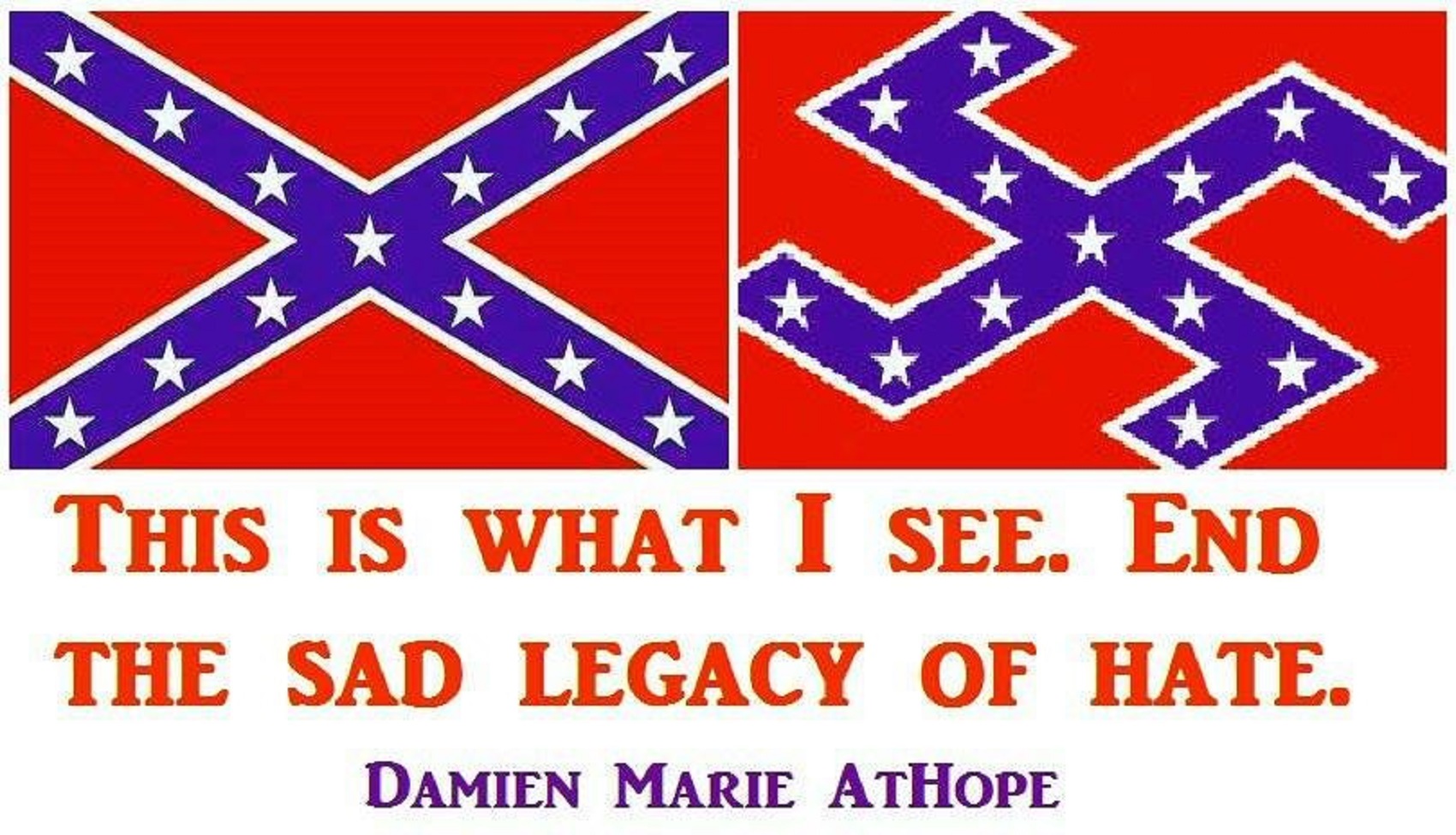

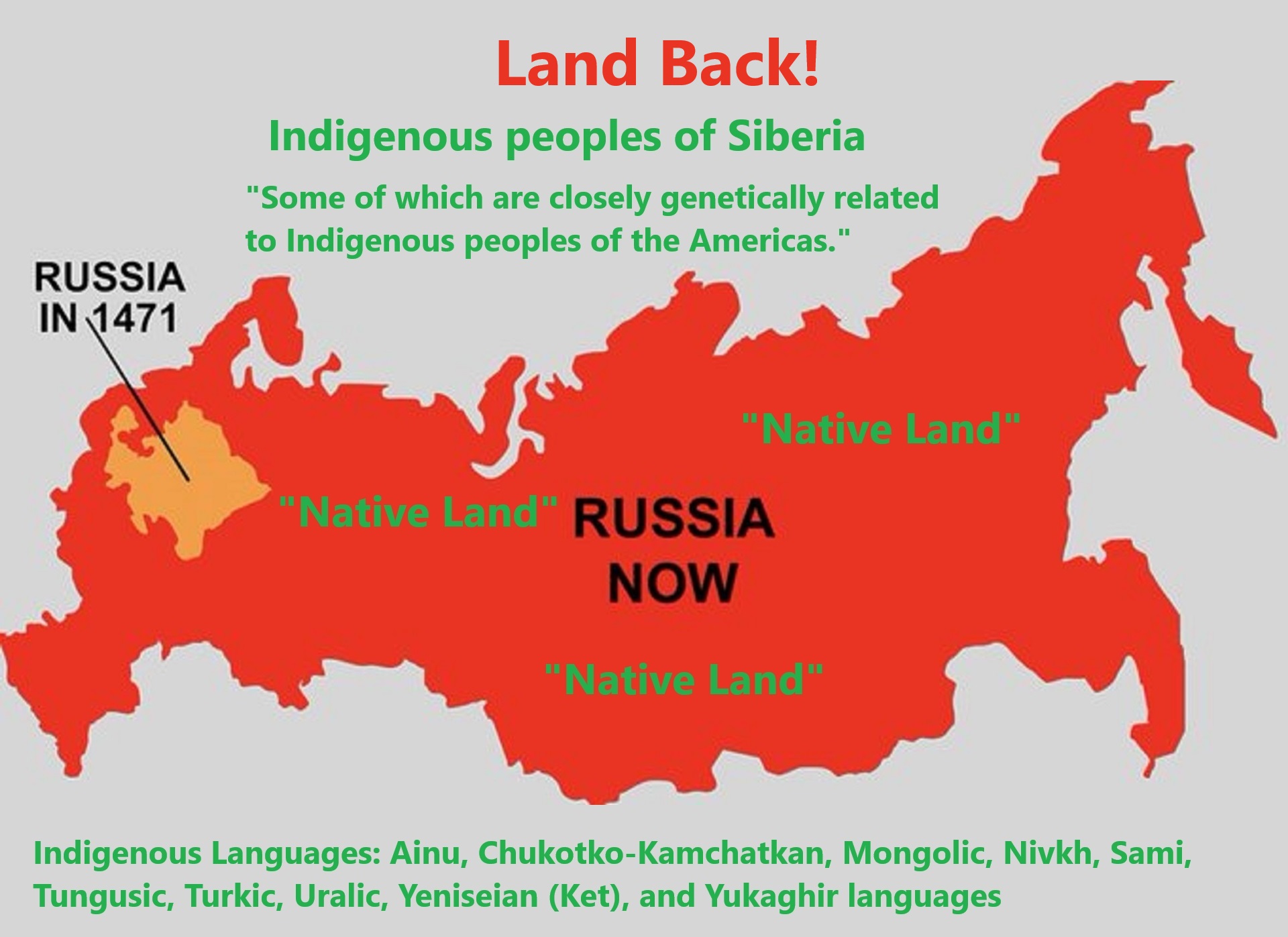

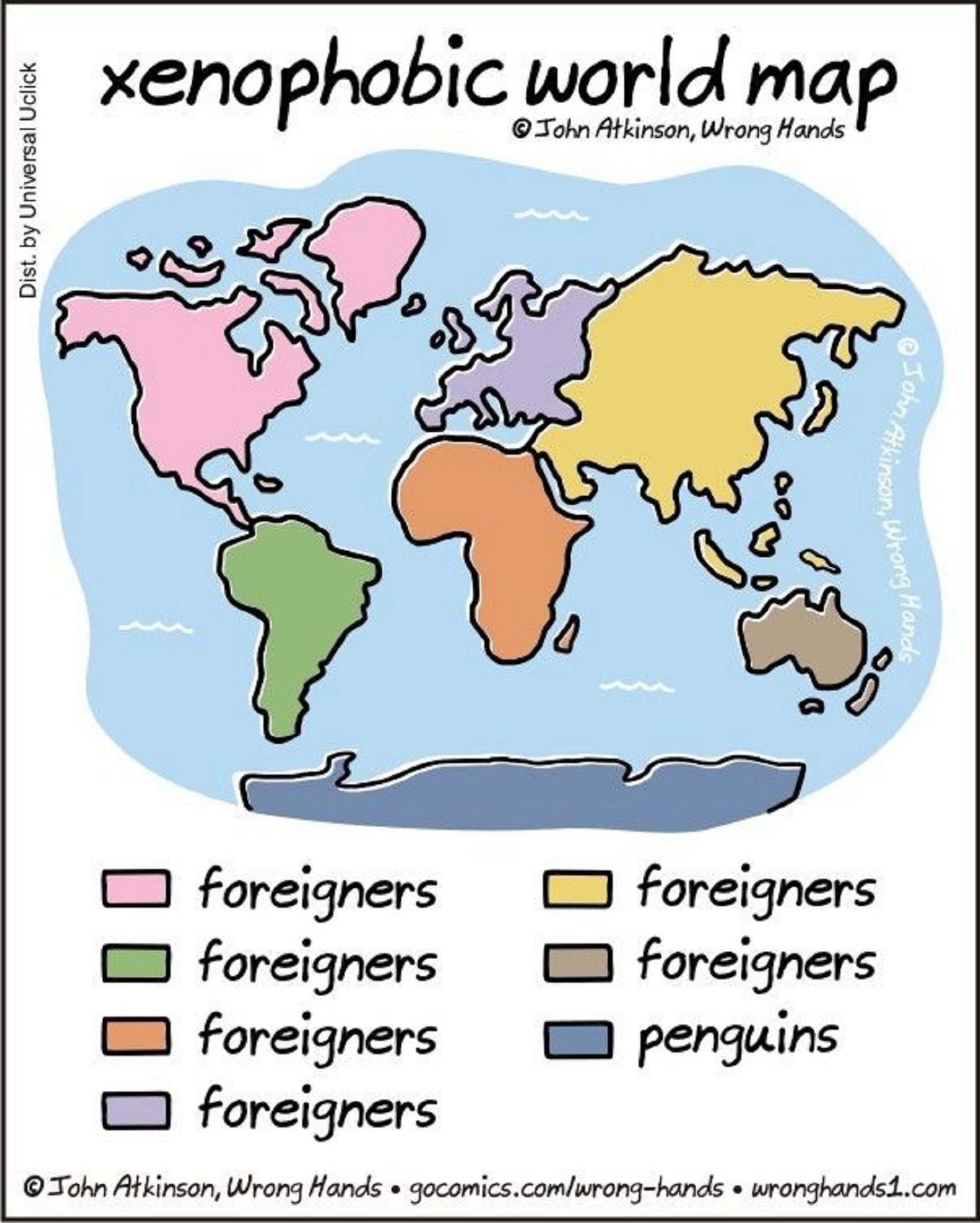
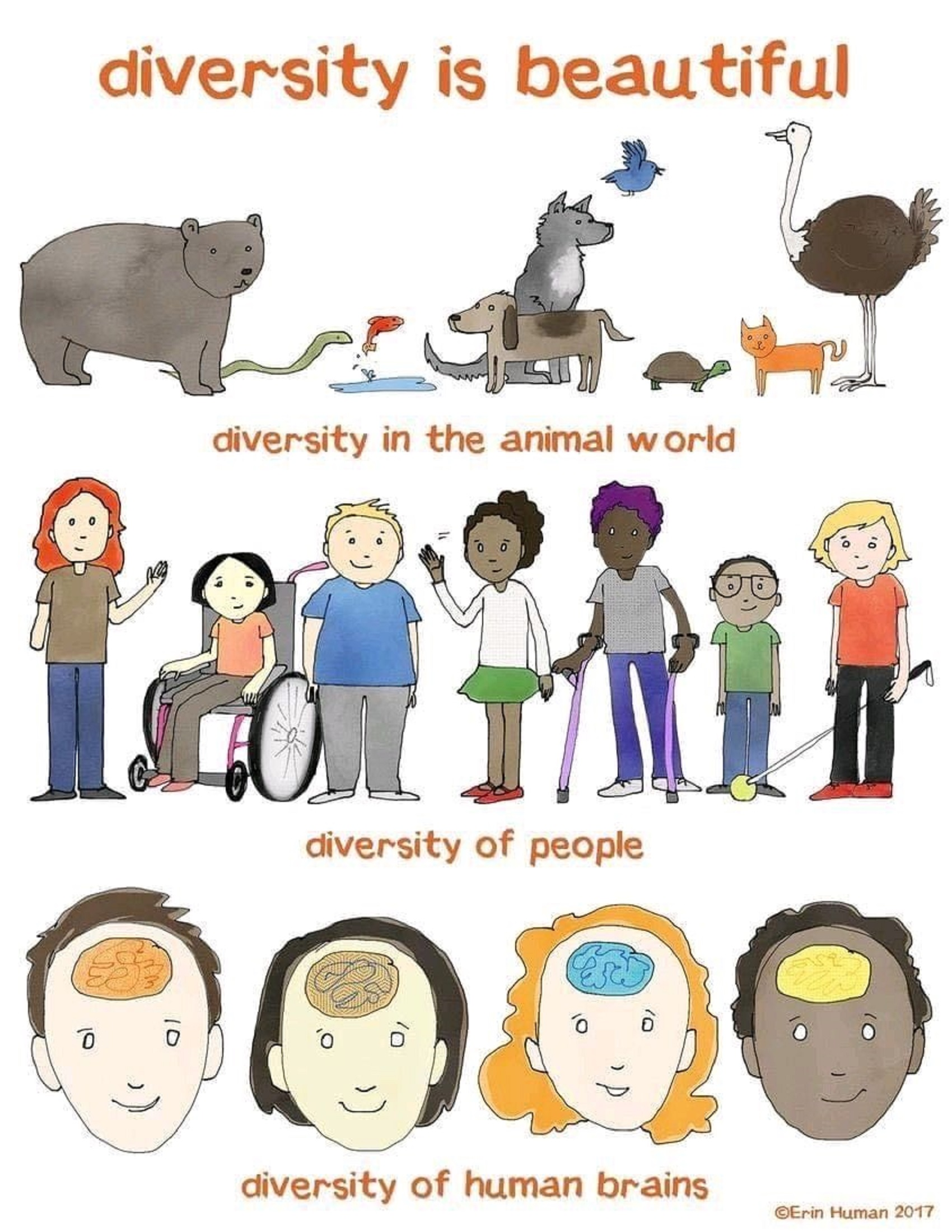





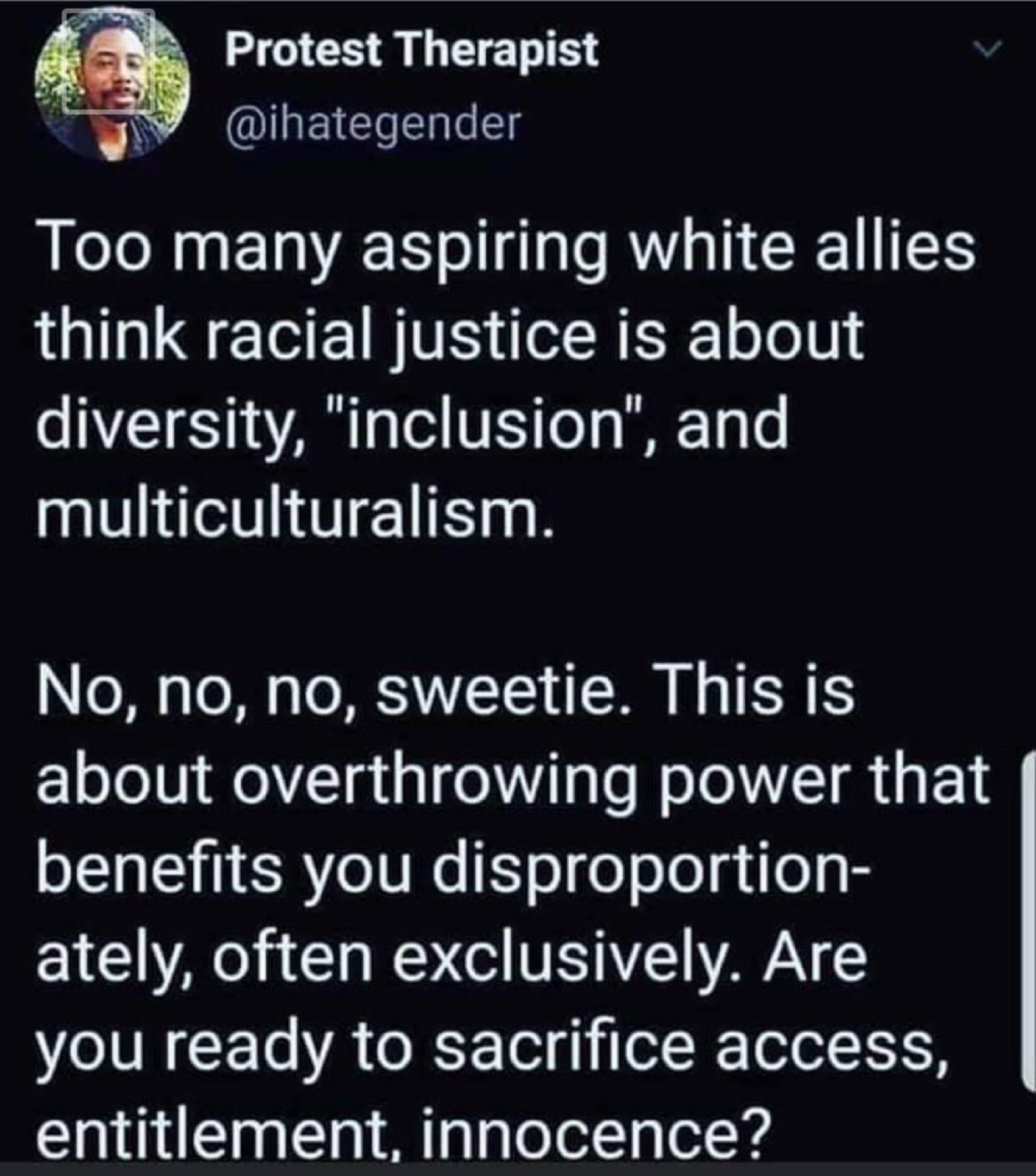
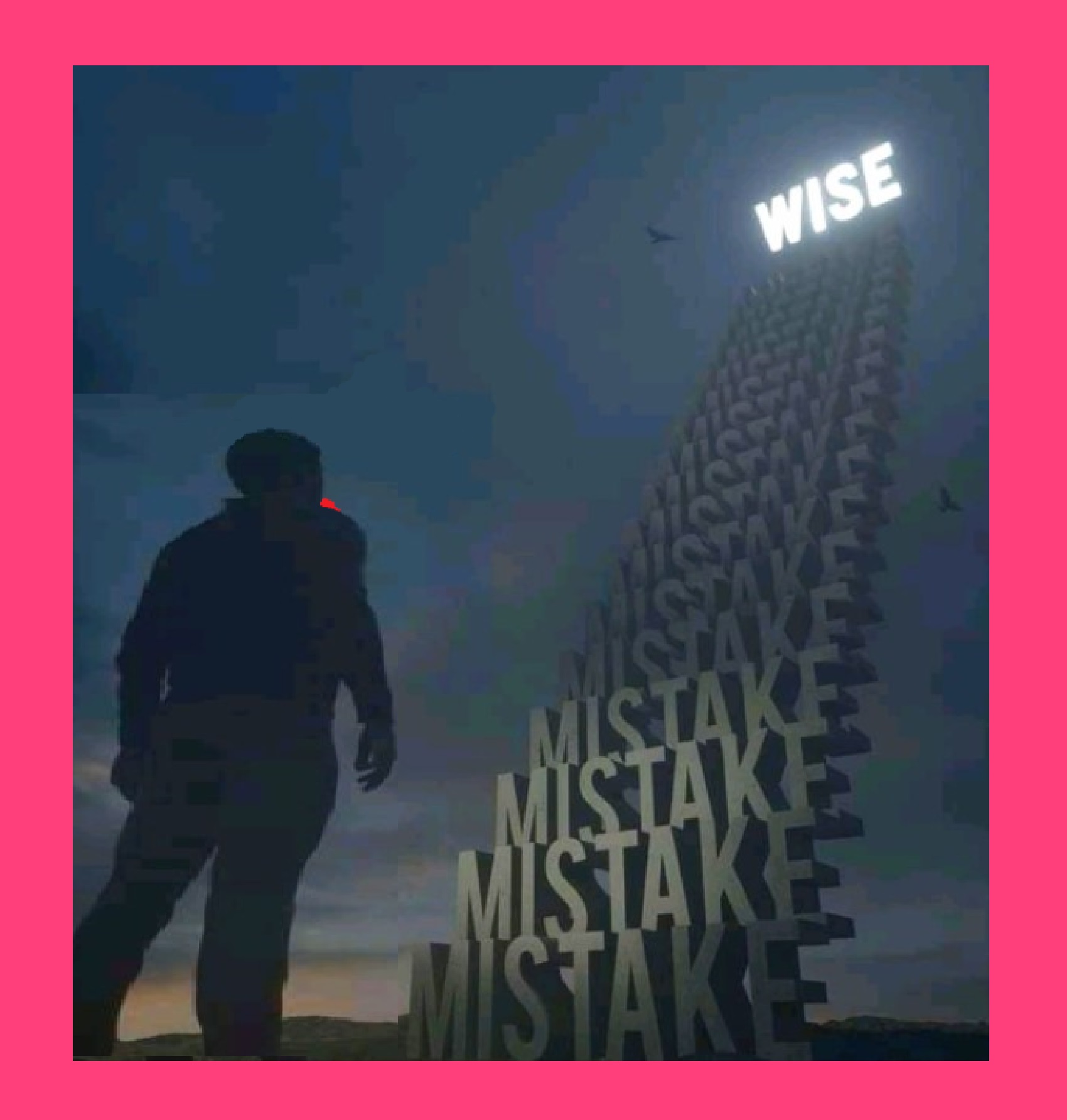
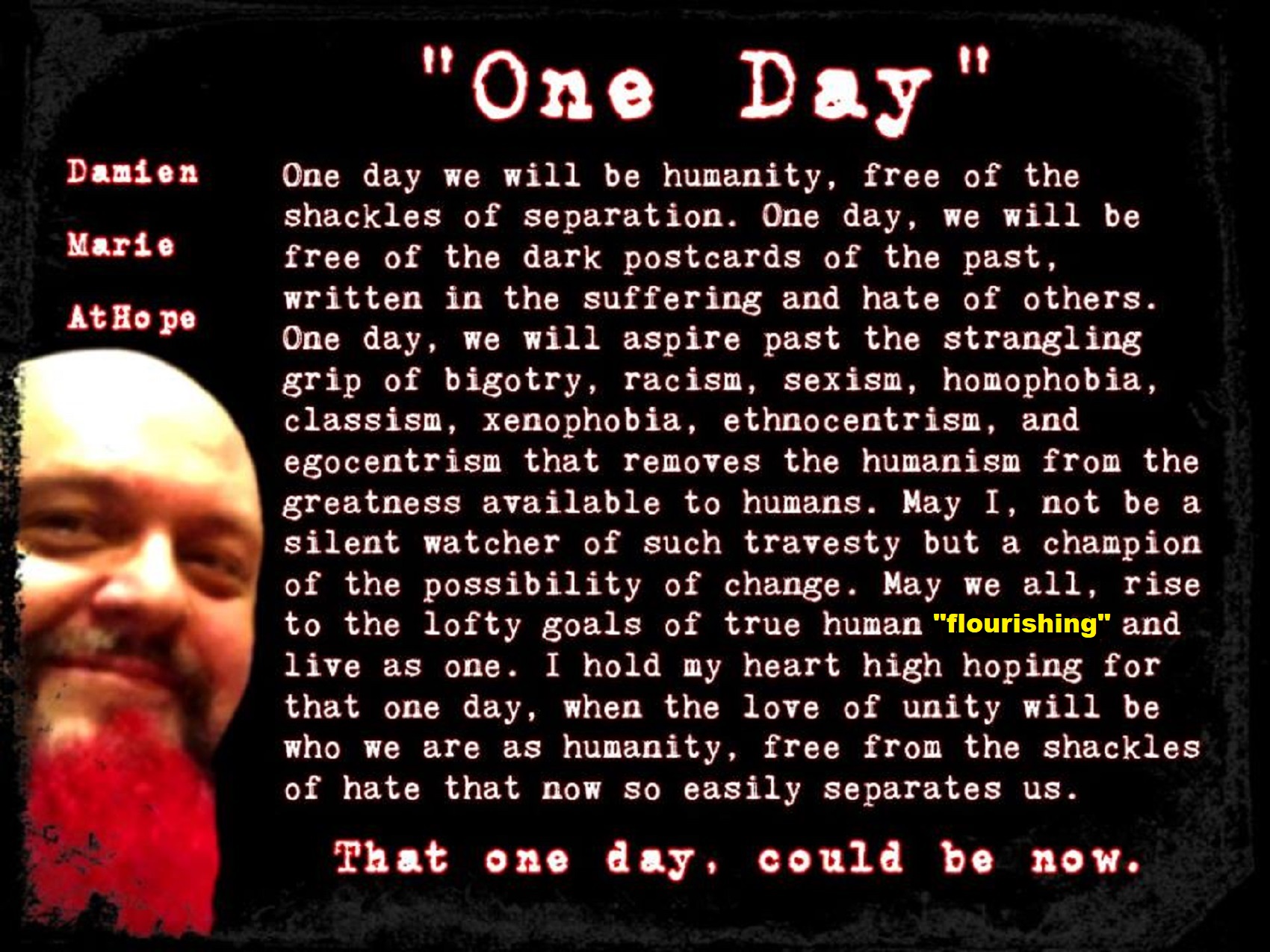

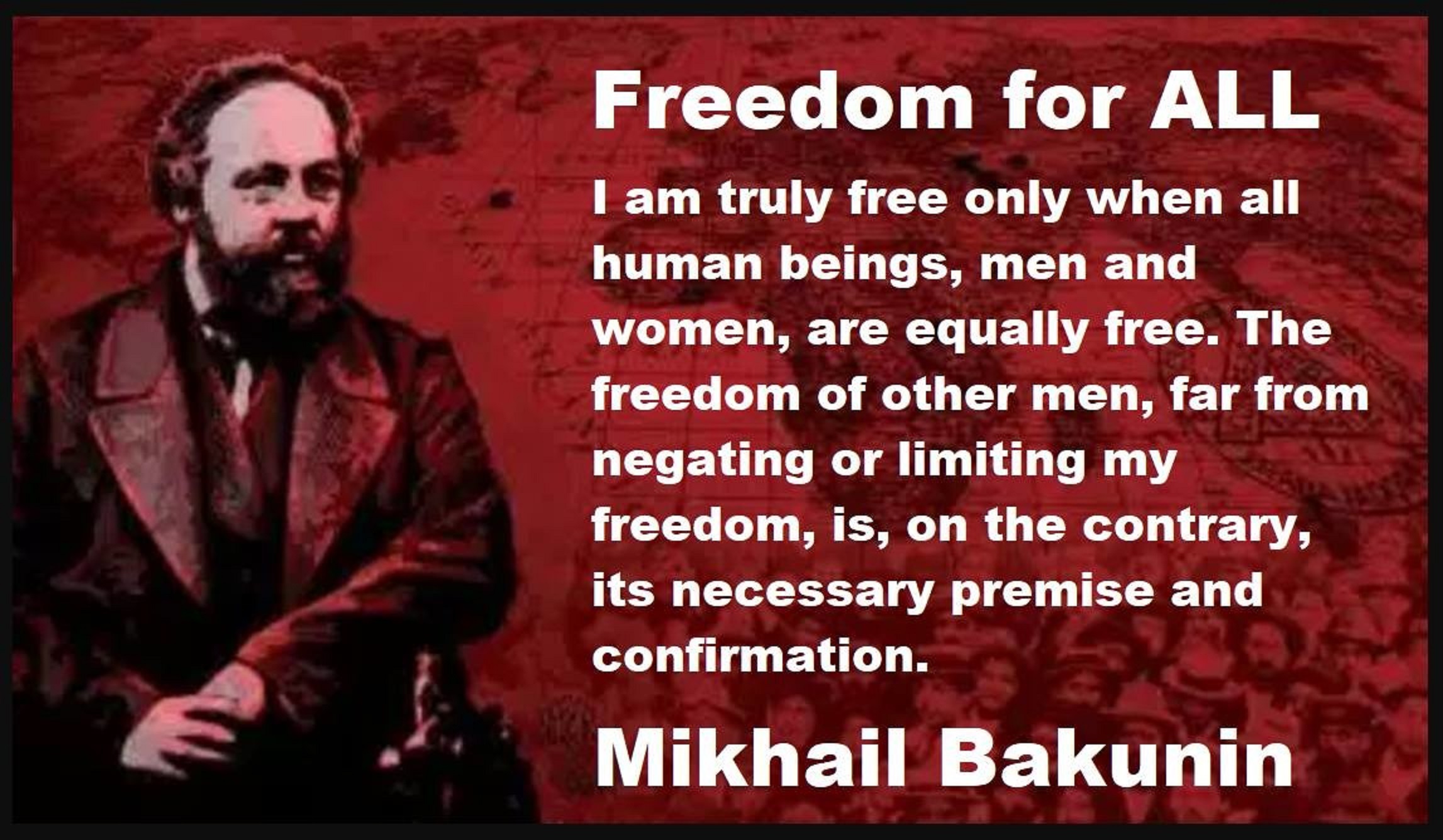
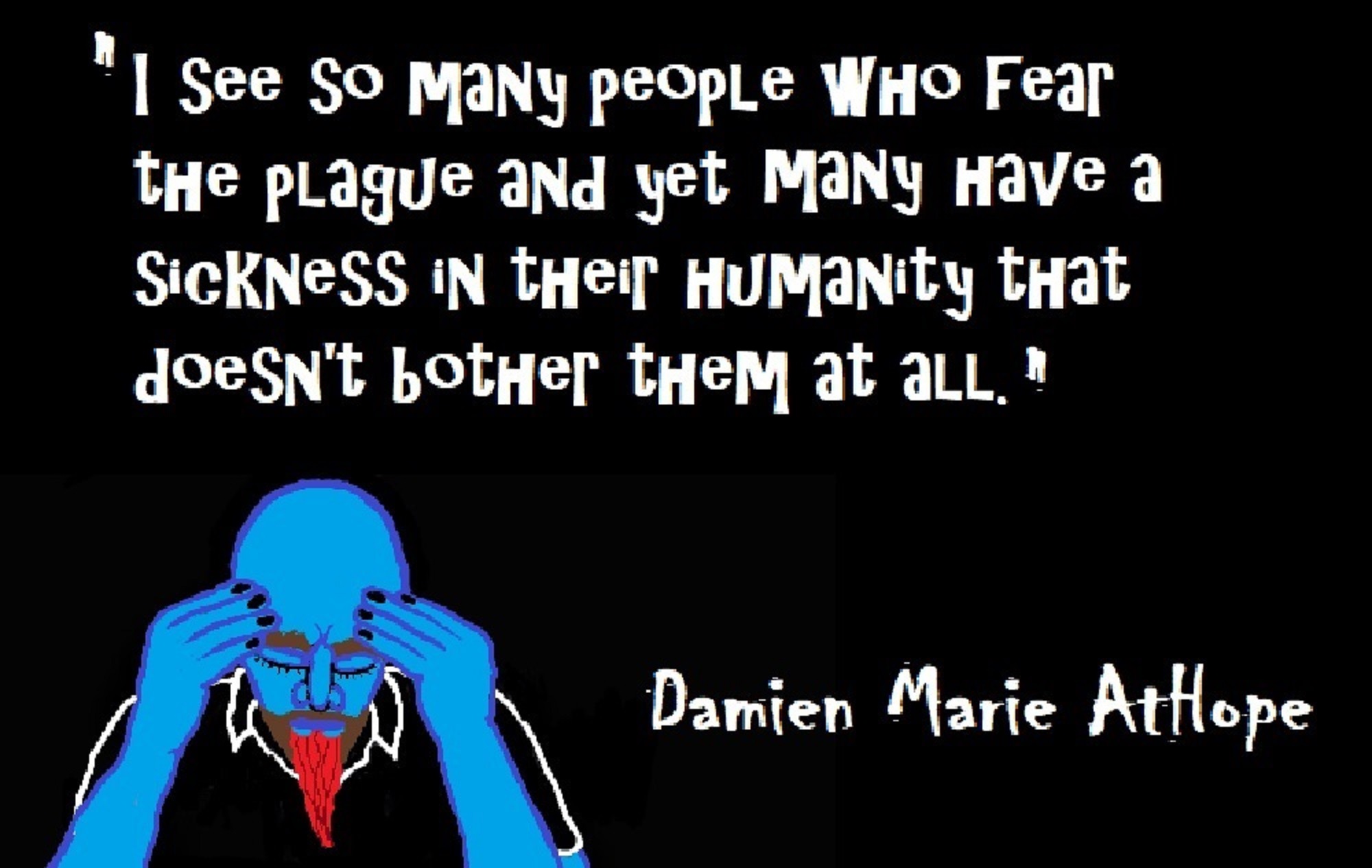
I strive to be a good human ethical in both my thinking and behaviors thus I strive to be:
Anti-racist, Anti-sexist, Anti-homophobic, Anti-biphobic. Anti-transphobic, Anti-classist, Anti-ablest, Anti-ageist, and as Always Antifascist
In fact, I want to strive to avoid as much as I can bigoted thinking towards others based on their perceived membership or classification based on that person’s perceived political affiliation (Well: within reason, justice, and ethics), sex/gender, beliefs (Well: within reason, justice, and ethics), social class (Well: within reason, justice, and ethics), age, disability, religion (Well: within reason, justice, and ethics), sexuality (Well: within reason, justice, and ethics), race, ethnicity, language (Well: within reason, justice, and ethics), nationality, beauty, height, occupation (Well: within reason, justice, and ethics), wealth (Well: within reason, justice, and ethics), education, sport-team affiliation, music tastes or other personal characteristics (Well: within reason, justice, and ethics).
Although, I am a “very”, yes, VERY strong atheist, antitheist as well as antireligionist, My humanity is just as strong and I value it above my disbeliefs. My kind of people are those who champion humanity, the one’s who value kindness, love justice, and support universal empowerment for all humans, we are all equal in dignity, and all deserve human rights, due self-sovereignty.
Someone needs to bring a real lawsuit against America, for crimes against humanity for allowing slavery, in a land shouting that it is the land of the free. Not right!!!

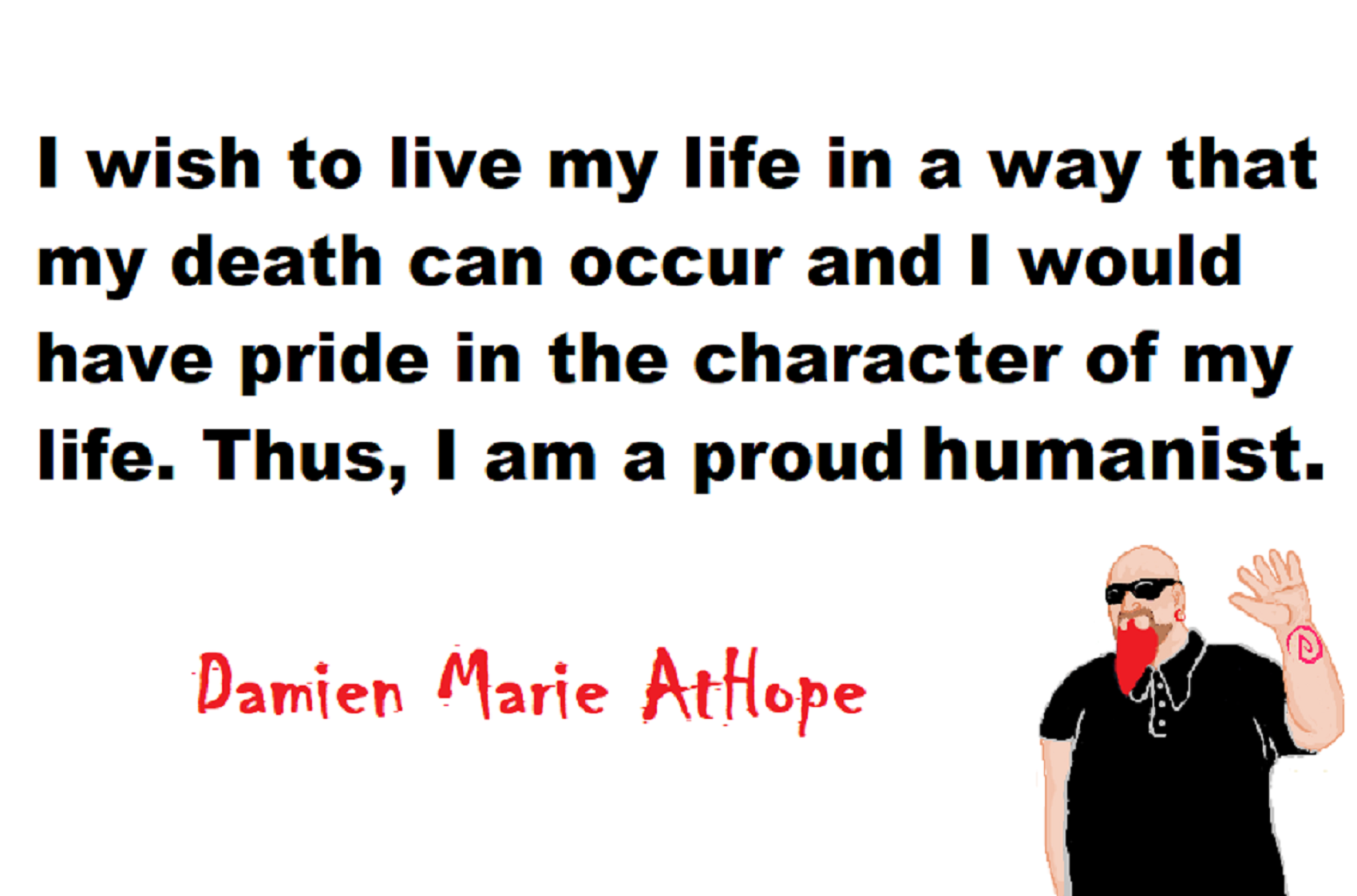

But is Atlantis real?
No. Atlantis (an allegory: “face story” interpreted to reveal a hidden meaning) can’t be found any more than one can locate the Jolly Green Giant that is said to watch over frozen vegetables. Lol


May Reason Set You Free
There are a lot of truly great things said by anarchists in history, and also some deeply vile things, too, from not supporting Women’s rights to Anti-Semitism. There are those who also reject those supporting women’s rights as well as fight anti-Semitism. This is why I push reason as my only master, not anarchist thinking, though anarchism, to me, should see all humans everywhere as equal in dignity and rights.
We—Cory and Damien—are following the greatness that can be found in anarchist thinking.
As an Anarchist Educator, Damien strives to teach the plain truth. Damien does not support violence as my method to change. Rather, I choose education that builds Enlightenment and Empowerment. I champion Dignity and Equality. We rise by helping each other. What is the price of a tear? What is the cost of a smile? How can we see clearly when others pay the cost of our indifference and fear? We should help people in need. Why is that so hard for some people? Rich Ghouls must End. Damien wants “billionaires” to stop being a thing. Tax then into equality. To Damien, there is no debate, Capitalism is unethical. Moreover, as an Anarchist Educator, Damien knows violence is not the way to inspire lasting positive change. But we are not limited to violence, we have education, one of the most lasting and powerful ways to improve the world. We empower the world by championing Truth and its supporters.
Anarchism and Education
“Various alternatives to education and their problems have been proposed by anarchists which have gone from alternative education systems and environments, self-education, advocacy of youth and children rights, and freethought activism.” ref
“Historical accounts of anarchist educational experiments to explore how their pedagogical practices, organization, and content constituted a radical alternative to mainstream forms of educational provision in different historical periods.” ref
“The Ferrer school was an early 20th century libertarian school inspired by the anarchist pedagogy of Francisco Ferrer. He was a proponent of rationalist, secular education that emphasized reason, dignity, self-reliance, and scientific observation. The Ferrer movement’s philosophy had two distinct tendencies: non-didactic freedom from dogma and the more didactic fostering of counter-hegemonic beliefs. Towards non-didactic freedom from dogma, and fulfilled the child-centered tradition.” ref

Teach Real History: all our lives depend on it.
Damien sees lies about history as crimes against humanity. And we all must help humanity by addressing “any and all” who make harmful lies about history.
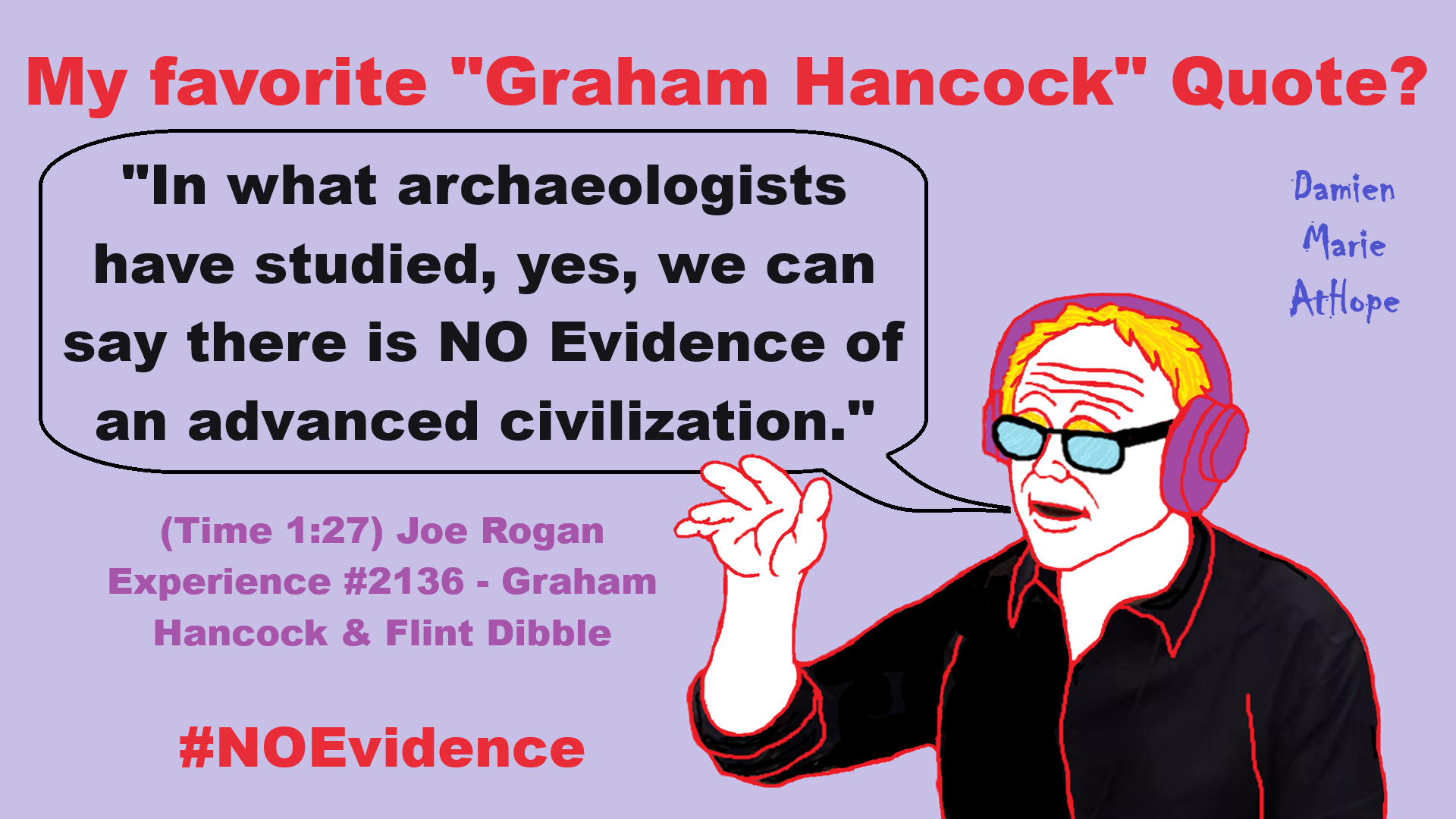
My favorite “Graham Hancock” Quote?
“In what archaeologists have studied, yes, we can say there is NO Evidence of an advanced civilization.” – (Time 1:27) Joe Rogan Experience #2136 – Graham Hancock & Flint Dibble

People don’t commonly teach religious history, even that of their own claimed religion. No, rather they teach a limited “pro their religion” history of their religion from a religious perspective favorable to the religion of choice.

Do you truly think “Religious Belief” is only a matter of some personal choice?
Do you not see how coercive one’s world of choice is limited to the obvious hereditary belief, in most religious choices available to the child of religious parents or caregivers? Religion is more commonly like a family, culture, society, etc. available belief that limits the belief choices of the child and that is when “Religious Belief” is not only a matter of some personal choice and when it becomes hereditary faith, not because of the quality of its alleged facts or proposed truths but because everyone else important to the child believes similarly so they do as well simply mimicking authority beliefs handed to them. Because children are raised in religion rather than being presented all possible choices but rather one limited dogmatic brand of “Religious Belief” where children only have a choice of following the belief as instructed, and then personally claim the faith hereditary belief seen in the confirming to the belief they have held themselves all their lives. This is obvious in statements asked and answered by children claiming a faith they barely understand but they do understand that their family believes “this or that” faith, so they feel obligated to believe it too. While I do agree that “Religious Belief” should only be a matter of some personal choice, it rarely is… End Hereditary Religion!

Animism: Respecting the Living World by Graham Harvey
“How have human cultures engaged with and thought about animals, plants, rocks, clouds, and other elements in their natural surroundings? Do animals and other natural objects have a spirit or soul? What is their relationship to humans? In this new study, Graham Harvey explores current and past animistic beliefs and practices of Native Americans, Maori, Aboriginal Australians, and eco-pagans. He considers the varieties of animism found in these cultures as well as their shared desire to live respectfully within larger natural communities. Drawing on his extensive casework, Harvey also considers the linguistic, performative, ecological, and activist implications of these different animisms.” ref

We are like believing machines we vacuum up ideas, like Velcro sticks to almost everything. We accumulate beliefs that we allow to negatively influence our lives, often without realizing it. Our willingness must be to alter skewed beliefs that impend our balance or reason, which allows us to achieve new positive thinking and accurate outcomes.

My thoughts on Religion Evolution with external links for more info:
- (Pre-Animism Africa mainly, but also Europe, and Asia at least 300,000 years ago), (Pre-Animism – Oxford Dictionaries)
- (Animism Africa around 100,000 years ago), (Animism – Britannica.com)
- (Totemism Europe around 50,000 years ago), (Totemism – Anthropology)
- (Shamanism Siberia around 30,000 years ago), (Shamanism – Britannica.com)
- (Paganism Turkey around 12,000 years ago), (Paganism – BBC Religion)
- (Progressed Organized Religion “Institutional Religion” Egypt around 5,000 years ago), (Ancient Egyptian Religion – Britannica.com)
- (CURRENT “World” RELIGIONS after 4,000 years ago) (Origin of Major Religions – Sacred Texts)
- (Early Atheistic Doubting at least by 2,600 years ago) (History of Atheism – Wikipedia)
“Religion is an Evolved Product” and Yes, Religion is Like Fear Given Wings…
Atheists talk about gods and religions for the same reason doctors talk about cancer, they are looking for a cure, or a firefighter talks about fires because they burn people and they care to stop them. We atheists too often feel a need to help the victims of mental slavery, held in the bondage that is the false beliefs of gods and the conspiracy theories of reality found in religions.
Understanding Religion Evolution:
- Pre-Animism (at least 300,000 years ago)
- Animism (Africa: 100,000 years ago)
- Totemism (Europe: 50,000 years ago)
- Shamanism (Siberia: 30,000 years ago)
- Paganism (Turkey: 12,000 years ago)
- Progressed organized religion (Egypt: 5,000 years ago), (Egypt, the First Dynasty 5,150 years ago)
- CURRENT “World” RELIGIONS (after 4,000 years ago)
- Early Atheistic Doubting (at least by 2,600 years ago)
“An Archaeological/Anthropological Understanding of Religion Evolution”
It seems ancient peoples had to survived amazing threats in a “dangerous universe (by superstition perceived as good and evil),” and human “immorality or imperfection of the soul” which was thought to affect the still living, leading to ancestor worship. This ancestor worship presumably led to the belief in supernatural beings, and then some of these were turned into the belief in gods. This feeble myth called gods were just a human conceived “made from nothing into something over and over, changing, again and again, taking on more as they evolve, all the while they are thought to be special,” but it is just supernatural animistic spirit-belief perceived as sacred.
Quick Evolution of Religion?
Pre-Animism (at least 300,000 years ago) pre-religion is a beginning that evolves into later Animism. So, Religion as we think of it, to me, all starts in a general way with Animism (Africa: 100,000 years ago) (theoretical belief in supernatural powers/spirits), then this is physically expressed in or with Totemism (Europe: 50,000 years ago) (theoretical belief in mythical relationship with powers/spirits through a totem item), which then enlists a full-time specific person to do this worship and believed interacting Shamanism (Siberia/Russia: 30,000 years ago) (theoretical belief in access and influence with spirits through ritual), and then there is the further employment of myths and gods added to all the above giving you Paganism (Turkey: 12,000 years ago) (often a lot more nature-based than most current top world religions, thus hinting to their close link to more ancient religious thinking it stems from). My hypothesis is expressed with an explanation of the building of a theatrical house (modern religions development). Progressed organized religion (Egypt: 5,000 years ago) with CURRENT “World” RELIGIONS (after 4,000 years ago).
Historically, in large city-state societies (such as Egypt or Iraq) starting around 5,000 years ago culminated to make religion something kind of new, a sociocultural-governmental-religious monarchy, where all or at least many of the people of such large city-state societies seem familiar with and committed to the existence of “religion” as the integrated life identity package of control dynamics with a fixed closed magical doctrine, but this juggernaut integrated religion identity package of Dogmatic-Propaganda certainly did not exist or if developed to an extent it was highly limited in most smaller prehistoric societies as they seem to lack most of the strong control dynamics with a fixed closed magical doctrine (magical beliefs could be at times be added or removed). Many people just want to see developed religious dynamics everywhere even if it is not. Instead, all that is found is largely fragments until the domestication of religion.
Religions, as we think of them today, are a new fad, even if they go back to around 6,000 years in the timeline of human existence, this amounts to almost nothing when seen in the long slow evolution of religion at least around 70,000 years ago with one of the oldest ritual worship. Stone Snake of South Africa: “first human worship” 70,000 years ago. This message of how religion and gods among them are clearly a man-made thing that was developed slowly as it was invented and then implemented peace by peace discrediting them all. Which seems to be a simple point some are just not grasping how devastating to any claims of truth when we can see the lie clearly in the archeological sites.
I wish people fought as hard for the actual values as they fight for the group/clan names political or otherwise they think support values. Every amount spent on war is theft to children in need of food or the homeless kept from shelter.
Here are several of my blog posts on history:
- To Find Truth You Must First Look
- (Magdalenian/Iberomaurusian) Connections to the First Paganists of the early Neolithic Near East Dating from around 17,000 to 12,000 Years Ago
- Natufians: an Ancient People at the Origins of Agriculture and Sedentary Life
- Possible Clan Leader/Special “MALE” Ancestor Totem Poles At Least 13,500 years ago?
- Jewish People with DNA at least 13,200 years old, Judaism, and the Origins of Some of its Ideas
- Baltic Reindeer Hunters: Swiderian, Lyngby, Ahrensburgian, and Krasnosillya cultures 12,020 to 11,020 years ago are evidence of powerful migratory waves during the last 13,000 years and a genetic link to Saami and the Finno-Ugric peoples.
- The Rise of Inequality: patriarchy and state hierarchy inequality
- Fertile Crescent 12,500 – 9,500 Years Ago: fertility and death cult belief system?
- 12,400 – 11,700 Years Ago – Kortik Tepe (Turkey) Pre/early-Agriculture Cultic Ritualism
- Ritualistic Bird Symbolism at Gobekli Tepe and its “Ancestor Cult”
- Male-Homosexual (female-like) / Trans-woman (female) Seated Figurine from Gobekli Tepe
- Could a 12,000-year-old Bull Geoglyph at Göbekli Tepe relate to older Bull and Female Art 25,000 years ago and Later Goddess and the Bull cults like Catal Huyuk?
- Sedentism and the Creation of goddesses around 12,000 years ago as well as male gods after 7,000 years ago.
- Alcohol, where Agriculture and Religion Become one? Such as Gobekli Tepe’s Ritualistic use of Grain as Food and Ritual Drink
- Neolithic Ritual Sites with T-Pillars and other Cultic Pillars
- Paganism: Goddesses around 12,000 years ago then Male Gods after 7,000 years ago
- First Patriarchy: Split of Women’s Status around 12,000 years ago & First Hierarchy: fall of Women’s Status around 5,000 years ago.
- Natufians: an Ancient People at the Origins of Agriculture and Sedentary Life
- J DNA and the Spread of Agricultural Religion (paganism)
- Paganism: an approximately 12,000-year-old belief system
- Paganism 12,000 years old: related to “Anarchism and Socialism” (Pre-Capitalism)
- Shaman burial in Israel 12,000 years ago and the Shamanism Phenomena
- Need to Mythicized: gods and goddesses
- 12,000 – 7,000 Years Ago – Paleo-Indian Culture (The Americas)
- 12,000 – 2,000 Years Ago – Indigenous-Scandinavians (Nordic)
- Norse did not wear helmets with horns?
- Pre-Pottery Neolithic Skull Cult around 11,500 to 8,400 Years Ago?
- 10,400 – 10,100 Years Ago, in Turkey the Nevail Cori Religious Settlement
- 9,000-6,500 Years Old Submerged Pre-Pottery/Pottery Neolithic Ritual Settlements off Israel’s Coast
- Catal Huyuk “first religious designed city” around 9,500 to 7,700 years ago (Turkey)
- Cultic Hunting at Catal Huyuk “first religious designed city”
- Special Items and Art as well as Special Elite Burials at Catal Huyuk
- New Rituals and Violence with the appearance of Pottery and People?
- Haplogroup N and its related Uralic Languages and Cultures
- Ainu people, Sámi people, Native Americans, the Ancient North Eurasians, and Paganistic-Shamanism with Totemism
- Ideas, Technology and People from Turkey, Europe, to China and Back again 9,000 to 5,000 years ago?
- First Pottery of Europe and the Related Cultures
- 9,000 years old Neolithic Artifacts Judean Desert and Hills Israel
- 9,000-7,000 years-old Sex and Death Rituals: Cult Sites in Israel, Jordan, and the Sinai
- 9,000-8500 year old Horned Female shaman Bad Dürrenberg Germany
- Neolithic Jewelry and the Spread of Farming in Europe Emerging out of West Turkey
- 8,600-year-old Tortoise Shells in Neolithic graves in central China have Early Writing and Shamanism
- Swing of the Mace: the rise of Elite, Forced Authority, and Inequality begin to Emerge 8,500 years ago?
- Migrations and Changing Europeans Beginning around 8,000 Years Ago
- My “Steppe-Anatolian-Kurgan hypothesis” 8,000/7,000 years ago
- Around 8,000-year-old Shared Idea of the Mistress of Animals, “Ritual” Motif
- Pre-Columbian Red-Paint (red ochre) Maritime Archaic Culture 8,000-3,000 years ago
- 7,522-6,522 years ago Linear Pottery culture which I think relates to Arcane Capitalism’s origins
- Arcane Capitalism: Primitive socialism, Primitive capital, Private ownership, Means of production, Market capitalism, Class discrimination, and Petite bourgeoisie (smaller capitalists)
- 7,500-4,750 years old Ritualistic Cucuteni-Trypillian culture of Moldova, Romania, and Ukraine
- Roots of a changing early society 7,200-6,700 years ago Jordan and Israel
- Agriculture religion (Paganism) with farming reached Britain between about 7,000 to 6,500 or so years ago and seemingly expressed in things like Western Europe’s Long Barrows
- My Thoughts on Possible Migrations of “R” DNA and Proto-Indo-European?
- “Millet” Spreading from China 7,022 years ago to Europe and related Language may have Spread with it leading to Proto-Indo-European
- Proto-Indo-European (PIE), ancestor of Indo-European languages: DNA, Society, Language, and Mythology
- The Dnieper–Donets culture and Asian varieties of Millet from China to the Black Sea region of Europe by 7,022 years ago
- Kurgan 6,000 years ago/dolmens 7,000 years ago: funeral, ritual, and other?
- 7,020 to 6,020-year-old Proto-Indo-European Homeland of Urheimat or proposed home of their Language and Religion
- Ancient Megaliths: Kurgan, Ziggurat, Pyramid, Menhir, Trilithon, Dolman, Kromlech, and Kromlech of Trilithons
- The Mytheme of Ancient North Eurasian Sacred-Dog belief and similar motifs are found in Indo-European, Native American, and Siberian comparative mythology
- Elite Power Accumulation: Ancient Trade, Tokens, Writing, Wealth, Merchants, and Priest-Kings
- Sacred Mounds, Mountains, Kurgans, and Pyramids may hold deep connections?
- Between 7,000-5,000 Years ago, rise of unequal hierarchy elite, leading to a “birth of the State” or worship of power, strong new sexism, oppression of non-elites, and the fall of Women’s equal status
- Paganism 7,000-5,000 years old: related to “Anarchism and Socialism” (Capitalism) (World War 0) Elite & their slaves
- Hell and Underworld mythologies starting maybe as far back as 7,000 to 5,000 years ago with the Proto-Indo-Europeans?
- The First Expression of the Male God around 7,000 years ago?
- White (light complexion skin) Bigotry and Sexism started 7,000 years ago?
- Around 7,000-year-old Shared Idea of the Divine Bird (Tutelary and/or Trickster spirit/deity), “Ritual” Motif
- Nekhbet an Ancient Egyptian Vulture Goddess and Tutelary Deity
- 6,720 to 4,920 years old Ritualistic Hongshan Culture of Inner Mongolia with 5,000-year-old Pyramid Mounds and Temples
- First proto-king in the Balkans, Varna culture around 6,500 years ago?
- 6,500–5,800 years ago in Israel Late Chalcolithic (Copper Age) Period in the Southern Levant Seems to Express Northern Levant Migrations, Cultural and Religious Transfer
- KING OF BEASTS: Master of Animals “Ritual” Motif, around 6,000 years old or older…
- Around 6000-year-old Shared Idea of the Solid Wheel & the Spoked Wheel-Shaped Ritual Motif
- “The Ghassulian Star,” a mysterious 6,000-year-old mural from Jordan; a Proto-Star of Ishtar, Star of Inanna or Star of Venus?
- Religious/Ritual Ideas, including goddesses and gods as well as ritual mounds or pyramids from Northeastern Asia at least 6,000 years old, seemingly filtering to Iran, Iraq, the Mediterranean, Europe, Egypt, and the Americas?
- Maykop (5,720–5,020 years ago) Caucasus region Bronze Age culture-related to Copper Age farmers from the south, influenced by the Ubaid period and Leyla-Tepe culture, as well as influencing the Kura-Araxes culture
- 5-600-year-old Tomb, Mummy, and First Bearded Male Figurine in a Grave
- Kura-Araxes Cultural 5,520 to 4,470 years old DNA traces to the Canaanites, Arabs, and Jews
- Minoan/Cretan (Keftiu) Civilization and Religion around 5,520 to 3,120 years ago
- Evolution Of Science at least by 5,500 years ago
- 5,500 Years old birth of the State, the rise of Hierarchy, and the fall of Women’s status
- “Jiroft culture” 5,100 – 4,200 years ago and the History of Iran
- Stonehenge: Paganistic Burial and Astrological Ritual Complex, England (5,100-3,600 years ago)
- Around 5,000-year-old Shared Idea of the “Tree of Life” Ritual Motif
- Complex rituals for elite, seen from China to Egypt, at least by 5,000 years ago
- Around 5,000 years ago: “Birth of the State” where Religion gets Military Power and Influence
- The Center of the World “Axis Mundi” and/or “Sacred Mountains” Mythology Could Relate to the Altai Mountains, Heart of the Steppe
- Progressed organized religion starts, an approximately 5,000-year-old belief system
- China’s Civilization between 5,000-3,000 years ago, was a time of war and class struggle, violent transition from free clans to a Slave or Elite society
- Origin of Logics is Naturalistic Observation at least by around 5,000 years ago.
- Paganism 5,000 years old: progressed organized religion and the state: related to “Anarchism and Socialism” (Kings and the Rise of the State)
- Ziggurats (multi-platform temples: 4,900 years old) to Pyramids (multi-platform tombs: 4,700 years old)
- Did a 4,520–4,420-year-old Volcano In Turkey Inspire the Bible God?
- Finland’s Horned Shaman and Pre-Horned-God at least 4,500 years ago?
- 4,000-year-Old Dolmens in Israel: A Connected Dolmen Religious Phenomenon?
- Creation myths: From chaos, Ex nihilo, Earth-diver, Emergence, World egg, and World parent
- Bronze Age “Ritual” connections of the Bell Beaker culture with the Corded Ware/Single Grave culture, which were related to the Yamnaya culture and Proto-Indo-European Languages/Religions
- Low Gods (Earth/ Tutelary deity), High Gods (Sky/Supreme deity), and Moralistic Gods (Deity enforcement/divine order)
- The exchange of people, ideas, and material-culture including, to me, the new god (Sky Father) and goddess (Earth Mother) religion between the Cucuteni-Trypillians and others which is then spread far and wide
- Koryaks: Indigenous People of the Russian Far East and Big Raven myths also found in Tlingit, Haida, Tsimshian, and other Indigenous People of North America
- 42 Principles Of Maat (Egyptian Goddess of the justice) around 4,400 years ago, 2000 Years Before Ten Commandments
- “Happy Easter” Well Happy Eostre/Ishter
- 4,320-3,820 years old “Shimao” (North China) site with Totemistic-Shamanistic Paganism and a Stepped Pyramid
- 4,250 to 3,400 Year old Stonehenge from Russia: Arkaim?
- 4,100-year-old beaker with medicinal & flowering plants in a grave of a woman in Scotland
- Early European Farmer ancestry, Kelif el Boroud people with the Cardial Ware culture, and the Bell Beaker culture Paganists too, spread into North Africa, then to the Canary Islands off West Africa
- Flood Accounts: Gilgamesh epic (4,100 years ago) Noah in Genesis (2,600 years ago)
- Paganism 4,000 years old: related to “Anarchism and Socialism” (First Moralistic gods, then the Origin time of Monotheism)
- When was the beginning: TIMELINE OF CURRENT RELIGIONS, which start around 4,000 years ago.
- Early Religions Thought to Express Proto-Monotheistic Systems around 4,000 years ago
- Kultepe? An archaeological site with a 4,000 years old women’s rights document.
- Single God Religions (Monotheism) = “Man-o-theism” started around 4,000 years ago with the Great Sky Spirit/God Tiān (天)?
- Confucianism’s Tiān (Shangdi god 4,000 years old): Supernaturalism, Pantheism or Theism?
- Yes, Your Male God is Ridiculous
- Mythology, a Lunar Deity is a Goddess or God of the Moon
- Sacred Land, Hills, and Mountains: Sami Mythology (Paganistic Shamanism)
- Horse Worship/Sacrifice: mythical union of Ruling Elite/Kingship and the Horse
- The Amorite/Amurru people’s God Amurru “Lord of the Steppe”, relates to the Origins of the Bible God?
- Bronze Age Exotic Trade Routes Spread Quite Far as well as Spread Religious Ideas with Them
- Sami and the Northern Indigenous Peoples Landscape, Language, and its Connection to Religion
- Prototype of Ancient Analemmatic Sundials around 3,900-3,150 years ago and a Possible Solar Connection to gods?
- Judaism is around 3,450 or 3,250 years old. (“Paleo-Hebrew” 3,000 years ago and Torah 2,500 years ago)
- The Weakening of Ancient Trade and the Strengthening of Religions around 3000 years ago?
- Are you aware that there are religions that worship women gods, explain now religion tears women down?
- Animistic, Totemistic, and Paganistic Superstition Origins of bible god and the bible’s Religion.
- Myths and Folklore: “Trickster gods and goddesses”
- Jews, Judaism, and the Origins of Some of its Ideas
- An Old Branch of Religion Still Giving Fruit: Sacred Trees
- Dating the BIBLE: naming names and telling times (written less than 3,000 years ago, provable to 2,200 years ago)
- Did a Volcano Inspire the bible god?
- The Amorite/Amurru people’s God Amurru “Lord of the Steppe”, relates to the Origins of the Bible God?
- Dené–Yeniseian language, Old Copper Complex, and Pre-Columbian Mound Builders?
- No “dinosaurs and humans didn’t exist together just because some think they are in the bible itself”
- Sacred Shit and Sacred Animals?
- Everyone Killed in the Bible Flood? “Nephilim” (giants)?
- Hey, Damien dude, I have a question for you regarding “the bible” Exodus.
- Archaeology Disproves the Bible
- Bible Battle, Just More, Bible Babble
- The Jericho Conquest lie?
- Canaanites and Israelites?
- Accurate Account on how did Christianity Began?
- Let’s talk about Christianity.
- So the 10 commandments isn’t anything to go by either right?
- Misinformed christian
- Debunking Jesus?
- Paulism vs Jesus
- Ok, you seem confused so let’s talk about Buddhism.
- Unacknowledged Buddhism: Gods, Savior, Demons, Rebirth, Heavens, Hells, and Terrorism
- His Foolishness The Dalai Lama
- Yin and Yang is sexist with an ORIGIN around 2,300 years ago?
- I Believe Archaeology, not Myths & Why Not, as the Religious Myths Already Violate Reason!
- Archaeological, Scientific, & Philosophic evidence shows the god myth is man-made nonsense.
- Aquatic Ape Theory/Hypothesis? As Always, Just Pseudoscience.
- Ancient Aliens Conspiracy Theorists are Pseudohistorians
- The Pseudohistoric and Pseudoscientific claims about “Bakoni Ruins” of South Africa
- Why do people think Religion is much more than supernaturalism and superstitionism?
- Religion is an Evolved Product
- Was the Value of Ancient Women Different?
- 1000 to 1100 CE, human sacrifice Cahokia Mounds a pre-Columbian Native American site
- Feminist atheists as far back as the 1800s?
- Promoting Religion as Real is Mentally Harmful to a Flourishing Humanity
- Screw All Religions and Their Toxic lies, they are all fraud
- Forget Religions’ Unfounded Myths, I Have Substantiated “Archaeology Facts.”
- Religion Dispersal throughout the World
- I Hate Religion Just as I Hate all Pseudoscience
- Exposing Scientology, Eckankar, Wicca and Other Nonsense?
- Main deity or religious belief systems
- Quit Trying to Invent Your God From the Scraps of Science.
- Archaeological, Scientific, & Philosophic evidence shows the god myth is man-made nonsense.
- Ancient Alien Conspiracy Theorists: Misunderstanding, Rhetoric, Misinformation, Fabrications, and Lies
- Misinformation, Distortion, and Pseudoscience in Talking with a Christian Creationist
- Judging the Lack of Goodness in Gods, Even the Norse God Odin
- Challenging the Belief in God-like Aliens and Gods in General
- A Challenge to Christian use of Torture Devices?
- Yes, Hinduism is a Religion
- Trump is One of the Most Reactionary Forces of Far-right Christian Extremism
- Was the Bull Head a Symbol of God? Yes!
- Primate Death Rituals
- Christian – “God and Christianity are objectively true”
- Australopithecus afarensis Death Ritual?
- You Claim Global Warming is a Hoax?
- Doubter of Science and Defamer of Atheists?
- I think that sounds like the Bible?
- History of the Antifa (“anti-fascist”) Movements
- Indianapolis Anti-Blasphemy Laws #Free Soheil Rally
- Damien, you repeat the golden rule in so many forms then you say religion is dogmatic?
- Science is a Trustable Methodology whereas Faith is not Trustable at all!
- Was I ever a believer, before I was an atheist?
- Atheists rise in reason
- Mistrust of science?
- Open to Talking About the Definition of ‘God’? But first, we address Faith.
- ‘United Monarchy’ full of splendor and power – Saul, David, and Solomon? Most likely not.
- Is there EXODUS ARCHAEOLOGY? The short answer is “no.”
- Lacking Proof of Bigfoots, Unicorns, and Gods is Just a Lack of Research?
- Religion and Politics: Faith Beliefs vs. Rational Thinking
- Hammer of Truth that lying pig RELIGION: challenged by an archaeologist
- “The Hammer of Truth” -ontology question- What do You Mean by That?
- Navigation of a bad argument: Ad Hominem vs. Attack
- Why is it Often Claimed that Gods have a Gender?
- Why are basically all monotheistic religions ones that have a male god?
- Shifting through the Claims in support of Faith
- Dear Mr. AtHope, The 20th Century is an Indictment of Secularism and a Failed Atheist Century
- An Understanding of the Worldwide Statistics and Dynamics of Terrorist Incidents and Suicide Attacks
- Intoxication and Evolution? Addressing and Assessing the “Stoned Ape” or “Drunken Monkey” Theories as Catalysts in Human Evolution
- Sacred Menstrual cloth? Inanna’s knot, Isis knot, and maybe Ma’at’s feather?
- Damien, why don’t the Hebrews accept the bible stories?
- Dealing with a Troll and Arguing Over Word Meaning
- Knowledge without Belief? Justified beliefs or disbeliefs worthy of Knowledge?
- Afrocentrism and African Religions
- Crecganford @crecganford offers history & stories of the people, places, gods, & culture
- Empiricism-Denier?
I am not an academic. I am a revolutionary that teaches in public, in places like social media, and in the streets. I am not a leader by some title given but from my commanding leadership style of simply to start teaching everywhere to everyone, all manner of positive education.



To me, Animism starts in Southern Africa, then to West Europe, and becomes Totemism. Another split goes near the Russia and Siberia border becoming Shamanism, which heads into Central Europe meeting up with Totemism, which also had moved there, mixing the two which then heads to Lake Baikal in Siberia. From there this Shamanism-Totemism heads to Turkey where it becomes Paganism.





Not all “Religions” or “Religious Persuasions” have a god(s) but
All can be said to believe in some imaginary beings or imaginary things like spirits, afterlives, etc.

Paganism 12,000-4,000 years old
12,000-7,000 years old: related to (Pre-Capitalism)
7,000-5,000 years old: related to (Capitalism) (World War 0) Elite and their slaves!
5,000 years old: related to (Kings and the Rise of the State)
4,000 years old: related to (First Moralistic gods, then the Origin time of Monotheism)

ref, ref, ref, ref, ref, ref, ref, ref, ref, ref, ref, ref, ref, ref, ref, ref, ref, ref, ref, ref, ref
Low Gods “Earth” or Tutelary deity and High Gods “Sky” or Supreme deity
“An Earth goddess is a deification of the Earth. Earth goddesses are often associated with the “chthonic” deities of the underworld. Ki and Ninhursag are Mesopotamian earth goddesses. In Greek mythology, the Earth is personified as Gaia, corresponding to Roman Terra, Indic Prithvi/Bhūmi, etc. traced to an “Earth Mother” complementary to the “Sky Father” in Proto-Indo-European religion. Egyptian mythology exceptionally has a sky goddess and an Earth god.” ref
“A mother goddess is a goddess who represents or is a personification of nature, motherhood, fertility, creation, destruction or who embodies the bounty of the Earth. When equated with the Earth or the natural world, such goddesses are sometimes referred to as Mother Earth or as the Earth Mother. In some religious traditions or movements, Heavenly Mother (also referred to as Mother in Heaven or Sky Mother) is the wife or feminine counterpart of the Sky father or God the Father.” ref
“Any masculine sky god is often also king of the gods, taking the position of patriarch within a pantheon. Such king gods are collectively categorized as “sky father” deities, with a polarity between sky and earth often being expressed by pairing a “sky father” god with an “earth mother” goddess (pairings of a sky mother with an earth father are less frequent). A main sky goddess is often the queen of the gods and may be an air/sky goddess in her own right, though she usually has other functions as well with “sky” not being her main. In antiquity, several sky goddesses in ancient Egypt, Mesopotamia, and the Near East were called Queen of Heaven. Neopagans often apply it with impunity to sky goddesses from other regions who were never associated with the term historically. The sky often has important religious significance. Many religions, both polytheistic and monotheistic, have deities associated with the sky.” ref
“In comparative mythology, sky father is a term for a recurring concept in polytheistic religions of a sky god who is addressed as a “father”, often the father of a pantheon and is often either a reigning or former King of the Gods. The concept of “sky father” may also be taken to include Sun gods with similar characteristics, such as Ra. The concept is complementary to an “earth mother“. “Sky Father” is a direct translation of the Vedic Dyaus Pita, etymologically descended from the same Proto-Indo-European deity name as the Greek Zeûs Pater and Roman Jupiter and Germanic Týr, Tir or Tiwaz, all of which are reflexes of the same Proto-Indo-European deity’s name, *Dyēus Ph₂tḗr. While there are numerous parallels adduced from outside of Indo-European mythology, there are exceptions (e.g. In Egyptian mythology, Nut is the sky mother and Geb is the earth father).” ref
Tutelary deity
“A tutelary (also tutelar) is a deity or spirit who is a guardian, patron, or protector of a particular place, geographic feature, person, lineage, nation, culture, or occupation. The etymology of “tutelary” expresses the concept of safety and thus of guardianship. In late Greek and Roman religion, one type of tutelary deity, the genius, functions as the personal deity or daimon of an individual from birth to death. Another form of personal tutelary spirit is the familiar spirit of European folklore.” ref
“A tutelary (also tutelar) in Korean shamanism, jangseung and sotdae were placed at the edge of villages to frighten off demons. They were also worshiped as deities. Seonangshin is the patron deity of the village in Korean tradition and was believed to embody the Seonangdang. In Philippine animism, Diwata or Lambana are deities or spirits that inhabit sacred places like mountains and mounds and serve as guardians. Such as: Maria Makiling is the deity who guards Mt. Makiling and Maria Cacao and Maria Sinukuan. In Shinto, the spirits, or kami, which give life to human bodies come from nature and return to it after death. Ancestors are therefore themselves tutelaries to be worshiped. And similarly, Native American beliefs such as Tonás, tutelary animal spirit among the Zapotec and Totems, familial or clan spirits among the Ojibwe, can be animals.” ref
“A tutelary (also tutelar) in Austronesian beliefs such as: Atua (gods and spirits of the Polynesian peoples such as the Māori or the Hawaiians), Hanitu (Bunun of Taiwan‘s term for spirit), Hyang (Kawi, Sundanese, Javanese, and Balinese Supreme Being, in ancient Java and Bali mythology and this spiritual entity, can be either divine or ancestral), Kaitiaki (New Zealand Māori term used for the concept of guardianship, for the sky, the sea, and the land), Kawas (mythology) (divided into 6 groups: gods, ancestors, souls of the living, spirits of living things, spirits of lifeless objects, and ghosts), Tiki (Māori mythology, Tiki is the first man created by either Tūmatauenga or Tāne and represents deified ancestors found in most Polynesian cultures). ” ref, ref, ref, ref, ref, ref, ref
Mesopotamian Tutelary Deities can be seen as ones related to City-States
“Historical city-states included Sumerian cities such as Uruk and Ur; Ancient Egyptian city-states, such as Thebes and Memphis; the Phoenician cities (such as Tyre and Sidon); the five Philistine city-states; the Berber city-states of the Garamantes; the city-states of ancient Greece (the poleis such as Athens, Sparta, Thebes, and Corinth); the Roman Republic (which grew from a city-state into a vast empire); the Italian city-states from the Middle Ages to the early modern period, such as Florence, Siena, Ferrara, Milan (which as they grew in power began to dominate neighboring cities) and Genoa and Venice, which became powerful thalassocracies; the Mayan and other cultures of pre-Columbian Mesoamerica (including cities such as Chichen Itza, Tikal, Copán and Monte Albán); the central Asian cities along the Silk Road; the city-states of the Swahili coast; Ragusa; states of the medieval Russian lands such as Novgorod and Pskov; and many others.” ref
“The Uruk period (ca. 4000 to 3100 BCE; also known as Protoliterate period) of Mesopotamia, named after the Sumerian city of Uruk, this period saw the emergence of urban life in Mesopotamia and the Sumerian civilization. City-States like Uruk and others had a patron tutelary City Deity along with a Priest-King.” ref
“Chinese folk religion, both past, and present, includes myriad tutelary deities. Exceptional individuals, highly cultivated sages, and prominent ancestors can be deified and honored after death. Lord Guan is the patron of military personnel and police, while Mazu is the patron of fishermen and sailors. Such as Tu Di Gong (Earth Deity) is the tutelary deity of a locality, and each individual locality has its own Earth Deity and Cheng Huang Gong (City God) is the guardian deity of an individual city, worshipped by local officials and locals since imperial times.” ref
“A tutelary (also tutelar) in Hinduism, personal tutelary deities are known as ishta-devata, while family tutelary deities are known as Kuladevata. Gramadevata are guardian deities of villages. Devas can also be seen as tutelary. Shiva is the patron of yogis and renunciants. City goddesses include: Mumbadevi (Mumbai), Sachchika (Osian); Kuladevis include: Ambika (Porwad), and Mahalakshmi. In NorthEast India Meitei mythology and religion (Sanamahism) of Manipur, there are various types of tutelary deities, among which Lam Lais are the most predominant ones. Tibetan Buddhism has Yidam as a tutelary deity. Dakini is the patron of those who seek knowledge.” ref
“A tutelary (also tutelar) The Greeks also thought deities guarded specific places: for instance, Athena was the patron goddess of the city of Athens. Socrates spoke of hearing the voice of his personal spirit or daimonion:
You have often heard me speak of an oracle or sign which comes to me … . This sign I have had ever since I was a child. The sign is a voice which comes to me and always forbids me to do something which I am going to do, but never commands me to do anything, and this is what stands in the way of my being a politician.” ref
“Tutelary deities who guard and preserve a place or a person are fundamental to ancient Roman religion. The tutelary deity of a man was his Genius, that of a woman her Juno. In the Imperial era, the Genius of the Emperor was a focus of Imperial cult. An emperor might also adopt a major deity as his personal patron or tutelary, as Augustus did Apollo. Precedents for claiming the personal protection of a deity were established in the Republican era, when for instance the Roman dictator Sulla advertised the goddess Victory as his tutelary by holding public games (ludi) in her honor.” ref
“Each town or city had one or more tutelary deities, whose protection was considered particularly vital in time of war and siege. Rome itself was protected by a goddess whose name was to be kept ritually secret on pain of death (for a supposed case, see Quintus Valerius Soranus). The Capitoline Triad of Juno, Jupiter, and Minerva were also tutelaries of Rome. The Italic towns had their own tutelary deities. Juno often had this function, as at the Latin town of Lanuvium and the Etruscan city of Veii, and was often housed in an especially grand temple on the arx (citadel) or other prominent or central location. The tutelary deity of Praeneste was Fortuna, whose oracle was renowned.” ref
“The Roman ritual of evocatio was premised on the belief that a town could be made vulnerable to military defeat if the power of its tutelary deity were diverted outside the city, perhaps by the offer of superior cult at Rome. The depiction of some goddesses such as the Magna Mater (Great Mother, or Cybele) as “tower-crowned” represents their capacity to preserve the city. A town in the provinces might adopt a deity from within the Roman religious sphere to serve as its guardian, or syncretize its own tutelary with such; for instance, a community within the civitas of the Remi in Gaul adopted Apollo as its tutelary, and at the capital of the Remi (present-day Rheims), the tutelary was Mars Camulus.” ref
Household deity (a kind of or related to a Tutelary deity)
“A household deity is a deity or spirit that protects the home, looking after the entire household or certain key members. It has been a common belief in paganism as well as in folklore across many parts of the world. Household deities fit into two types; firstly, a specific deity – typically a goddess – often referred to as a hearth goddess or domestic goddess who is associated with the home and hearth, such as the ancient Greek Hestia.” ref
“The second type of household deities are those that are not one singular deity, but a type, or species of animistic deity, who usually have lesser powers than major deities. This type was common in the religions of antiquity, such as the Lares of ancient Roman religion, the Gashin of Korean shamanism, and Cofgodas of Anglo-Saxon paganism. These survived Christianisation as fairy-like creatures existing in folklore, such as the Anglo-Scottish Brownie and Slavic Domovoy.” ref
“Household deities were usually worshipped not in temples but in the home, where they would be represented by small idols (such as the teraphim of the Bible, often translated as “household gods” in Genesis 31:19 for example), amulets, paintings, or reliefs. They could also be found on domestic objects, such as cosmetic articles in the case of Tawaret. The more prosperous houses might have a small shrine to the household god(s); the lararium served this purpose in the case of the Romans. The gods would be treated as members of the family and invited to join in meals, or be given offerings of food and drink.” ref
“In many religions, both ancient and modern, a god would preside over the home. Certain species, or types, of household deities, existed. An example of this was the Roman Lares. Many European cultures retained house spirits into the modern period. Some examples of these include:
- Brownie (Scotland and England) or Hob (England) / Kobold (Germany) / Goblin / Hobgoblin
- Domovoy (Slavic)
- Nisse (Norwegian or Danish) / Tomte (Swedish) / Tonttu (Finnish)
- Húsvættir (Norse)” ref
“Although the cosmic status of household deities was not as lofty as that of the Twelve Olympians or the Aesir, they were also jealous of their dignity and also had to be appeased with shrines and offerings, however humble. Because of their immediacy they had arguably more influence on the day-to-day affairs of men than the remote gods did. Vestiges of their worship persisted long after Christianity and other major religions extirpated nearly every trace of the major pagan pantheons. Elements of the practice can be seen even today, with Christian accretions, where statues to various saints (such as St. Francis) protect gardens and grottos. Even the gargoyles found on older churches, could be viewed as guardians partitioning a sacred space.” ref
“For centuries, Christianity fought a mop-up war against these lingering minor pagan deities, but they proved tenacious. For example, Martin Luther‘s Tischreden have numerous – quite serious – references to dealing with kobolds. Eventually, rationalism and the Industrial Revolution threatened to erase most of these minor deities, until the advent of romantic nationalism rehabilitated them and embellished them into objects of literary curiosity in the 19th century. Since the 20th century this literature has been mined for characters for role-playing games, video games, and other fantasy personae, not infrequently invested with invented traits and hierarchies somewhat different from their mythological and folkloric roots.” ref
“In contradistinction to both Herbert Spencer and Edward Burnett Tylor, who defended theories of animistic origins of ancestor worship, Émile Durkheim saw its origin in totemism. In reality, this distinction is somewhat academic, since totemism may be regarded as a particularized manifestation of animism, and something of a synthesis of the two positions was attempted by Sigmund Freud. In Freud’s Totem and Taboo, both totem and taboo are outward expressions or manifestations of the same psychological tendency, a concept which is complementary to, or which rather reconciles, the apparent conflict. Freud preferred to emphasize the psychoanalytic implications of the reification of metaphysical forces, but with particular emphasis on its familial nature. This emphasis underscores, rather than weakens, the ancestral component.” ref
“William Edward Hearn, a noted classicist, and jurist, traced the origin of domestic deities from the earliest stages as an expression of animism, a belief system thought to have existed also in the neolithic, and the forerunner of Indo-European religion. In his analysis of the Indo-European household, in Chapter II “The House Spirit”, Section 1, he states:
The belief which guided the conduct of our forefathers was … the spirit rule of dead ancestors.” ref
“In Section 2 he proceeds to elaborate:
It is thus certain that the worship of deceased ancestors is a vera causa, and not a mere hypothesis. …
In the other European nations, the Slavs, the Teutons, and the Kelts, the House Spirit appears with no less distinctness. … [T]he existence of that worship does not admit of doubt. … The House Spirits had a multitude of other names which it is needless here to enumerate, but all of which are more or less expressive of their friendly relations with man. … In [England] … [h]e is the Brownie. … In Scotland this same Brownie is well known. He is usually described as attached to particular families, with whom he has been known to reside for centuries, threshing the corn, cleaning the house, and performing similar household tasks. His favorite gratification was milk and honey.” ref

ref, ref, ref, ref, ref, ref, ref, ref, ref, ref, ref, ref, ref, ref, ref, ref, ref
“These ideas are my speculations from the evidence.”
I am still researching the “god‘s origins” all over the world. So you know, it is very complicated but I am smart and willing to look, DEEP, if necessary, which going very deep does seem to be needed here, when trying to actually understand the evolution of gods and goddesses. I am sure of a few things and less sure of others, but even in stuff I am not fully grasping I still am slowly figuring it out, to explain it to others. But as I research more I am understanding things a little better, though I am still working on understanding it all or something close and thus always figuring out more.
Sky Father/Sky God?
“Egyptian: (Nut) Sky Mother and (Geb) Earth Father” (Egypt is different but similar)
Turkic/Mongolic: (Tengri/Tenger Etseg) Sky Father and (Eje/Gazar Eej) Earth Mother *Transeurasian*
Hawaiian: (Wākea) Sky Father and (Papahānaumoku) Earth Mother *Austronesian*
New Zealand/ Māori: (Ranginui) Sky Father and (Papatūānuku) Earth Mother *Austronesian*
Proto-Indo-European: (Dyḗus/Dyḗus ph₂tḗr) Sky Father and (Dʰéǵʰōm/Pleth₂wih₁) Earth Mother
Indo-Aryan: (Dyaus Pita) Sky Father and (Prithvi Mata) Earth Mother *Indo-European*
Italic: (Jupiter) Sky Father and (Juno) Sky Mother *Indo-European*
Etruscan: (Tinia) Sky Father and (Uni) Sky Mother *Tyrsenian/Italy Pre–Indo-European*
Hellenic/Greek: (Zeus) Sky Father and (Hera) Sky Mother who started as an “Earth Goddess” *Indo-European*
Nordic: (Dagr) Sky Father and (Nótt) Sky Mother *Indo-European*
Slavic: (Perun) Sky Father and (Mokosh) Earth Mother *Indo-European*
Illyrian: (Deipaturos) Sky Father and (Messapic Damatura’s “earth-mother” maybe) Earth Mother *Indo-European*
Albanian: (Zojz) Sky Father and (?) *Indo-European*
Baltic: (Perkūnas) Sky Father and (Saulė) Sky Mother *Indo-European*
Germanic: (Týr) Sky Father and (?) *Indo-European*
Colombian-Muisca: (Bochica) Sky Father and (Huythaca) Sky Mother *Chibchan*
Aztec: (Quetzalcoatl) Sky Father and (Xochiquetzal) Sky Mother *Uto-Aztecan*
Incan: (Viracocha) Sky Father and (Mama Runtucaya) Sky Mother *Quechuan*
China: (Tian/Shangdi) Sky Father and (Dì) Earth Mother *Sino-Tibetan*
Sumerian, Assyrian and Babylonian: (An/Anu) Sky Father and (Ki) Earth Mother
Finnish: (Ukko) Sky Father and (Akka) Earth Mother *Finno-Ugric*
Sami: (Horagalles) Sky Father and (Ravdna) Earth Mother *Finno-Ugric*
Puebloan-Zuni: (Ápoyan Ta’chu) Sky Father and (Áwitelin Tsíta) Earth Mother
Puebloan-Hopi: (Tawa) Sky Father and (Kokyangwuti/Spider Woman/Grandmother) Earth Mother *Uto-Aztecan*
Puebloan-Navajo: (Tsohanoai) Sky Father and (Estsanatlehi) Earth Mother *Na-Dene*
ref, ref, ref, ref, ref, ref, ref, ref, ref, ref, ref, ref, ref, ref, ref, ref, ref, ref, ref, ref, ref, ref, ref, ref, ref, ref, ref

Hinduism around 3,700 to 3,500 years old. ref
Judaism around 3,450 or 3,250 years old. (The first writing in the bible was “Paleo-Hebrew” dated to around 3,000 years ago Khirbet Qeiyafa is the site of an ancient fortress city overlooking the Elah Valley. And many believe the religious Jewish texts were completed around 2,500) ref, ref
Judaism is around 3,450 or 3,250 years old. (“Paleo-Hebrew” 3,000 years ago and Torah 2,500 years ago)
“Judaism is an Abrahamic, its roots as an organized religion in the Middle East during the Bronze Age. Some scholars argue that modern Judaism evolved from Yahwism, the religion of ancient Israel and Judah, by the late 6th century BCE, and is thus considered to be one of the oldest monotheistic religions.” ref
“Yahwism is the name given by modern scholars to the religion of ancient Israel, essentially polytheistic, with a plethora of gods and goddesses. Heading the pantheon was Yahweh, the national god of the Israelite kingdoms of Israel and Judah, with his consort, the goddess Asherah; below them were second-tier gods and goddesses such as Baal, Shamash, Yarikh, Mot, and Astarte, all of whom had their own priests and prophets and numbered royalty among their devotees, and a third and fourth tier of minor divine beings, including the mal’ak, the messengers of the higher gods, who in later times became the angels of Judaism, Christianity and Islam. Yahweh, however, was not the ‘original’ god of Israel “Isra-El”; it is El, the head of the Canaanite pantheon, whose name forms the basis of the name “Israel”, and none of the Old Testament patriarchs, the tribes of Israel, the Judges, or the earliest monarchs, have a Yahwistic theophoric name (i.e., one incorporating the name of Yahweh).” ref
“El is a Northwest Semitic word meaning “god” or “deity“, or referring (as a proper name) to any one of multiple major ancient Near Eastern deities. A rarer form, ‘ila, represents the predicate form in Old Akkadian and in Amorite. The word is derived from the Proto-Semitic *ʔil-, meaning “god”. Specific deities known as ‘El or ‘Il include the supreme god of the ancient Canaanite religion and the supreme god of East Semitic speakers in Mesopotamia’s Early Dynastic Period. ʼĒl is listed at the head of many pantheons. In some Canaanite and Ugaritic sources, ʼĒl played a role as father of the gods, of creation, or both. For example, in the Ugaritic texts, ʾil mlk is understood to mean “ʼĒl the King” but ʾil hd as “the god Hadad“. The Semitic root ʾlh (Arabic ʾilāh, Aramaic ʾAlāh, ʾElāh, Hebrew ʾelōah) may be ʾl with a parasitic h, and ʾl may be an abbreviated form of ʾlh. In Ugaritic the plural form meaning “gods” is ʾilhm, equivalent to Hebrew ʾelōhîm “powers”. In the Hebrew texts this word is interpreted as being semantically singular for “god” by biblical commentators. However the documentary hypothesis for the Old Testament (corresponds to the Jewish Torah) developed originally in the 1870s, identifies these that different authors – the Jahwist, Elohist, Deuteronomist, and the Priestly source – were responsible for editing stories from a polytheistic religion into those of a monotheistic religion. Inconsistencies that arise between monotheism and polytheism in the texts are reflective of this hypothesis.” ref
Jainism around 2,599 – 2,527 years old. ref
Confucianism around 2,600 – 2,551 years old. ref
Buddhism around 2,563/2,480 – 2,483/2,400 years old. ref
Christianity around 2,o00 years old. ref
Shinto around 1,305 years old. ref
Islam around 1407–1385 years old. ref

Knowledge to Ponder:
Stars/Astrology:
- Possibly, around 30,000 years ago (in simpler form) to 6,000 years ago, Stars/Astrology are connected to Ancestors, Spirit Animals, and Deities.
- The star also seems to be a possible proto-star for Star of Ishtar, Star of Inanna, or Star of Venus.
- Around 7,000 to 6,000 years ago, Star Constellations/Astrology have connections to the “Kurgan phenomenon” of below-ground “mound” stone/wood burial structures and “Dolmen phenomenon” of above-ground stone burial structures.
- Around 6,500–5,800 years ago, The Northern Levant migrations into Jordon and Israel in the Southern Levant brought new cultural and religious transfer from Turkey and Iran.
- “The Ghassulian Star,” a mysterious 6,000-year-old mural from Jordan may have connections to the European paganstic kurgan/dolmens phenomenon.
“Astrology is a range of divinatory practices, recognized as pseudoscientific since the 18th century, that claim to discern information about human affairs and terrestrial events by studying the apparent positions of celestial objects. Different cultures have employed forms of astrology since at least the 2nd millennium BCE, these practices having originated in calendrical systems used to predict seasonal shifts and to interpret celestial cycles as signs of divine communications. Most, if not all, cultures have attached importance to what they observed in the sky, and some—such as the Hindus, Chinese, and the Maya—developed elaborate systems for predicting terrestrial events from celestial observations. Western astrology, one of the oldest astrological systems still in use, can trace its roots to 19th–17th century BCE Mesopotamia, from where it spread to Ancient Greece, Rome, the Islamicate world and eventually Central and Western Europe. Contemporary Western astrology is often associated with systems of horoscopes that purport to explain aspects of a person’s personality and predict significant events in their lives based on the positions of celestial objects; the majority of professional astrologers rely on such systems.” ref
Around 5,500 years ago, Science evolves, The first evidence of science was 5,500 years ago and was demonstrated by a body of empirical, theoretical, and practical knowledge about the natural world. ref
Around 5,000 years ago, Origin of Logics is a Naturalistic Observation (principles of valid reasoning, inference, & demonstration) ref
Around 4,150 to 4,000 years ago: The earliest surviving versions of the Sumerian Epic of Gilgamesh, which was originally titled “He who Saw the Deep” (Sha naqba īmuru) or “Surpassing All Other Kings” (Shūtur eli sharrī) were written. ref
Hinduism:
- 3,700 years ago or so, the oldest of the Hindu Vedas (scriptures), the Rig Veda was composed.
- 3,500 years ago or so, the Vedic Age began in India after the collapse of the Indus Valley Civilization.
Judaism:
- around 3,000 years ago, the first writing in the bible was “Paleo-Hebrew”
- around 2,500 years ago, many believe the religious Jewish texts were completed
Myths: The bible inspired religion is not just one religion or one myth but a grouping of several religions and myths
- Around 3,450 or 3,250 years ago, according to legend, is the traditionally accepted period in which the Israelite lawgiver, Moses, provided the Ten Commandments.
- Around 2,500 to 2,400 years ago, a collection of ancient religious writings by the Israelites based primarily upon the Hebrew Bible, Tanakh, or Old Testament is the first part of Christianity’s bible.
- Around 2,400 years ago, the most accepted hypothesis is that the canon was formed in stages, first the Pentateuch (Torah).
- Around 2,140 to 2,116 years ago, the Prophets was written during the Hasmonean dynasty, and finally the remaining books.
- Christians traditionally divide the Old Testament into four sections:
- The first five books or Pentateuch (Torah).
- The proposed history books telling the history of the Israelites from their conquest of Canaan to their defeat and exile in Babylon.
- The poetic and proposed “Wisdom books” dealing, in various forms, with questions of good and evil in the world.
- The books of the biblical prophets, warning of the consequences of turning away from God:
- Henotheism:
- Exodus 20:23 “You shall not make other gods besides Me (not saying there are no other gods just not to worship them); gods of silver or gods of gold, you shall not make for yourselves.”
- Polytheism:
- Judges 10:6 “Then the sons of Israel again did evil in the sight of the LORD, served the Baals and the Ashtaroth, the gods of Aram, the gods of Sidon, the gods of Moab, the gods of the sons of Ammon, and the gods of the Philistines; thus they forsook the LORD and did not serve Him.”
- 1 Corinthians 8:5 “For even if there are so-called gods whether in heaven or on earth, as indeed there are many gods and many lords.”
- Monotheism:
- Isaiah 43:10 “You are my witnesses,” declares the LORD, “and my servant whom I have chosen, so that you may know and believe me and understand that I am he. Before me no god was formed, nor will there be one after me.
Around 2,570 to 2,270 Years Ago, there is a confirmation of atheistic doubting as well as atheistic thinking, mainly by Greek philosophers. However, doubting gods is likely as old as the invention of gods and should destroy the thinking that belief in god(s) is the “default belief”. The Greek word is apistos (a “not” and pistos “faithful,”), thus not faithful or faithless because one is unpersuaded and unconvinced by a god(s) claim. Short Definition: unbelieving, unbeliever, or unbelief.

Expressions of Atheistic Thinking:
- Around 2,600 years ago, Ajita Kesakambali, ancient Indian philosopher, who is the first known proponent of Indian materialism. ref
- Around 2,535 to 2,475 years ago, Heraclitus, Greek pre-Socratic philosopher, a native of the Greek city Ephesus, Ionia, on the coast of Anatolia, also known as Asia Minor or modern Turkey. ref
- Around 2,500 to 2,400 years ago, according to The Story of Civilization book series certain African pygmy tribes have no identifiable gods, spirits, or religious beliefs or rituals, and even what burials accrue are without ceremony. ref
- Around 2,490 to 2,430 years ago, Empedocles, Greek pre-Socratic philosopher and a citizen of Agrigentum, a Greek city in Sicily. ref
- Around 2,460 to 2,370 years ago, Democritus, Greek pre-Socratic philosopher considered to be the “father of modern science” possibly had some disbelief amounting to atheism. ref
- Around 2,399 years ago or so, Socrates, a famous Greek philosopher was tried for sinfulness by teaching doubt of state gods. ref
- Around 2,341 to 2,270 years ago, Epicurus, a Greek philosopher known for composing atheistic critics and famously stated, “Is God willing to prevent evil, but not able? Then he is not omnipotent. Is he able, but not willing? Then he is malevolent. Is he both able and willing? Then whence cometh evil? Is he neither able nor willing? Then why call him god?” ref
This last expression by Epicurus, seems to be an expression of Axiological Atheism. To understand and utilize value or actually possess “Value Conscious/Consciousness” to both give a strong moral “axiological” argument (the problem of evil) as well as use it to fortify humanism and positive ethical persuasion of human helping and care responsibilities. Because value-blindness gives rise to sociopathic/psychopathic evil.

“Theists, there has to be a god, as something can not come from nothing.”
Well, thus something (unknown) happened and then there was something. This does not tell us what the something that may have been involved with something coming from nothing. A supposed first cause, thus something (unknown) happened and then there was something is not an open invitation to claim it as known, neither is it justified to call or label such an unknown as anything, especially an unsubstantiated magical thinking belief born of mythology and religious storytelling.


While hallucinogens are associated with shamanism, it is alcohol that is associated with paganism.
The Atheist-Humanist-Leftist Revolutionaries Shows in the prehistory series:
Show two: Pre-animism 300,000 years old and animism 100,000 years old: related to “Anarchism and Socialism”
Show tree: Totemism 50,000 years old: related to “Anarchism and Socialism”
Show four: Shamanism 30,000 years old: related to “Anarchism and Socialism”
Show five: Paganism 12,000 years old: related to “Anarchism and Socialism”
Show six: Emergence of hierarchy, sexism, slavery, and the new male god dominance: Paganism 7,000-5,000 years old: related to “Anarchism and Socialism” (Capitalism) (World War 0) Elite and their slaves!
Prehistory: related to “Anarchism and Socialism” the division of labor, power, rights, and recourses: VIDEO
Pre-animism 300,000 years old and animism 100,000 years old: related to “Anarchism and Socialism”: VIDEO
Totemism 50,000 years old: related to “Anarchism and Socialism”: VIDEO
Shamanism 30,000 years old: related to “Anarchism and Socialism”: VIDEO
Paganism 12,000 years old: related to “Anarchism and Socialism” (Pre-Capitalism): VIDEO
Paganism 7,000-5,000 years old: related to “Anarchism and Socialism” (Capitalism) (World War 0) Elite and their slaves: VIEDO
Paganism 5,000 years old: progressed organized religion and the state: related to “Anarchism and Socialism” (Kings and the Rise of the State): VIEDO
Paganism 4,000 years old: related to “Anarchism and Socialism” (First Moralistic gods, then the Origin time of Monotheism): VIEDO
I do not hate simply because I challenge and expose myths or lies any more than others being thought of as loving simply because of the protection and hiding from challenge their favored myths or lies.
The truth is best championed in the sunlight of challenge.
An archaeologist once said to me “Damien religion and culture are very different”
My response, So are you saying that was always that way, such as would you say Native Americans’ cultures are separate from their religions? And do you think it always was the way you believe?
I had said that religion was a cultural product. That is still how I see it and there are other archaeologists that think close to me as well. Gods too are the myths of cultures that did not understand science or the world around them, seeing magic/supernatural everywhere.
I personally think there is a goddess and not enough evidence to support a male god at Çatalhöyük but if there was both a male and female god and goddess then I know the kind of gods they were like Proto-Indo-European mythology.
This series idea was addressed in, Anarchist Teaching as Free Public Education or Free Education in the Public: VIDEO
Our 12 video series: Organized Oppression: Mesopotamian State Force and the Politics of power (9,000-4,000 years ago), is adapted from: The Complete and Concise History of the Sumerians and Early Bronze Age Mesopotamia (7000-2000 BC): https://www.youtube.com/watch?v=szFjxmY7jQA by “History with Cy“
Show #1: Mesopotamian State Force and the Politics of Power (Samarra, Halaf, Ubaid)
Show #2: Mesopotamian State Force and the Politics of Power
Show #3: Mesopotamian State Force and the Politics of Power (Uruk and the First Cities)
Show #4: Mesopotamian State Force and the Politics of Power (First Kings)
Show #5: Mesopotamian State Force and the Politics of Power (Early Dynastic Period)
Show #6: Mesopotamian State Force and the Politics of Power
Show #7: Mesopotamian State Force and the Politics of Power (Sargon and Akkadian Rule)
Show #9: Mesopotamian State Force and the Politics of Power (Gudea of Lagash and Utu-hegal)
Show #12: Mesopotamian State Force and the Politics of Power (Aftermath and Legacy of Sumer)

The “Atheist-Humanist-Leftist Revolutionaries”
Cory Johnston ☭ Ⓐ Atheist Leftist @Skepticallefty & I (Damien Marie AtHope) @AthopeMarie (my YouTube & related blog) are working jointly in atheist, antitheist, antireligionist, antifascist, anarchist, socialist, and humanist endeavors in our videos together, generally, every other Saturday.
Why Does Power Bring Responsibility?
Think, how often is it the powerless that start wars, oppress others, or commit genocide? So, I guess the question is to us all, to ask, how can power not carry responsibility in a humanity concept? I know I see the deep ethical responsibility that if there is power their must be a humanistic responsibility of ethical and empathic stewardship of that power. Will I be brave enough to be kind? Will I possess enough courage to be compassionate? Will my valor reach its height of empathy? I as everyone, earns our justified respect by our actions, that are good, ethical, just, protecting, and kind. Do I have enough self-respect to put my love for humanity’s flushing, over being brought down by some of its bad actors? May we all be the ones doing good actions in the world, to help human flourishing.
I create the world I want to live in, striving for flourishing. Which is not a place but a positive potential involvement and promotion; a life of humanist goal precision. To master oneself, also means mastering positive prosocial behaviors needed for human flourishing. I may have lost a god myth as an atheist, but I am happy to tell you, my friend, it is exactly because of that, leaving the mental terrorizer, god belief, that I truly regained my connected ethical as well as kind humanity.
Cory and I will talk about prehistory and theism, addressing the relevance to atheism, anarchism, and socialism.
At the same time as the rise of the male god, 7,000 years ago, there was also the very time there was the rise of violence, war, and clans to kingdoms, then empires, then states. It is all connected back to 7,000 years ago, and it moved across the world.
Cory Johnston: https://damienmarieathope.com/2021/04/cory-johnston-mind-of-a-skeptical-leftist/?v=32aec8db952d
The Mind of a Skeptical Leftist (YouTube)
Cory Johnston: Mind of a Skeptical Leftist @Skepticallefty
The Mind of a Skeptical Leftist By Cory Johnston: “Promoting critical thinking, social justice, and left-wing politics by covering current events and talking to a variety of people. Cory Johnston has been thoughtfully talking to people and attempting to promote critical thinking, social justice, and left-wing politics.” http://anchor.fm/skepticalleft
Cory needs our support. We rise by helping each other.
Cory Johnston ☭ Ⓐ @Skepticallefty Evidence-based atheist leftist (he/him) Producer, host, and co-host of 4 podcasts @skeptarchy @skpoliticspod and @AthopeMarie
Damien Marie AtHope (“At Hope”) Axiological Atheist, Anti-theist, Anti-religionist, Secular Humanist. Rationalist, Writer, Artist, Poet, Philosopher, Advocate, Activist, Psychology, and Armchair Archaeology/Anthropology/Historian.
Damien is interested in: Freedom, Liberty, Justice, Equality, Ethics, Humanism, Science, Atheism, Antiteism, Antireligionism, Ignosticism, Left-Libertarianism, Anarchism, Socialism, Mutualism, Axiology, Metaphysics, LGBTQI, Philosophy, Advocacy, Activism, Mental Health, Psychology, Archaeology, Social Work, Sexual Rights, Marriage Rights, Woman’s Rights, Gender Rights, Child Rights, Secular Rights, Race Equality, Ageism/Disability Equality, Etc. And a far-leftist, “Anarcho-Humanist.”
I am not a good fit in the atheist movement that is mostly pro-capitalist, I am anti-capitalist. Mostly pro-skeptic, I am a rationalist not valuing skepticism. Mostly pro-agnostic, I am anti-agnostic. Mostly limited to anti-Abrahamic religions, I am an anti-religionist.
To me, the “male god” seems to have either emerged or become prominent around 7,000 years ago, whereas the now favored monotheism “male god” is more like 4,000 years ago or so. To me, the “female goddess” seems to have either emerged or become prominent around 11,000-10,000 years ago or so, losing the majority of its once prominence around 2,000 years ago due largely to the now favored monotheism “male god” that grow in prominence after 4,000 years ago or so.
My Thought on the Evolution of Gods?
Animal protector deities from old totems/spirit animal beliefs come first to me, 13,000/12,000 years ago, then women as deities 11,000/10,000 years ago, then male gods around 7,000/8,000 years ago. Moralistic gods around 5,000/4,000 years ago, and monotheistic gods around 4,000/3,000 years ago.
To me, animal gods were likely first related to totemism animals around 13,000 to 12,000 years ago or older. Female as goddesses was next to me, 11,000 to 10,000 years ago or so with the emergence of agriculture. Then male gods come about 8,000 to 7,000 years ago with clan wars. Many monotheism-themed religions started in henotheism, emerging out of polytheism/paganism.

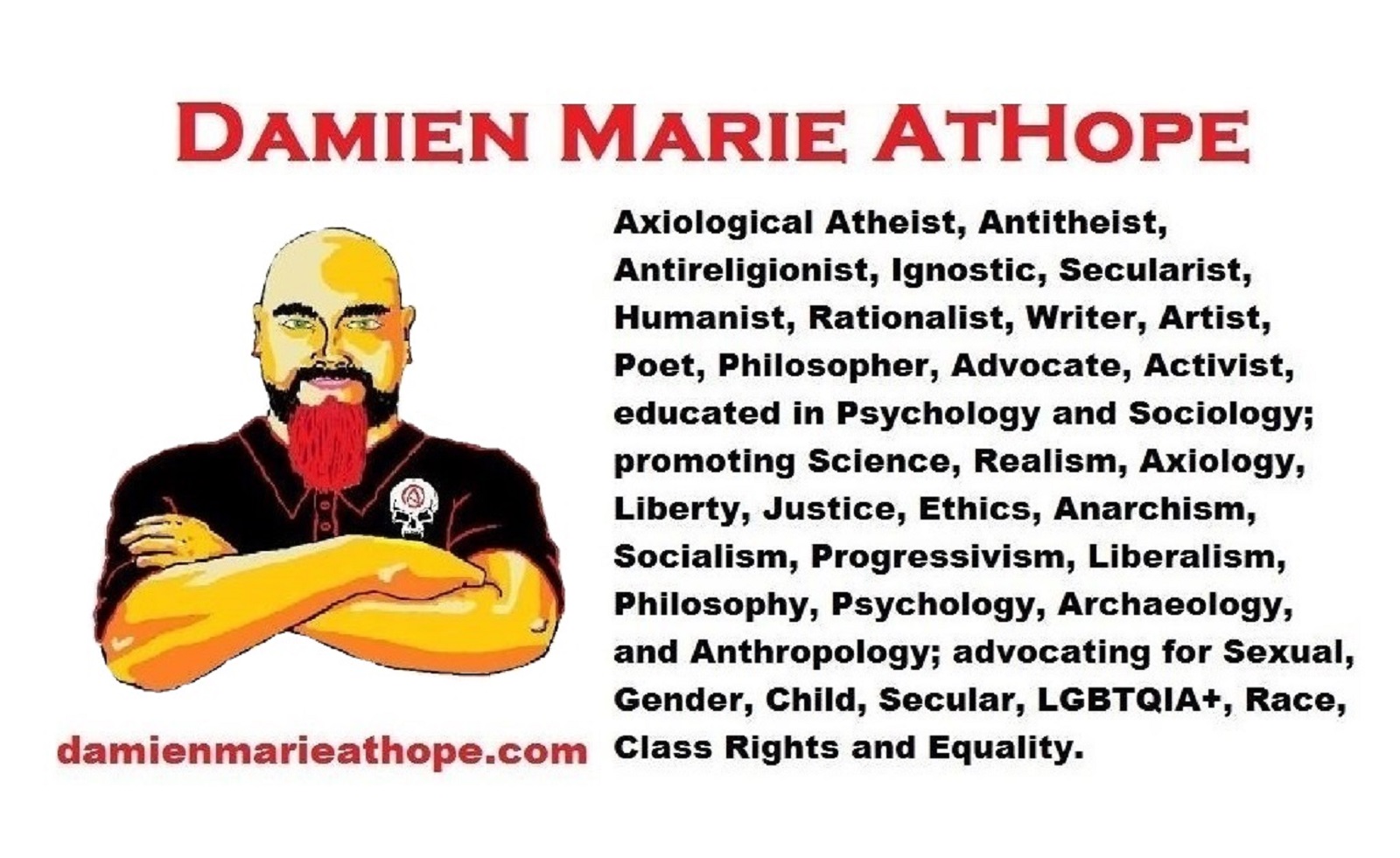
Damien Marie AtHope (Said as “At” “Hope”)/(Autodidact Polymath but not good at math):
Axiological Atheist, Anti-theist, Anti-religionist, Secular Humanist, Rationalist, Writer, Artist, Jeweler, Poet, “autodidact” Philosopher, schooled in Psychology, and “autodidact” Armchair Archaeology/Anthropology/Pre-Historian (Knowledgeable in the range of: 1 million to 5,000/4,000 years ago). I am an anarchist socialist politically. Reasons for or Types of Atheism
My Website, My Blog, & Short-writing or Quotes, My YouTube, Twitter: @AthopeMarie, and My Email: damien.marie.athope@gmail.com


